- Nepal Tours
- Nepal Travel Guide
- How Long to Stay in Nepal

Great Nepal Itineraries: How Many Days to Spend?

- 2.45K views
- ~ mins read
From jaw-dropping mountain vistas to brightly colored temples, a trip to Nepal brings together adventure and spirituality in a unique blend that you’ll be yearning to return again and again. Hike through the Himalayas and take a flight over Mount Everest one day and go on a steamy jungle safari in search of tigers the next. Want something a little different? Visit temples in the birthplace of the Buddha or go parasailing with an Egyptian hawk! With its stunning natural landscape and unique culture, these itineraries will help you decide how many days to spend in Nepal for your next trip.
- Palsang Sherpa
- From Swaziland
How much time should I spend in Nepal?
Nepal is not a big country, so you can certainly cover most of the sights in just a few days if you know how long you need to travel the many destinations on offer. Without trekking, you can travel from Kathmandu to Lumbini and catch all the great sights (and safaris!) in between in just one week. If you want to combine a short trek with a cultural immersion, this is definitely doable in ten days. The best Nepal itinerary will be two weeks, which gives you time to tackle some of the country’s famous trekking trails . If your goal is doing some of the more hardcore trekking, however, we recommend taking some extra time to fit it in. Three weeks will give you time to do the Everest Base Camp trek or finish one of Nepal’s other more grueling trails!
Nepal in a week
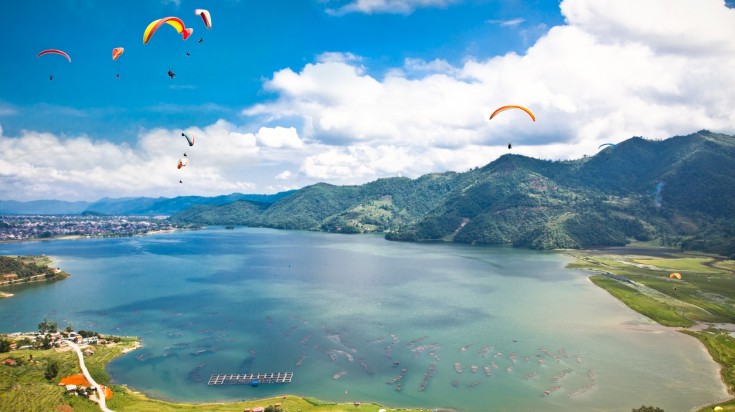
One week Nepal itineraries may be crunched for time, but don’t worry. You can fit plenty of fun into your trip if you know how long you want to stay in Nepal. Start your week with a guided tour of Kathmandu that will take you to the city’s most famous sites, like Hanuman Dhoka Square and the Pashupatinath Stupa! Opt outside for your next day with a hike around Nagarkot , offering a combination of unbelievable views of the Annapurna range and an intimate look at the daily life of local ethnic communities.
With only seven days in your Nepal travel itinerary, you don’t have time to trek all the way to Everest, but it would be a bummer to visit the country without seeing the world’s tallest mountain. You can book a morning flight to discover Everest, and the surrounding mountains, from above. Choose another nearby city to visit for a day trip before heading to Pokhara .
Kick off your trip to Pokhara with a whitewater rafting journey down the Trisuli river and spend your first full day in town sightseeing around the historic city, including an evening out in Pokhara’s remarkable nightlife. From parahawking (paragliding accompanied by an Egyptian Vulture) to rafting to ziplining, there’s an adventure activity for everyone waiting in Pokhara.
For our selected itinerary recommendations, check out our 7 days in Nepal guide.
Nepal in 10 days
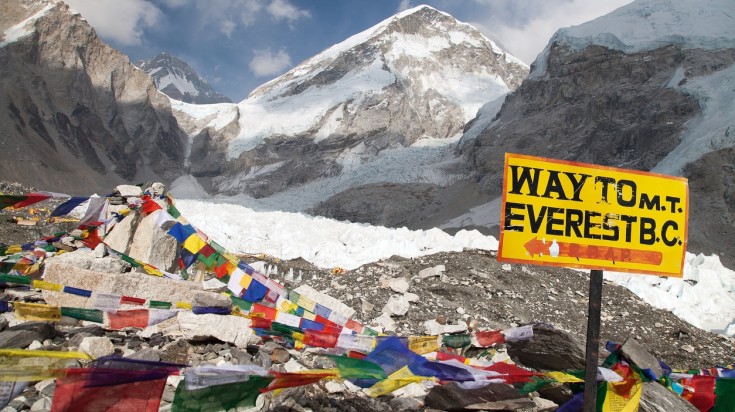
With ten days on your Nepal trip , you can see everything written above and add a couple of unique experiences along the way! Instead of going straight from Kathmandu to Pokhara, take a longer route and spend a night in the gorgeous town of Nagarkot, from which you’ll have some unforgettable sunset and sunrise views. The real gem of these Nepal itineraries is a trip to Chitwan National Park , where you can go on a safari to discover elephants, one-horned rhinos, crocodiles and even tigers in their natural habitat.
From Chitwan, head to the UNESCO World Heritage site of Lumbini and explore the birthplace of the Buddha. In Lumbini, you can explore some incredible historic sites, like the Maya Devi temple and the Ashok Pillar. Make sure to stop off at the World Peace Pagoda as well, with its huge white stupa. If you’re interested in Nepalese and Buddhist culture and history, Lumbini is a place you don’t want to miss. Once you’ve finished in Chitwan and Lumbini, head onwards to Pokhara and the last couple of days of your trip!
Alternatively, if you’re in town for the trekking, a dedicated hiker can complete Nepal’s most popular trek, the Annapurna Base Camp trek , or the Everest Base Camp trek, taking you all the way to the bottom of the world’s most famous mountain!
Our 10 days in Nepal guide recommends some great tours! For more ideas, check out all our 10-day itineraries in Nepal .
Nepal in 2 weeks

If your Nepal vacation has two full weeks, you can enjoy all of the country’s cultural and natural wonders and still fit in some time for Nepal’s biggest draw: trekking! Spend your first three days exploring Kathmandu, from its temples to the old towns. It’s easy to take domestic flights in Nepal, so hop on a plane and head to Pokhara to engage in some adrenaline pumping adventure activities.
You’ll spend the next three days on the Poonhill Trek , which is one of the easier treks into the Annapurna range. You’re in for an absolute treat in terms of stunning mountain views and you don’t even need to be super fit to make it through. Along the way, you’ll stay in rustic tea houses and enjoy delicious local foods. When you return to Pokhara, spend a day relaxing after your trek. Travel onwards to Chitwan for a safari. Get up early the next day to take a boat along the Rapti River before going on another safari, this time in the back of a jeep as you explore the jungle! Once you’ve got your fill of the wild (if that’s even possible!) catch a plane back to Kathmandu from Bharatpur.
If you want to spend your whole two weeks trekking, you have several options for stunning treks that can be completed in that time. Hike to the stunning Everest Base Camp or get off the beaten track with a two week trek along the Dhorpatan trail into Nepal’s Western Himalaya region. Whether you’re interested in pushing your body to the limit, photographing rare mountain views, or getting a little taste of Nepalese village life, there’s a two week trek with your name on it.
Access all our 2-week Nepal itineraries for more ideas.
Nepal in 3 weeks
Three week Nepal itineraries are designed with one main event in mind and that’s getting up into the Himalayas on a trek. With three weeks to plan for, you can start in Kathmandu and spend a couple of days exploring the city before heading to Pokhara. After a few days in Pokhara, you’ll be ready to set off on a trekking experience.

You can finish the Annapurna Circuit, Langtang , or the Everest Base Camp trek in two weeks, to name a few. While they’ll definitely put your body through the ringer, whatever trek you do will be well worth the effort. You’ll be rewarded with incredible alpine vistas, local hospitality, and an experience you’ll never forget. While this itinerary suggests spending only one week trekking, you can certainly adjust your trip to account for more (or less!) time spent traveling through the mountains.
From there, travel to Lumbini for two days to discover the temples in the Buddha’s birthplace, Chitwan for three days to enjoy a jungle safari. Those destinations are covered in more detail above. You’ll finish your trip with a three day stay in Nagarkot, where you can enjoy gorgeous Himalayan views in a town that feels like a completely different world.
Explore 3-week Nepal tours for inspiration.
Planning a trip to Nepal?
As there's so many things to do in Nepal , one could easily get overwhelmed with where to start. So get in touch with our local travel experts and develop a custom travel itinerary depending on how many days you want to spend in Nepal. If you’d like to book a package or join a group tour, check out our Nepal tours page for more ideas.
More information
5 days in Nepal
Related Articles
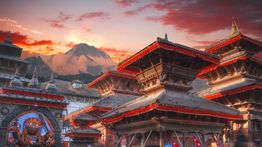
5 Days in Nepal: Top 3 Recommendations
Traveling to Nepal, but short on time? Don’t ... read more

7 Days in Nepal: Our Recommendations
Most travelers heading for Nepal plan a fortn... read more
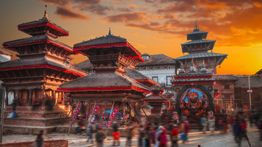
10 Days in Nepal: Our Recommendations
Those looking to spend 10 days in Nepal can s... read more
Related Categories
- How Long To Stay In Nepal
- Nepal Travel Advice
- Trekking In Nepal
- What To Do In Nepal
- When To Visit Nepal
- Where To Go In Nepal

Popular Destinations
- Europe Tours
- Everest Base Camp Trek
- Italy Tours
- Spain Tours
- Argentina Tours
- Canada Tours
- Sri Lanka Tours
- Chile Tours
- Antarctica Tours


Nepal Itinerary | How Many Days Should You Spend?
By Author Christian L.
Posted on Published: October 12, 2021 - Last updated: October 19, 2021
Categories Asia , Destinations , Nepal
With jaw-dropping vistas, Nepal’s diverse cultures, terrain, and ecosystems are unlike any other. You could easily spend several weeks exploring this picturesque country that lies on the southern slopes of the Himalayan mountains.
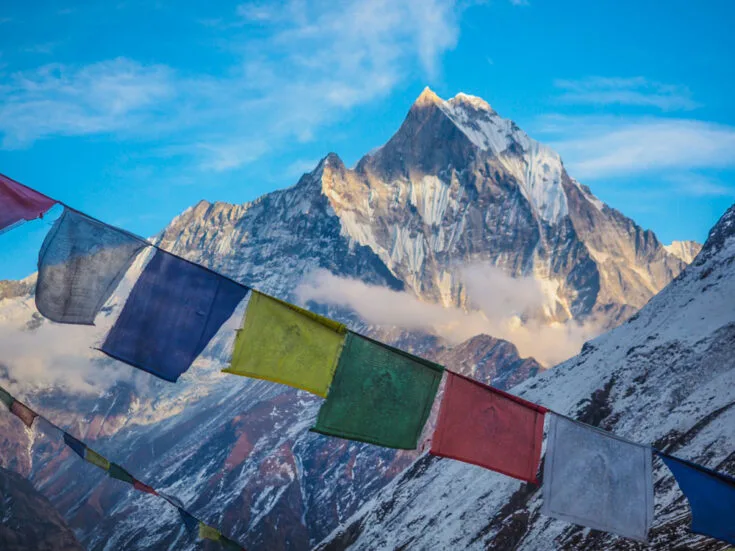
A vacation to Nepal requires three days minimum for the city and at least two weeks for those who are eager to explore the famous Nepal terrain. However, Nepal’s topography alone could make any first-time traveler feel a little intimidated and overwhelmed.
But, don’t let this scare you off. A trip to Nepal ties together adventure and spirituality so well that once you’ve experienced it – you’ll be yearning to return again and again. This guide will give you a Nepali tour itinerary, that isn’t too exhaustive. Traveling between cities may take a while (even the main roads in Nepal, is in poor conditions. This post will guide you with interesting activities between locations.
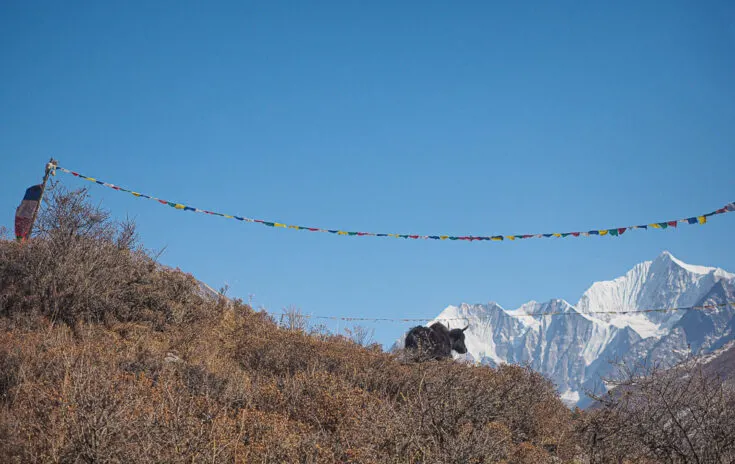
Nepal: Days To Plan
In just three days, travelers can see the best of Kathmandu , Nepal’s capital city. And to the disbelief of some, this is the perfect number of days to come away with an appreciation of the rich culture and heritage of the ancient city.
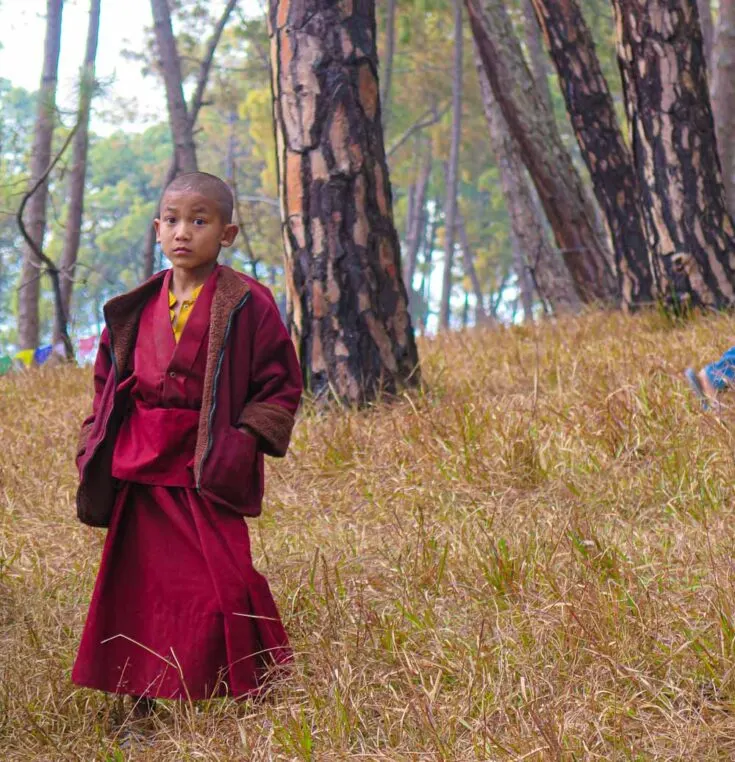
But for others, three days isn’t enough to see ‘ the real Nepal’. The real reason to visit Nepal lies outside the busy, congested city. These areas of Nepal, are located in the hills, mountains, rivers, lush farmland, forests, and jungles. To experience these natural attractions, a three-day trip will enable you to go on a short trek, river trip, or visit the small towns that surround Kathmandu.
Two weeks in Nepal will allow for a longer trek, a trip to a national park for wildlife spotting, or a mixed cultural Nepal day tour. To really experience the best of Nepal, plan for three to four weeks; this is enough time to complete an ambitious hike. The remote and under-visited Makalu Base Camp or Arun Valley hikes are some of Nepal’s best-kept secrets, together with Rara Lake, the largest lake in Nepal , which is rarely visited by tourists.
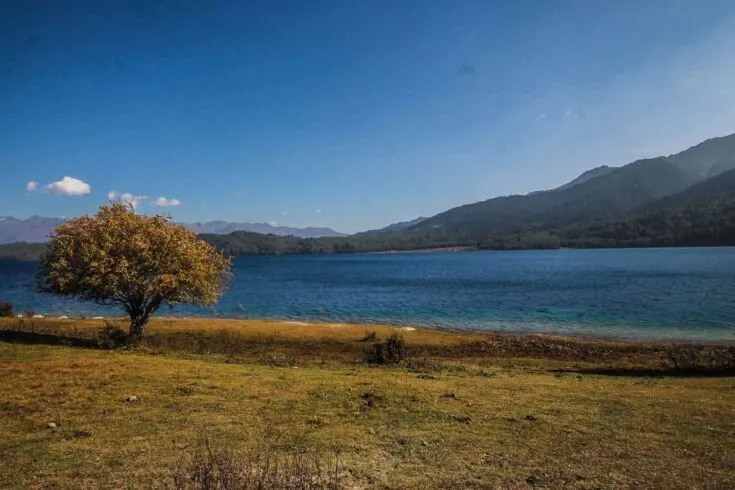
If you have some time left to spare, make sure you experience the jungle and other adventure activities such as rafting. Here are some suggested itineraries, from three days to three weeks.
Three Days in Nepal
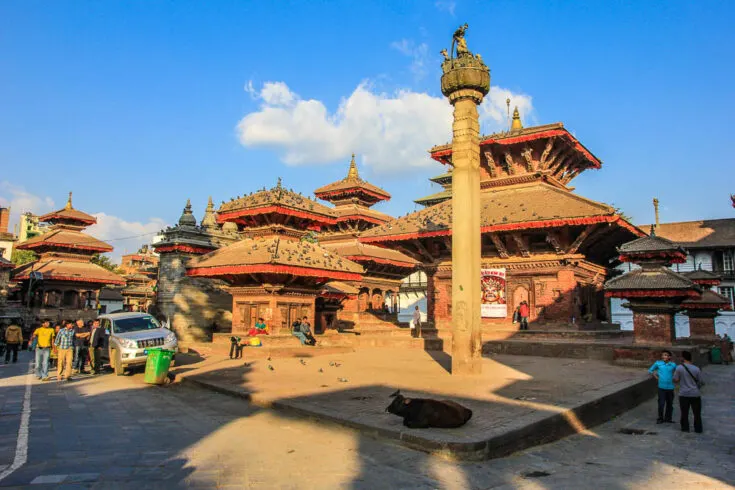
An under one week Nepal itinerary may be a crunch for time, but it’s definitely possible. Start your week with a guided tour of Kathmandu that will take you to the city’s most famous sites. Some things to see in Nepal, Kathmandu are Durbar Square and the holy places like Boudhanath/Bouddha, Pashupatinath temple complex, and the MonkeyTemple / Swayambhunath, which has an incredible 360 panoramic view over Kathmandu.
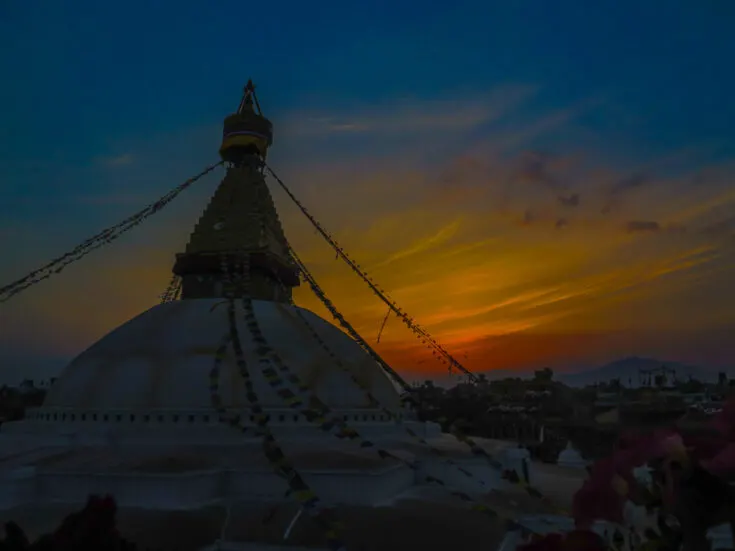
Spend a day hiking around the central village of Nepal, Nagarkot . This offers a combination of unbelievable views of the Annapurna Range and an intimate look at the daily life of the locals and their communities.
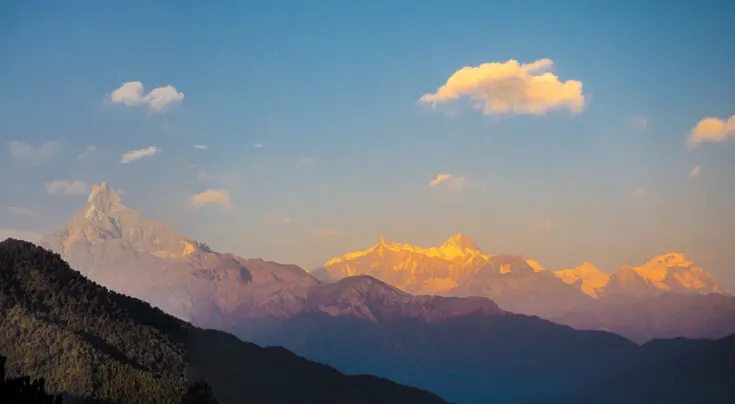
With only three days in your Nepal travel itinerary, unfortunately, you won’t have time to hike all the way up to the famous Everest. But even if you don’t get to climb the monolith, it would be a waste not to see the world’s tallest mountain. So, if you can, be sure to book a flight to Everest , and discover the mountain and all its glory, from above.
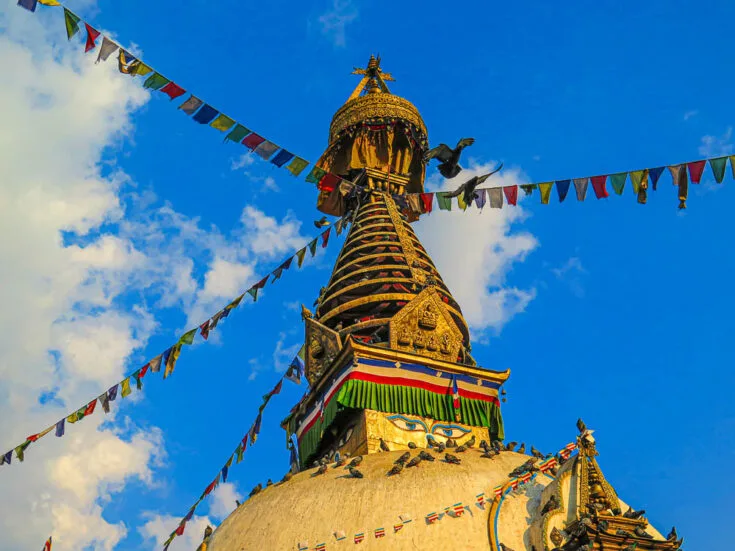
You can also kick off your trip to Pokhara with a shot of adrenaline and go whitewater rafting down the Trishuli River . Perhaps, spend your first full day in town sightseeing around the historic city, including an evening out in Pokhara’s remarkable nightlife.
Nepal Itinerary for 10 Days
With ten days on your Nepal trip, you can see everything that a one-week traveler can, plus a couple more unique experiences added to the list. Instead of going straight from Kathmandu to Pokhara , take the scenic route and spend a night in the gorgeous village of Nagarkot. Here, you will be grateful to witness some unforgettable sunsets and sunrises.
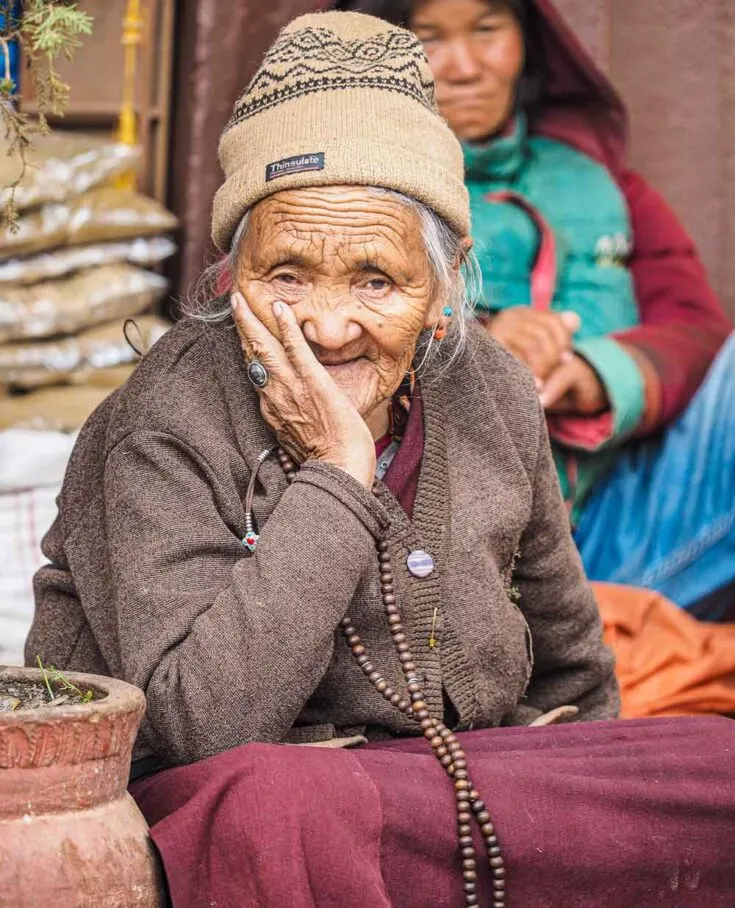
Head to the UNESCO World Heritage site of Lumbini and explore the birthplace of the Buddha. In Lumbini, you can explore some incredible historical sites, like the Maya Devi Temple and the Ashok Pillar. If you’re interested in Nepalese Buddhist culture and history, Lumbini is a place you don’t want to miss.
Alternatively, if you’re in town for trekking, a dedicated hiker can complete Nepal’s most popular trek, the Annapurna Base Camp trek . You will achieve the maximum altitude of 4130 (13,550ft) at Annapurna Base Camp. Or try the Everest Base Camp trek.
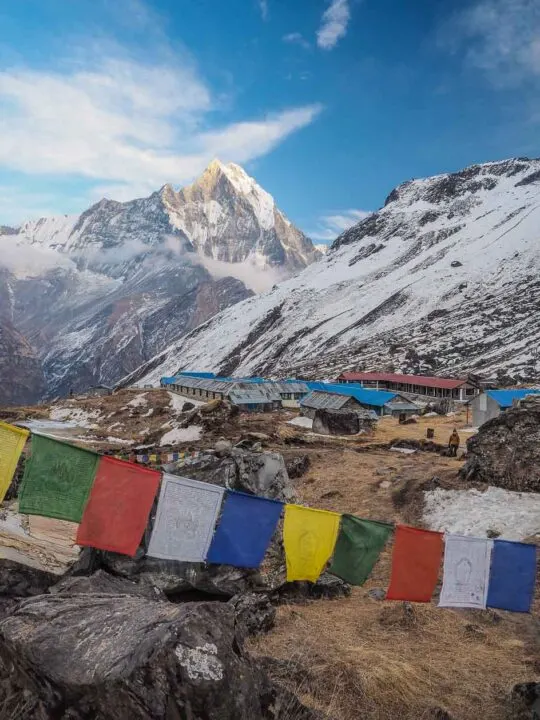
Places to Go in Nepal in Two Weeks
If your Nepal vacation has two full weeks, you can enjoy all of Nepal’s cultural and natural wonders and still fit in some time for Nepal’s biggest attraction and activity – trekking. You can spend your first three days exploring Kathmandu, from its temples to the surrounding old towns.
Traveling from city to city in Nepal can be long, but it’s easy to take domestic flights in Nepal. So, hop on a plane and head to the city of Pokhara to engage in some adrenaline-pumping adventure activities.
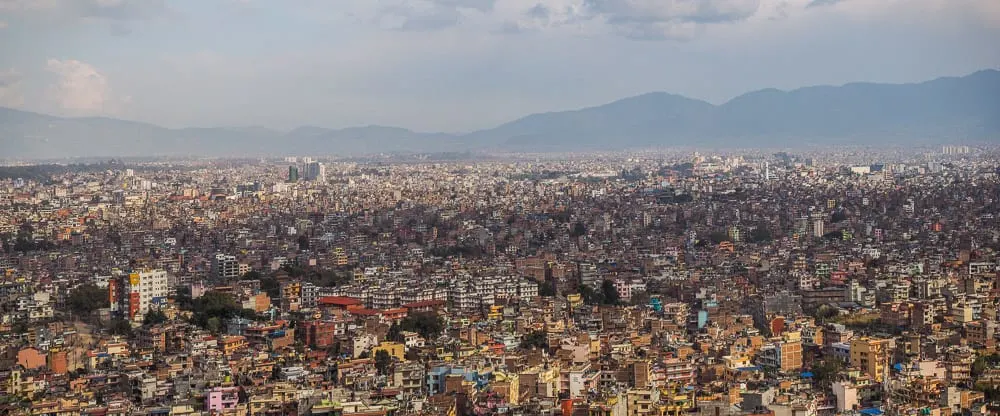
You might’ve heard through the grapevine, some unfavorable things about Kathmandu. Namely that the city is overcrowded, but there are enough places to get away from the hustle and bustle if you know where to go. Although that part is true, the wealth of the main attractions of Kathmandu outweighs the rumblings of the rumor mill. However, in order to really navigate this city’s method of madness, it would be best to keep sightseeing in Kathmandu for a longer stay. Kathmandu has seen a lot of development since the devastating 2015 earthquake, now more and more big international hotel chains, shops, and fast-food chains are opening around Kathmandu.
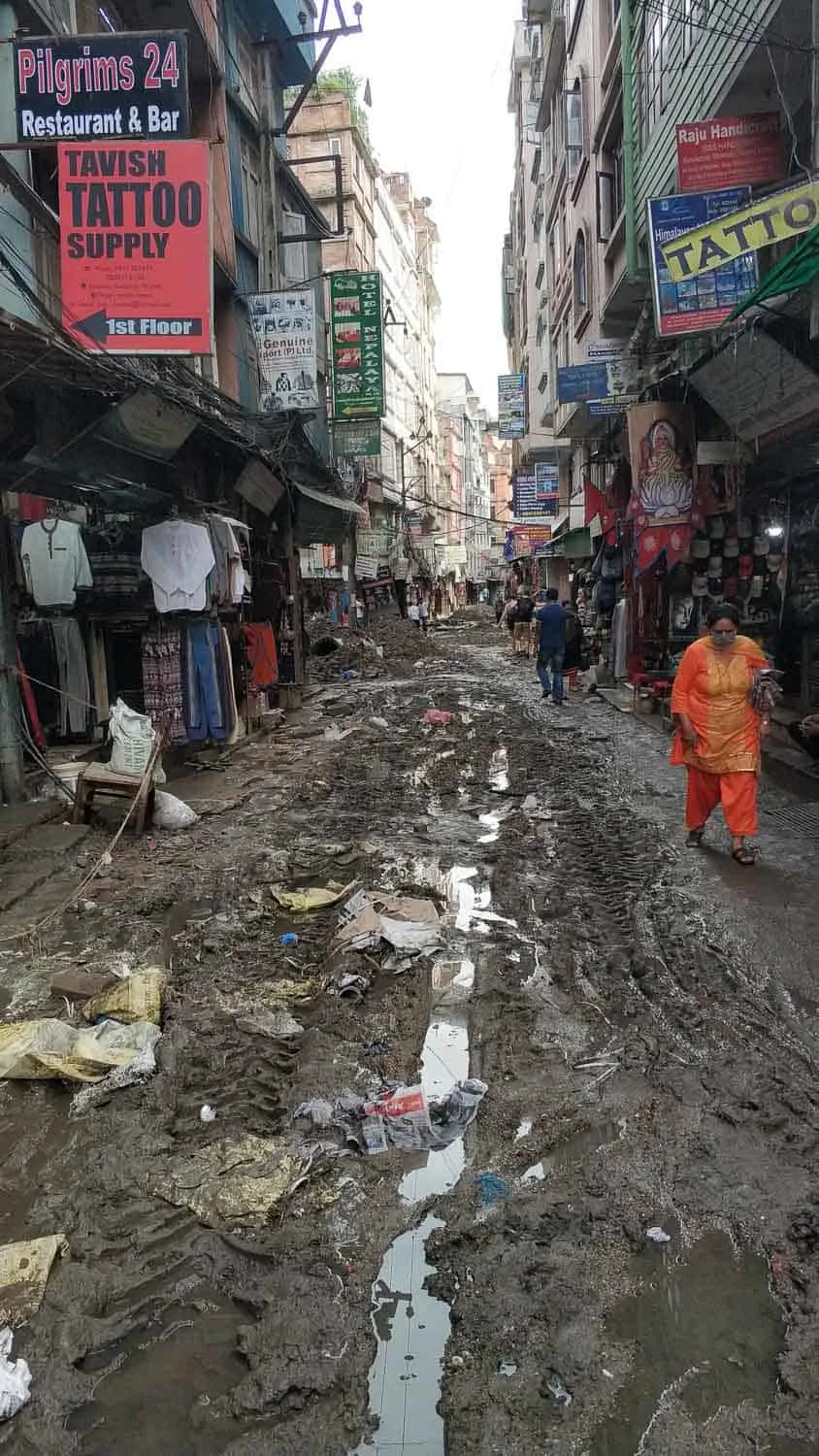
Pokhara is loved by many, and once you’ve made your way to this city, you’ll understand why. The Nepalese people, particularly the Kathmandu-dwellers, enjoy the clean air of Pokhara and the shores of Phewa Tal are where the city’s beauty really shines. From parahawking (paragliding accompanied by an Egyptian Vulture) to rafting, to ziplining, there’s an adventure activity for everyone in Pokhara.
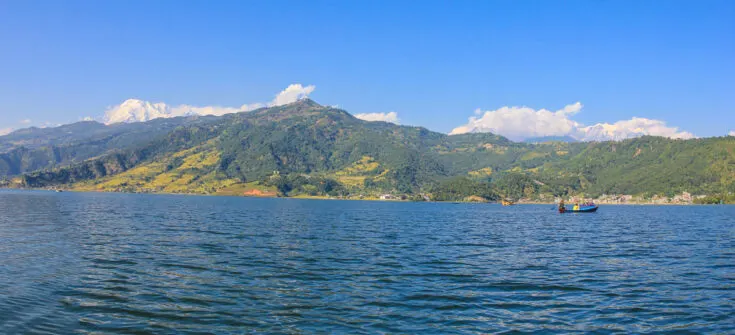
If you’re a yogi or enjoy a guided meditation every now and then, the appeal of Pokhara is seeing other yogis (and tourists) do yoga on the beach. Alternatively, Pokhara is where you’ll be able to hike up the World Peace Stupa .
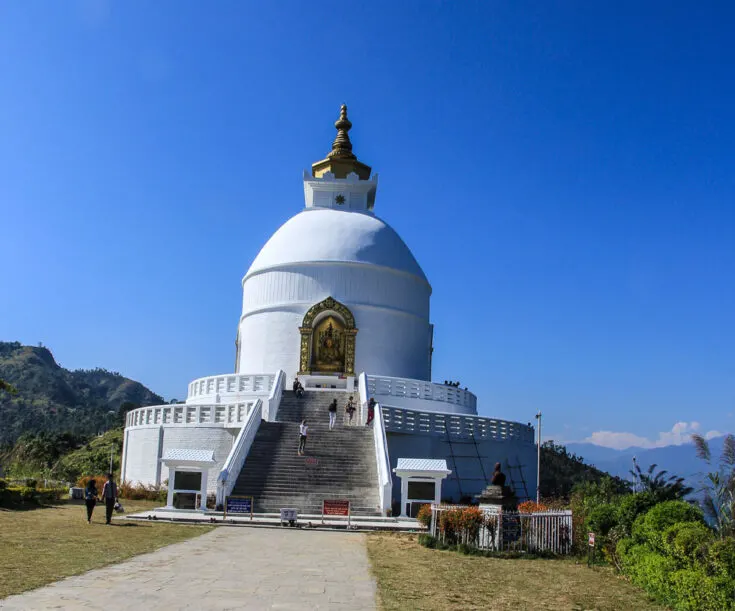
Unless you plan to trek the nearby Annapurna Himalaya Range, no more than two or three days would suffice in the city of Pokhara, Nepal. But often people stay longer, while it´s not much to do in Pokhara so is the city a perfect place to relax and forget about time.
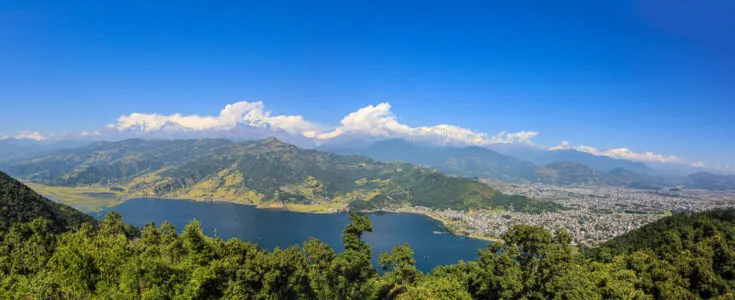
Chitwan National Park
If you’re in Nepal around their Autumn season (September to November), consider hiking the thick, complex Nepal jungle – the Chitwan National Park . This preserved area occupies Nepal’s lowlands near the border of India. These months are prime for trekking, since the high grasses that cover the jungle most of the year is shorter, offering you the best chance at seeing the rare tigers that live inside the park.
Even if you’re not planning to make your way to Nepal during peak season, Chitwan National Park is still very much worth the visit, irrespective of when you arrive. You will get to go on a safari to discover elephants, one-horned rhinos, crocodiles, and even deers in their natural habitat throughout the year.
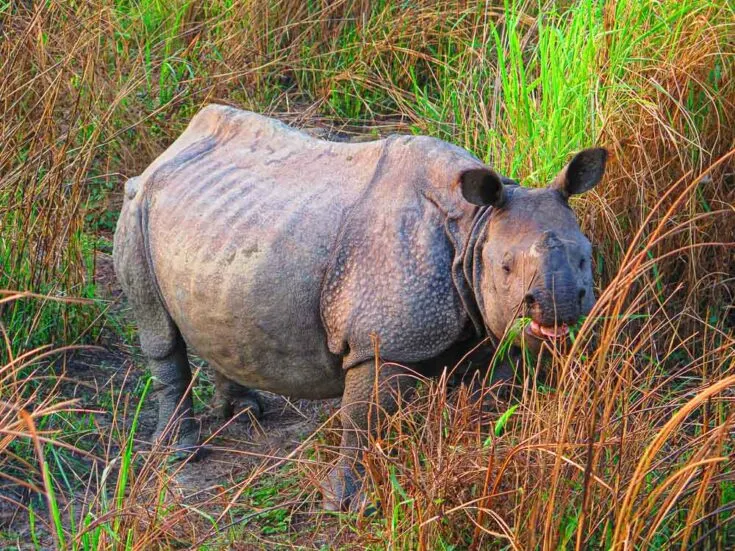
Realistically, you need not spend more than two or three days of your two weeks in Chitwan. However, you’ll need to devote more time to the park if you take a bus ride from Pokhara or Kathmandu. A more expensive (but less stressful) way to visit the park is by flying to Bharatpur.
The Poonhill Trek
Why not spend the next few days left on your two-week itinerary on the Poonhill Trek ? This is one of the easier hikes to do into the Annapurna Range. You won’t regret one minute of this Nepal adventure. All the stunning mountain views are sure to leave you speechless. Not to mention, you don’t even need to be super fit to make it through the Poonhill Trek.
Along the way, you’ll get to stay in rustic tea houses and enjoy delicious local foods. Once you return to the city, spend a day resting those muscles and relaxing after your trek.
Dhorpatan Trail
If you want to spend your whole two weeks trekking, Nepal really does have several options for stunning treks that can be completed in that time.
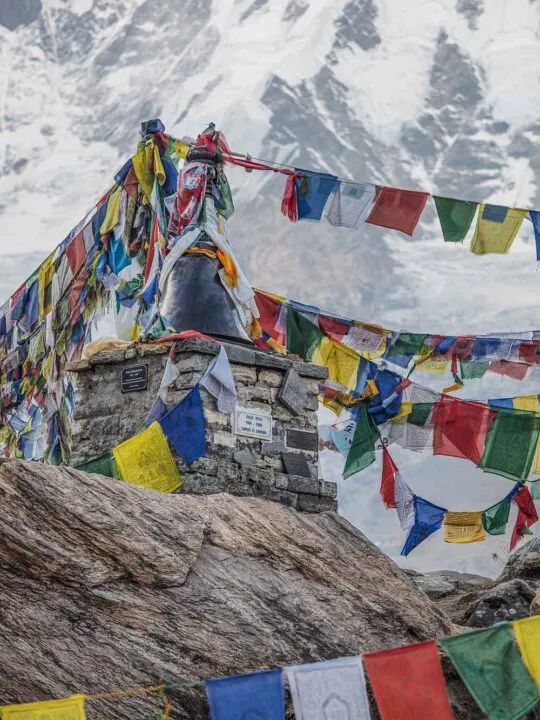
Hike off the beaten track with a two-week trek along the Dhorpatan Trail into Nepal’s Western Himalaya region. Whether you’re interested in pushing your body to the limit, photographing rare mountain views, or getting a little taste of the Nepalese village life, there’s a two-week trek available with your name on it.
Rapti River
Get up early and take a boat along the Rapti River . The east Rapti River is a part of Chitwan National Park, and it is one of the most popular tourist attractions for a canoe or boat ride. Flowing from east to west, it forms the northern border of the Chitwan National Park and also joins the Narayani River inside the protected area.
Nepal in Three Weeks
A three-week Nepal itinerary should be designed with one goal or event in mind, and that’s getting up into the Himalayas on a trek. And why not? With three weeks to plan for, you can start in Kathmandu and spend a couple of days exploring the city before heading to another, such as Pokhara. And after a few days there, you’ll be more than ready to set off on a trekking experience, you’ll never forget.
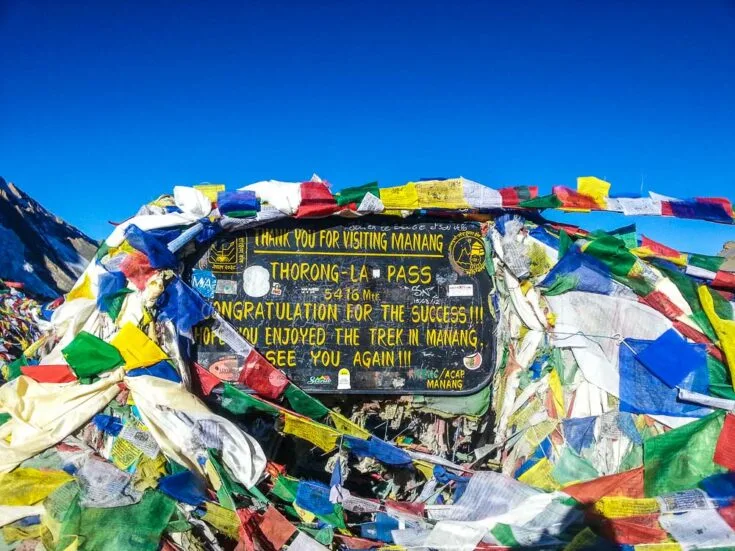
You can finish the Annapurna Circuit, Langtang , or the Everest Base Camp trek in two weeks, to name a few. While these treks require a certain skill set and level of physical fitness, whatever trek you do will be well worth the effort. You’ll be rewarded with incredible alpine vistas and incredible local hospitality.
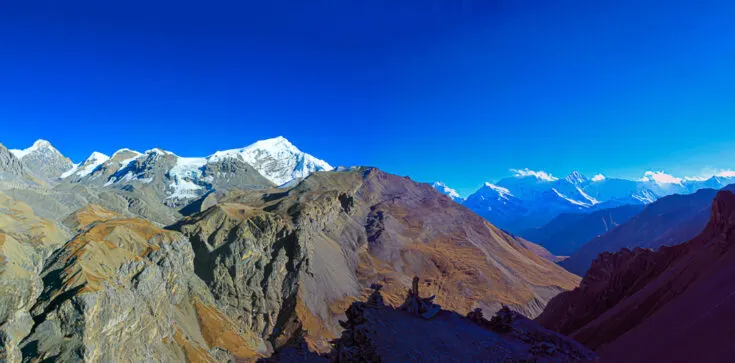
After these treks, you might want to travel to Lumbini for a day or two to discover the temples in the Buddha’s birthplace, or explore Chitwan for three days to enjoy a jungle safari. Those destinations are covered in more detail above.
Finish your trip strong with a three-day stay in Nagarkot, where you can enjoy gorgeous Himalayan views in a village that feels like a world of its own.
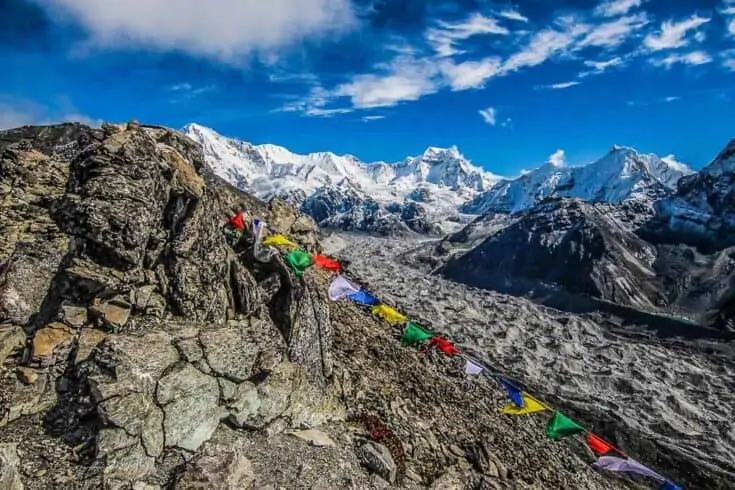
So, How Many Days Do You Need Exactly?
To be honest, there is no magic number. It’s up to you to decide what works for you. Nepal is not a big country, so you can certainly cover most of the sights in just a few days.
Without trekking, you can travel from Kathmandu to Lumbini and catch all the great sights in just one week. If you want to combine a short trek with a little bit of cultural or historical integration, then definitely round up to the double digits.
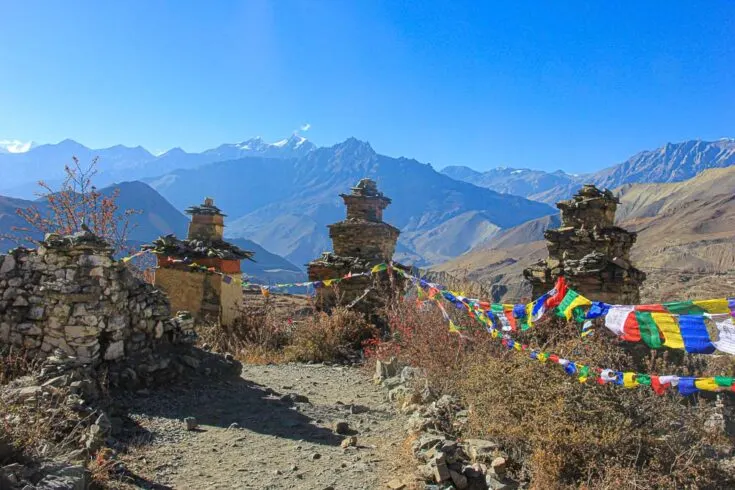
But the most popular option taken by Nepal hiking aficionados is the 10-day itinerary. This gives you the perfect amount of time to tackle some of the country’s famous trekking trails.
Tips for Efficiency
Be mindful of road travel in Nepal. It tends to be slow, as roads are either through hills, mountainous terrain, or are just in poor condition – it’s usually both. Also, bear in mind that not all points of interest or trailheads have a nearby airport. But it will always save time to fly where possible.
Most airports in Nepal, however, are, in fact, small airstrips. So, flights are often delayed or canceled when the weather is bad. For these reasons, it is important not to pile too much onto your Nepal travel schedule, or you might miss an important date.
So, How Many Days Should You Spend in Nepal?
Whatever plan you choose to follow or use as a starting point, Nepal is one place to consider for your bucket list.
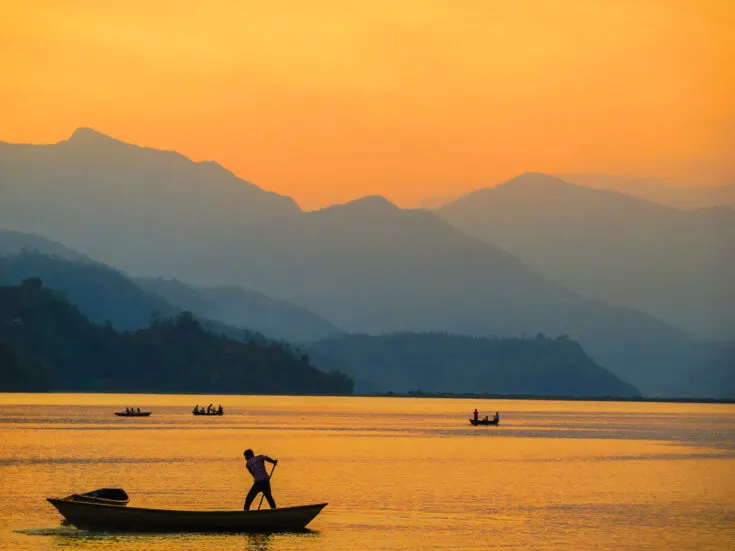
This beautiful country is loved by trekkers and mountain enthusiasts everywhere, eager to plan a trip. But even if you have come to simply spot some wildlife in the Nepal jungle, meditate at the many temples, or sip tea in the hills – Nepal provides it all. It may be hard to get there, but you’ll soon find out that it’s even harder to leave.
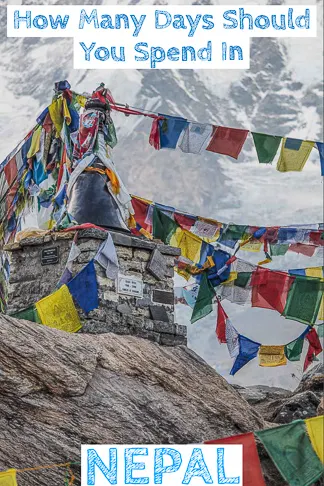

- 2 Weeks for Couple
- 2 Weeks for Family
- Thailand Lantern Festival
- Indonesia(Bali)
- South Korea
- China (HK, Taiwan)
- Itinerary Ideas
- Asia Highlights Travel Reviews
- Thailand Travel Reviews
- Vietnam Travel Reviews
- Cambodia Travel Reviews
- Japan Travel Reviews
- Myanmar Travel Reviews
- China Travel Reviews

Best Times to Visit Nepal —Guide to Nepal Weather and Travel Experience
Quick facts.
- When Is the Best Time to Visit Nepal
Visiting Nepal in Spring — from March to May
Visiting nepal in summer — from june to august, visiting nepal in autumn — from september to november, visiting nepal in winter — from december to february.
From March 14, 2022, Nepal has eased its entry requirements. All international visitors can go to Nepal whether you are vaccinated or not .
Nepal has distinct climates related to its elevations with its subtropical jungle in the south and the world's highest peaks in the north. We suggest you also learn about the seasonal variations before going there so that you can choose the optimum time to visit.
Nepal's climate is divided into two seasons: the rainy season (May to August) and the dry season (September to April). October to December is the best time to visit Nepal as the skies are generally clear and the views are spectacular. However, the best time to visit Nepal depends on what you plan to do while in the country.
- The ideal time to visit Kathmandu is from September to November when numerous cultural events are held.
- Late September to early December is the best time for photography in Nepal.
- October to April is the best time to see wildlife. Chitwan National Park is one of the most famous national parks in Nepal.
- The best time to visit Pokhara is September to November.
- The autumn months (October and November) are the most popular for trekking to Everest Base Camp.
When Is the Best Time to Visit Nepal?
The best time to visit Nepal is from October to December as the weather is stunning during this period. The average temperature is 22℃ (72°F) by day and 12℃ (54°F) at night.
Trekking, jungle safaris, and outdoor activities are all enjoyable during this period. Dashain is the most auspicious festival in October. Domestic flights are in high demand during the lead-up to it so it is advised to book your tour as early as possible.
March and April are also good times to visit Nepal as the weather gets warmer and the plants come alive with new growth. Most parts of Nepal are hot in these months. Kathmandu and Pokhara can reach 28℃ (82°F). The average temperature is 25℃ (77°F) by day and 10℃ (50°F) at night.
Trekking is ideal during this period, including the route to Everest Base Camp. Many hotels charge a peak season rate. The Holi festival falls in March and is a great opportunity for photos. Domestic flights between Kathmandu and Pokhara can fill up quickly.
January and February are recommended after the months mentioned above. It can be very cold, especially at night. The average temperature is 18℃ (64°F) by day and 2℃ (36°F) at night.
Enjoy viewing the snowcapped mountains. It's a good time to look at the wildlife in the jungles of Chitwan in the south of Nepal as these lowlands experience moderate temperatures. The Losar and Basant Panchami festivals are often, but not always, held in January. Many hotels offer special winter rates. This is a good time for travelers who are looking for deals.
The monsoon season is from May to September . Heat and humidity levels increase and the clouds make the mountain views seem mysterious. Some travelers don't enjoy this time in Nepal but it doesn't mean you can't travel during this period. The average temperature is 29℃ (84°F) by day and 18℃ (64°F) at night.
City sightseeing is interesting at this time. Getaways to Pokhara, Kathmandu, and the surrounding regions are welcome possibilities. During these months, you are likely to find discounts on accommodation and tours.
Here are the average temperatures and rainfall amounts for Nepal:
Discover real reviews of Highlights Travel Family 's best-rated service across trusted platforms.
Spring is one of the most popular seasons to visit Nepal as temperatures climb steadily and the weather tends to be more stable. The valleys are fabulously beautiful, especially after all the ice has thawed and the flowers have bloomed. This is a great time to go trekking in Nepal.
Spring Weather
March: Temperatures on the Terai can be above 32°C (90°F) while Kathmandu and Pokhara can reach 26°C (79°F). Areas at high altitude are still cold, especially at night.
April: Most parts of Nepal are pretty hot. Kathmandu and Pokhara have temperatures reaching 32°C (90°F). The Terai can often be hot.
May: It is very hot in hillside cities – usually above 32°C (90°F) in the daytime – and even hotter on the Terai.
What to See
Spring is a peak season for trekking. Cross high passes, such as the Annapurna Circuit (ABC), which is located in the middle section of the Himalayas. This is the most popular trekking tour in Nepal. Starting at Nayapul, just a short drive from Pokhara, the standard route requires 10–11 days to reach Annapurna Base Camp and return to Pokhara.
During the tour, you will see fantastic glaciers and the peak of Hiunchuli.
This trek is not difficult and any fit person can manage it, even if you do not have any hiking experience.
Th e Everest Base Camp Trek (EBC) is consistently regarded as the finest in the world and is suitable for most trekkers with a medium level of fitness. The adventurous trek begins with a half-hour flight from Kathmandu to Lukla, which offers the best views of the Himalayas.
Start there and go through dense green forests to reach Everest Base Camp. It takes about 12 days to return to Lukla.
During the trek, you'll visit mountain villages and have the chance to visit some of the most renowned monasteries in the country, such as Tengboche Monastery.
Festivals and Events
- Holi : This an exciting festival of color celebrated in Kathmandu in early March. People smear colored powder on each other and throw colored water and water balloons — it's a great opportunity for photos.
- Bisket Jatra : This is Nepali New Year, which is a major holiday in Nepal. Celebrations take place at Bhaktapur in Kathmandu and children offer sweets, fruits, and gifts to their mothers to show their respect and gratitude.
What to Avoid
- Kathmandu is particularly dusty in March because it's the time for crop burn-offs. It's best to head out of the city.
- To avoid the crowds, choose a lesser-known trek or visit in early/late spring.
- Mountain views can be obstructed by haze and low clouds.
Insider Tips
- It is recommended to wear pants, T-shirts, and breathable clothes.
- In the evenings, wear suits, jackets, a windbreaker, and other warm clothes.
- Domestic flights to popular destinations, especially between Kathmandu and Pokhara, can fill up quickly. Early booking is suggested.
- The Holi festival takes place across many cities and smaller towns in March so it's very crowded.
The arrival of the monsoon season sees fewer tourists in Nepal, especially in July, making it the least visited month of the year. The weather is hot and humid and it tends to rain on most days.
Although July is not an ideal month for many outdoor activities, traveling in the city is a good idea, such as visiting temples, museums, bars and restaurants, and shops. Kathmandu and Pokhara are the best places to go in summer.
This season has great deals, which is ideal when traveling on a budget.
Summer Weather
June: The monsoon season sweeps up from India.
July: The monsoon season has truly arrived. Temperatures stay over 26°C (79°F) in Kathmandu and Pokhara. High-altitude areas are somewhat cooler but with heavy rainfall.
August: This is the final full monsoon month so temperatures remain hot and humid around the country.
It is the perfect time to discover Kathmandu's historical heritage without the crowds. The Pashupatinath Temple is a must-see attraction. It is one of the representative Hindu temples in Kathmandu,and is where Hindus hold open-air cremations.
You can visit the world's largest round pagoda in Kathmandu: Boudhanath . It was founded in the 6th century and was the center of Tibetan Buddhism in Nepal. It has one of the largest spherical stupas in Nepal.
Kathmandu Durbar Square is the most famous square in Kathmandu and a good place to see marvelous temples. There are more than 50 temples in the square — the whole scene is like an open-air museum filled with ancient architecture.
Pokhara is divided into two parts: the old part and the modern part. It is recommended to visit the old part because it is the same as it was before the development of tourism. Old houses are everywhere and the shops and stalls are full of local life. You can experience the locals' simple, slow pace of life.
In Pokhara, you can enjoy the stunning view of the beautiful Fewa Lake from a lakeside café.
If trekking is your main purpose in Nepal, the Mustang Trek to the north of Pokhara is a better choice in the monsoon season. It lies within the rain shadow of the Himalayas so it doesn't experience the monsoon-like weather that falls on the rest of the country.
- Rato Machchhendranath : Celebrations are held all over Nepal for the August full moon, especially in Patan in Kathmandu, which includes dancing with shamans. Thousands of devotees gather in Kathmandu Durbar Square.
- It's not a good time for epic mountain views and photography.
- It's not a good time for treks because the monsoon weather makes overland travel difficult. With wet weather, landslides, and muddy or flooded roads, many mountain regions become inaccessible.
- It is not advised to arrange a tight schedule as there is a larger possibility of flight delays and cancelations.
- Long pants and long-sleeved shirts are suggested to protect you from leeches in some areas.
- Take an umbrella as the weather is usually too warm to wear a rain jacket.
- With flight delays and cancelations, check your flights before you venture out.
- Visit the Pashupatinath Temple in the morning to see cremations or visit in the evening from 6pm to see the aarti (worship with fire).
The monsoon rains last until mid-September but it only rains every few days. The sky generally remains clear with fresh air, providing amazing views all around, making October and November lovely times to visit Nepal.
This is the most popular season for trekking in the Himalayas and provides you with opportunities to join in with various festivals.
Autumn Weather
September: The humidity subsides by late September. Temperatures reach 20°C (68°F) and 26°C (79°F) in Kathmandu and Pokhara but is higher on the Terai. Mountainous areas, as always, are cooler.
October: It rains occasionally but not very much. Temperatures in Kathmandu and Pokhara seem comfortable with a high of 20°C (68°F) and a low of 26°C (79°F). The Terai is still a little bit hotter.
November: It is quite warm in many parts of Nepal although temperatures can be cold at night. Daytime temperatures are in the low 20°C (68°F) in Kathmandu and Pokhara. Temperatures become more comfortable in the Terai.
As well as the Annapurna Base Camp and Everest Base Camp treks, which are popular in spring and autumn, the Langtang Valley trek is recommended. It is 62 kilometers north of Kathmandu. The Langtang Valley is the third of the great trekking areas in Nepal after the two treks mentioned above.
Starting at Syapru Besi, an 8 to 9-hour drive from Kathmandu, the moderately difficult trek can be done within a week.
During this cultural trek, you will see several ancient Buddhist monasteries, beautiful valleys, and majestic views of mountains and will pass through local villages where there will be a good chance to interact with the local Tamang people.
- Dashain : which always falls in late October, is the most important festival for Nepali Hindus. It is a celebration of good prevailing over evil. Local people gift goats, ducks, chickens, eggs, and coconuts to the goddess Durga. People return to their hometowns and stay with their families during the 15-day holiday.
- Tihar : is Nepal's second most important festival. It is normally held in mid-November. The celebrations last for 3 days. Local people light up their houses with oil lamps and candles. From the highland, you can see the beautiful scenery of the whole of Kathmandu.
- Chhath : is the most important festival observed in the Terai region and it falls on the seventh day after Tihar. Devotees fast and make offerings to the sun by gathering at riverbanks. The best place to experience the festival is in central Kathmandu.
- If you prefer to avoid crowds, don't travel during Dashain.
- Popular trekking trails are crowded — please get advice from your travel consultant to select the best trail.
- There are higher costs due to the higher demand during this peak time.
- In the daytime, a light jacket or cardigan is advisable in case it gets cold. You can also buy beautiful pashmina scarves everywhere to help keep you warm by covering your shoulders.
- At night, a warm jacket is suggested. If you are trekking, please take hiking shoes and casual clothes.
- Book your domestic flights as early as possible. If traveling during Dashain, flights fill up very quickly in the lead-up to the festival.
- If you wish to get some trekking tips, please ask your travel consultant.
Winter isn't the peak season but there are still clear, sunny skies and mild temperatures in many places. There is practically no rain throughout the country during this season. The pleasant aspect of traveling in this season is that there are fewer visitors.
Winter Weather
December: The skies are clear. In Kathmandu, average temperatures reach highs of 20°C (68°F) and lows of 4°C (39°F). Fog is common in the Terai. Daytime temperatures reach as high as 28°C (82°F) in Chitwan. Trekking trails in the Himalayas are much colder.
January: This is the coldest month of the year. In Kathmandu, daytime highs can reach 18°C (64°F). Pokhara stays a bit warmer than Kathmandu. Daily temperatures in Chitwan can still be as high as 25°C (77°F). Snowfall in the Himalayas makes trekking trails much harder.
February: The climate varies in this month. In Kathmandu, the average high is 20°C (68°F) with Pokhara being a few degrees warmer. The Terai can be very hot with temperatures reaching as high as 32°C (90°F).
If you are an adventurer who wishes to experience the harsh Himalayan winter, see the above-mentioned hiking trails without any crowds.
This is the best time for spotting wildlife in Chitwan National Park. It is unique for its wildlife safaris, bird watching, and tiger tracking activities in Nepal. The elephant safari there should not be missed!
The jeep safari is another popular program that you can enjoy during your stay in Chitwan. Compared to other safaris around the globe, Chitwan National Park has a wide range of wild animals.
Winter is also a great time to relax in Kathmandu. For example, you can sit in a café in Thamel and enjoy a glass of Nepali tea or a cup of Nepalese coffee.
Spending a few days in Bandipur is a good idea in the cold season. This is a unique, charming town with traditional wooden architecture, markets, and temple trails. It is about 5 hours' drive from Kathmandu.
If you enjoy hiking, it's also a good time for short treks in the Kathmandu Valley and a Nagarkot sunrise trek. Near Kathmandu, this is one of the best destinations for a short trek. It is considered a popular place for a sunrise view of the Himalayas. The trek can be done in one day.
- Losar : is the first day of the new year and is celebrated by Nepalese minority people. The best place to experience Losar is to seek out a Tibetan monastery in Kathmandu. The minority people will wear traditional dress for Losar.
- Trekking in the high mountainous areas can be risky.
- It is not advised to reach higher elevations due to the occasional snowfall.
- A down jacket is recommended as it can still be fairly warm during the day, even in winter.
- As it is the off-season period, you don't have to book too far in advance.
Explore Nepal with Asia Highlights
Nepal isn't easy to travel around without the help of English-speaking guides. We will be happy to provide you with worry-free tours.
Our professional travel consultants will help you select the destinations, flights, accommodation, and best things to do. Check out the following links learn more about our tours and submit your tour inquiry.
Why Asia Highlights (10,000+ reviews & 98.8% 5-star rating)
- Save Your Time:
- Less research, more enjoyment!
- Real-time 1V1 expert planning
- Maximize Your Flexibility:
- Personal local guide and ride
- Explore at your own pace
- Celebrate Your Journeys:
- Specially-crafted family adventures
- Celebrate milestones with style!
Get Inspired with Some Popular Itineraries
At Asia Highlights, we create your kind of journey — your dates, your destinations, at your pace. You can have any trip tailor made for your travel.
More Travel Ideas and Inspiration
Sign up to our newsletter.
Be the first to receive exciting updates, exclusive promotions, and valuable travel tips from our team of experts.
Why Asia Highlights
Where can we take you today.
- Middle East
- African Safari
- Travel Agents
- Loyalty Program
- Our Differences
- Privacy Policy
Address: Building 6, Chuangyi Business Park, 70 Qilidian Road, Guilin, Guangxi, 541004, China
Best Time to Visit
Weather & Climate
Kathmandu Airport Guide
Top Destinations in Nepal
One Week in Nepal
Tipping Guide
Getting Around
Top Things to Do in Nepal
Complete Guide to Kathmandu
Top Things to Do in Kathmandu
Top Things to Do in Pokhara
Sacred Sites
Amazing Festivals
Top National Parks
Must-Try Food
Annapurna Circuit
Manaslu Circuit
Himalaya Trail
Facts About Mt. Everest
Trek to Everest Base Camp
Your Trip to Nepal: The Complete Guide
:max_bytes(150000):strip_icc():format(webp)/Profilepic_small-825a61251a60463999e3bdc1e5add2a5.jpg)
There's a lot to love about small, landlocked Nepal, with its numerous wildlife-filled national parks, ancient Hindu and Buddhist cultures, and more than its fair share of the tallest mountains on Earth . Sandwiched between India to the south and China (Tibet) to the north, the South Asian country's landscape and culture shares similarities with its neighbors, but is also distinctly different. And, despite looking small on the map, its mountainous geography and limited road networks mean that Nepal is stunningly diverse. Popular among trekkers and mountaineers, Nepal is also a fun destination for families, couples, high-budget travelers, and anyone else looking to be surprised and impressed.
Nevertheless, Nepal is a low-income developing country and faces some serious infrastructure challenges. Travelers will have a better time if they're not in a hurry and learn to go with the flow. Here are some important tips for getting the most out of your trip to Nepal.
Planning Your Trip
- Best time to visit : For most outdoor activities in most parts of the country, the best time to visit is from September to November, and from March to May. Winter (December to February) is comfortable at lower altitudes. Traveling during monsoon season (June to August) is not advised, except to areas in the Himalayan rainshadow (Mustang, Dolpo, and others).
- Languages: Nepali and Newari in Kathmandu. Elsewhere, many indigenous and regional languages are spoken, including Maithili, Bhojpuri, Tharu, Gurung, Tamang, and Sherpa. English is spoken as a second language by educated professionals in the main cities.
- Currency: Nepali Rupee (NPR)
- Getting around: Take domestic flights for longer distances, local and tourist buses between the main cities, and private taxis within cities and along major highways.
- Know before you go: Not all of Nepal is at high altitude. It ranges from not much more than sea level on the plains bordering India to 2,700 feet in Pokhara, 4,600 feet in Kathmandu, and 29,000 feet at the summit of Everest. This means how you pack and what you wear should depend on where you're going, and in which season.
Things To Do
Nepal is famous as a mountain adventure playground, and whether you're into high-altitude mountain climbing or gentle walks in the hills, you'll find it. In addition to hiking, you can go whitewater rafting and kayaking, paragliding , zip lining, bungee jumping, and more. But you don't have to be ultra-athletic to enjoy Nepal, as the towns and cities offer cultural and artistic attractions, while the national parks have wildlife safaris and bird watching.
- Go trekking. Trekking trails follow the mountainous paths that Nepalis have been using for centuries, and range from lower-altitude day walks near the main cities to multi-week adventures high in the mountains.
- Tour the temples of Kathmandu. Nepal's capital, Kathmandu , is an ancient city that has traditionally been at the crossroads of trade routes and culture. Its combined Hindu and Buddhist traditions can best be seen in the multitude of temples throughout the Kathmandu Valley, including Boudhanath Stupa, Swayambhunath Stupa, Pashupatinath Temple, and the Durbar Squares in Kathmandu, Patan, and Bhaktapur.
- Join a jungle safari. Spot rhinos, crocodiles, elephants, monkeys, birds, deer, and perhaps even the Royal Bengal Tiger in Nepal's jungle parks, including Chitwan, Bardia, and Koshi Tappu.
Explore more attractions with our full-length articles on sacred sites in Nepal , national parks in Nepal , and the Great Himalaya Trail .
What to Eat and Drink
The staple foods of the Nepali diet are rice and lentil curry, a dish called dal bhat. Most Nepali people will eat dal bhat at least once a day; it may be a simple meal of just rice, lentils, and a pickle, or it may be a more elaborate affair with vegetable and meat curries (chicken, mutton, or buffalo), salad, curd, papad, and fruit. Dal bhat is available in restaurants and food establishments throughout the country, and may have regional variations in the type of lentil or vegetables used. Nepali curries are generally much less creamy or buttery than those eaten in neighboring Northern India. Vegetarianism isn't that common, although vegetarian food is easy to find (vegan food less so).
Nepali cuisine also has Tibetan influences, and a favorite snack among Nepalis belonging to various ethnic groups is Tibetan momos. These are small dumplings filled with meat or vegetables and served steamed, fried, or in a soup.
In terms of alcoholic beverages, locally produced beer brands are popular everywhere (particularly Gorkha and Everest brands), but in rural areas it's more common for locals to drink and serve homemade rice wine, called chhang or raksi.
Where to Stay
Almost all visitors to Nepal will arrive in, or pass through, Kathmandu. In the capital, the central Thamel district is most popular with travelers—this is where the greatest concentration of hotels, tour companies, restaurants, and shops can be found. Other areas with good quality hotels and guesthouses include Patan, Boudha, Lazimpat, and Bhaktapur.
Beyond the capital, Pokhara and the small towns around the Chitwan National Park are popular and offer a good range of accommodation, from high-end resorts to mid-range hotels and homestays. Pokhara is an especially scenic city because it's set on a lake (Phewa Tal) and is right beside the Annapurna range. Should you stay here, try to get a room with a lake and/or mountain view. Safari lodges around Chitwan often offer all-inclusive packages, or at least jungle safari services for an extra fee.
In rural and mountainous areas, it's not hard to find accommodation, but standards vary enormously. "Teahouses" offer basic accommodation in popular trekking areas, usually with private rooms, shared toilets, and home-cooked meals.
Getting There
Kathmandu's Tribhuvan International Airport is the only international airport in Nepal. Direct flights arrive from a variety of Asian and Middle Eastern cities, including Istanbul, Dubai, Qatar, Delhi, Bangkok, Kuala Lumpur, and Singapore. To reach Nepal from further afield, such as North America and Europe, it's usually necessary to connect to a flight from one of these other cities first. There are also regular flights to/from Lhasa (Tibet) and Paro (Bhutan).
To enter Nepal overland, there are a number of border crossings along the India border, and limited options on the northern border with China (Tibet). Long-distance buses operate from Delhi , but these can take more than 30 hours, so are only a good option if you're on a very tight budget. Other buses can be taken from places in Uttarakhand, Uttar Pradesh , Bihar, and West Bengal states in India. Be aware, though, that some border crossing points are only open to Nepali and Indian citizens (it's an open border). Citizens of other countries are only permitted at a few select crossings.
The land border with Tibet is only really a possibility if you've arranged a Tibet tour with a Nepal or China-based tour company, and shouldn't be relied upon as a general entry point. The border is often closed, with little or no notice, by the Chinese authorities.
Culture and Customs
- You'll rarely, if ever, be pressured into leaving a tip, but it is certainly welcome as most Nepalis earn very low wages. When tipping in a restaurant, it's polite to round up the bill to the nearest round number, or to leave about 10 percent in change. When tipping a guide, porter, driver (except short-distance taxi driver), or someone else who has provided you a service, it's better to give this to them directly, at the end of their service. If you give it to their company with the request that the tip be passed on, there's a high chance your guide won't receive it. Again, about 10 percent of the total cost of the service is appropriate.
- Nepali culture is quite traditional, so it's appropriate to dress modestly. Women will generally feel more comfortable covering their shoulders, chests, and knees with loose-fitting clothing. Men should avoid wearing tank tops as these are considered underwear. In Kathmandu and Pokhara, you will likely see young Nepalis of all genders wearing modern clothes, but the vibe is more conservative in small towns and villages.
- Tourists are generally allowed in temples, but be respectful. It's not a great idea to get your camera right up into someone's face as they go about their daily rituals. A few temples, such as Kathmandu's Pashupatinath and Patan's Krishna Mandir, prohibit non-Hindus from entering certain sections, but these are signposted. When visiting a Buddhist stupa or passing a mani stone wall in rural areas, always pass it on its left. This is the custom, and not doing so is rude.
Money Saving Tips
Nepal is a good value destination and prices are generally low, although not as low as some other South and Southeast Asian countries because of the logistics of transporting goods to Nepal.
- In general, the higher you go in the mountains, the more expensive food becomes. A meal that could be bought for $5 in Kathmandu will likely be double that in Namche Bazaar or elsewhere high in the mountains. Budget accordingly, with cash, as there are few-to-no ATMS away from the main roads.
- When taking a taxi a short distance, such as from the airport or between tourist attractions, settle on a price with your driver before starting out. Ask at your hotel what the price should be. You'll still probably be charged an inflated tourist fare, but you'll save yourself some stress if you agree on a price beforehand—meters are rarely used (or in working order).
How to Go Teahouse Trekking in Nepal
The Top 15 Destinations in Nepal
The Top 20 Things to Do in Nepal
15 of the Most Beautiful Sacred Sites in Nepal
The Top 10 Dishes to Try in Nepal
The Most Colorful and Interesting Festivals in Nepal
Your Trip to Kathmandu: The Complete Guide
One Week in Nepal: The Ultimate Itinerary
The Best 12 Hikes in Nepal
The Best Time to Visit Nepal
The Weather and Climate in Nepal
20 Top Things to Do in Diverse India
How to Trek Nepal's Manaslu Circuit
Nepal's Great Himalaya Trail: The Complete Guide
The Most Beautiful National Parks in Nepal
How to Travel From Varanasi to Kathmandu by Train, Bus, Plane, and Car

A Complete DIY Nepal Travel Guide for planning your trip
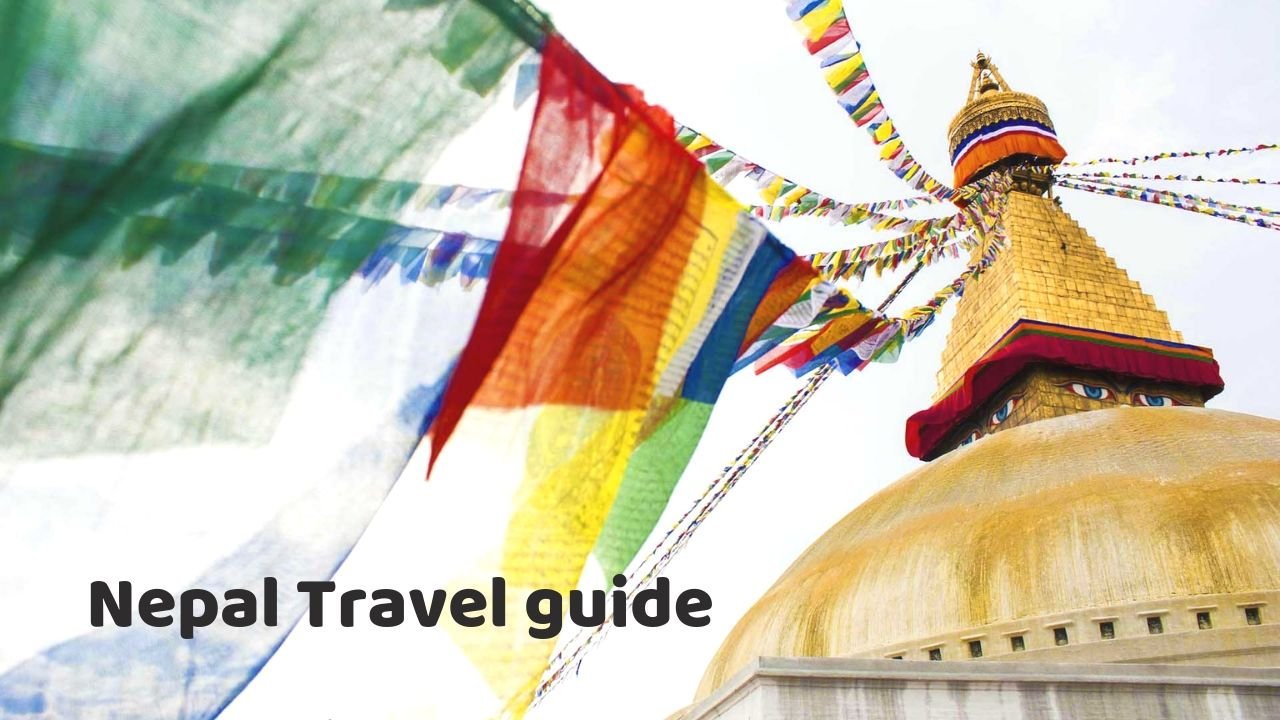
Last Updated on: Mar 20, 2024
It was only in the late 1950s that Nepal opened its borders to outsiders. Since then, Nepal has been alluring travellers with its mystical charm and diverse landscapes. Home to world’s highest peak, the Mt. Everest, this small Himalayan kingdom is known for its incredible mountain, snowy peaks and some of the best trekking trails of the Himalayas. Mountains, jungles, quaint mountain villages, ancient cities and diverse and interesting culture makes Nepal one of the world’s greatest and most interesting travel destinations. Since you are here, a Nepal trip must be on your mind. Here is our comprehensive Nepal travel guide with all the important information to help your Nepal trip plan. And, even if it is not, we urge you to read on. Nepal might just creep into your heart and then to your travel plans!
Where is Nepal located?
Located in South Asia and home to the highest mountain range in the world, the Himalayas, Nepal is a landlocked country sharing its borders with Tibet in the north and India in the east, west and south. Mt. Everest, the highest peak in the world is located in the northern region, while the southern parts of the country have tropical lowlands.
Just as many parts of India like Darjeeling and Sikkim is influenced a lot by Nepali culture, Nepal too has imbibed a lot of Indian culture and way in it.
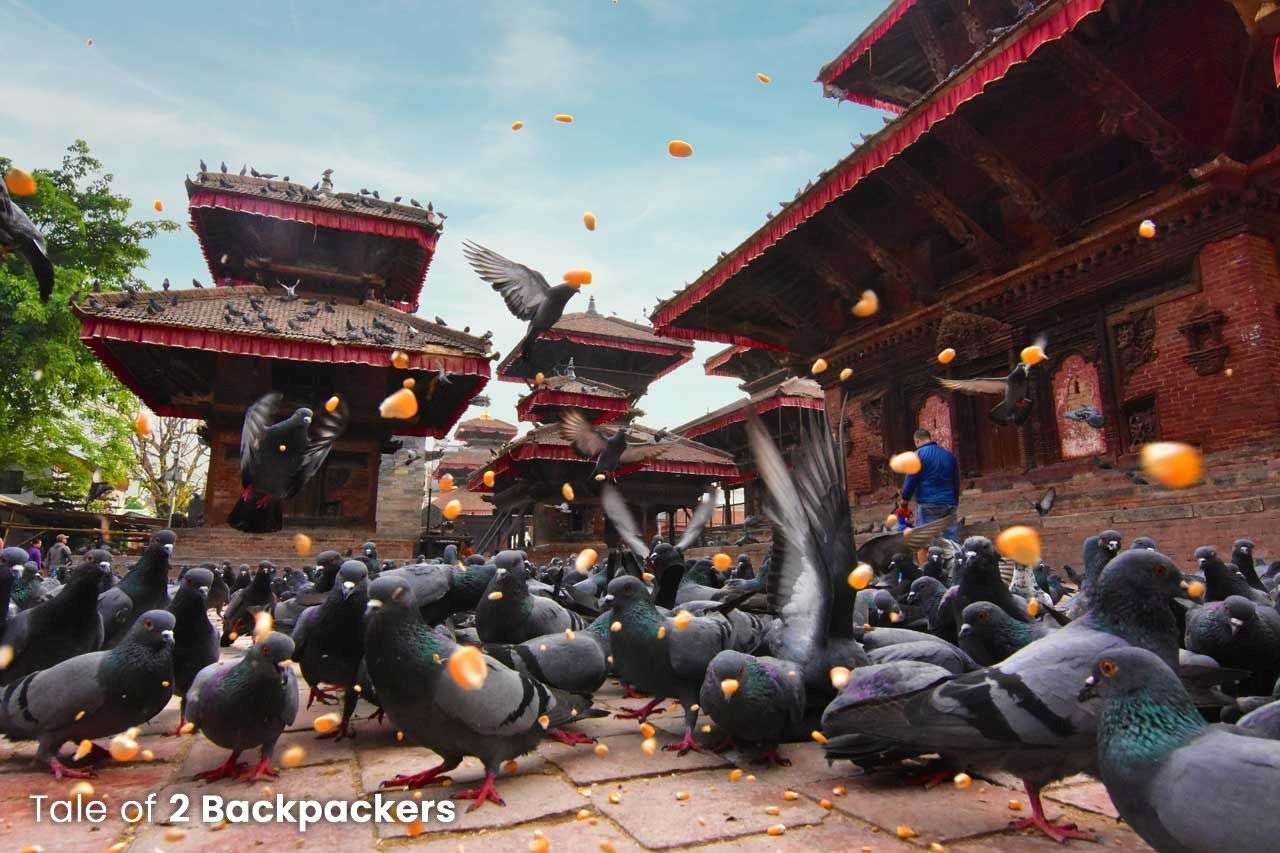
Why should you visit Nepal?
Wedged between the mystical world of Tibet and the steamy jungles of India, Nepal is the land of snow peaks and Sherpas. Yaks and yetis rule the bedtime stories in Nepal. And those stories of yaks and yetis also crept into our bedtime stories. Being from the neighbouring country of Nepal, we heard a lot of interesting stories about yetis during our childhood days. It is a place where you can not only attain travel nirvana but also spiritual nirvana . Just as we mentioned before, let us give you a few reasons why you should visit Nepal.
- Nepal is a trekkers’ paradise: Home to eight of the world’s highest peaks, there is no dearth of trekking options in Nepal. There are treks for beginners as well as experienced ones. And finally, the holy grail for mountaineers, Mt. Everest is also located in Nepal.
- Adventure in Nepal : Apart from trekking, Nepal will make your heart skip a beat with its adventure activities. Paragliding, white water rafting, bungee jumping are some of the adrenaline rushing activities that you can do in Nepal.
- Nepal has a rich wildlife: Visit the Chitwan National Park having a rich wildlife.
- Nepal is culturally diverse and exciting: the cultural landscape of Nepal is as diverse as its natural. There are a number of ethnic groups in Nepal that has made the land culturally rich. From Hinduism and Tibetan Buddhism to nature-worshipping shamanism, Nepali culture has integrated all in itself very well.
- Nepal is the birthplace of Lord Buddha: Lumbini is the birthplace of Gautam Buddha and is definitely one of the must-visit places in Nepal. This fact also makes Nepal culturally unique yet diverse.
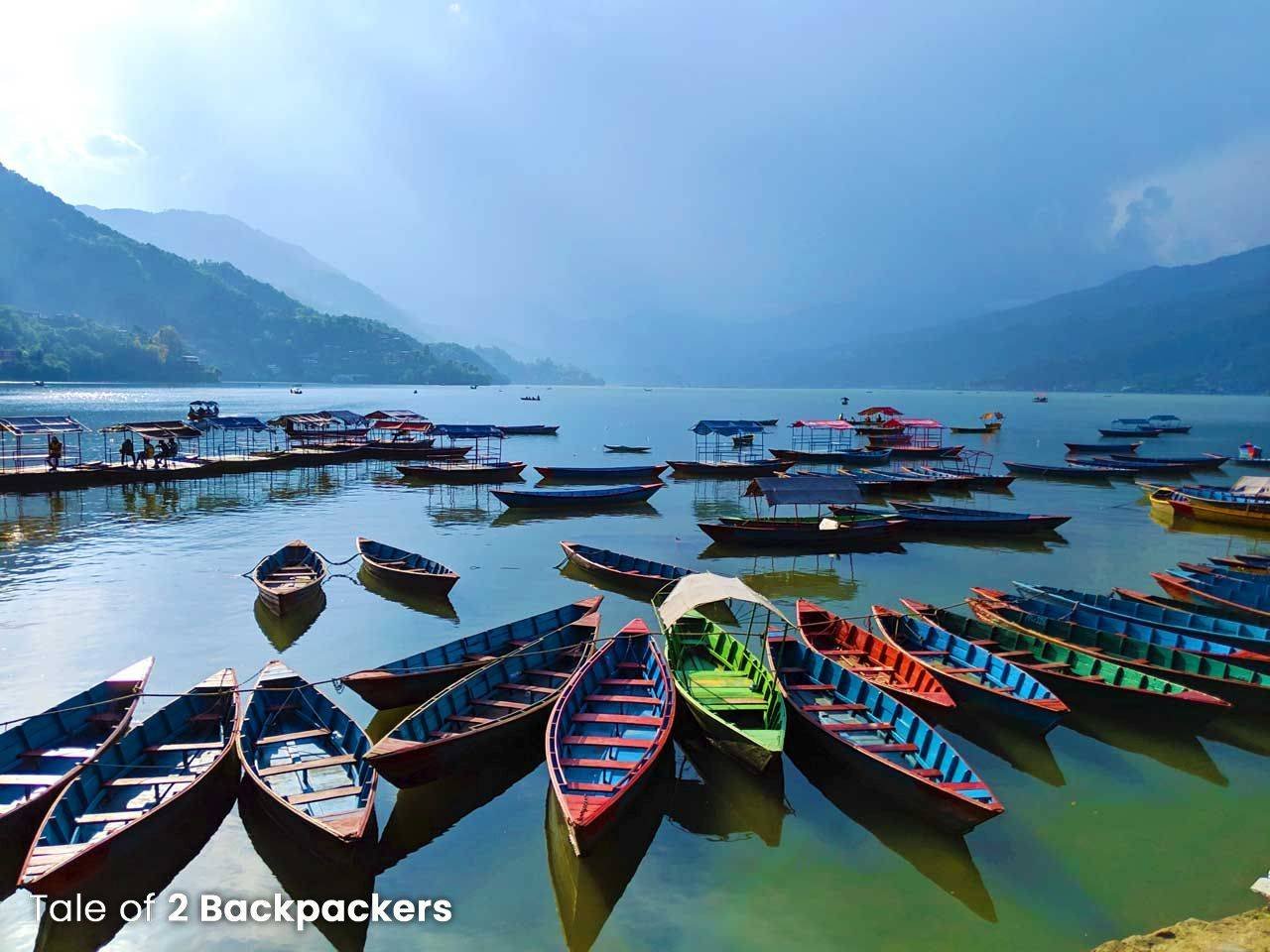
How to get a Visa for Nepal?
Tourist Visa for Nepal can be obtained on arrival at the Tribhuvan Airport at Kathmandu as well as all land border crossings. A few countries are not given visa on arrival. You are advised to check the list before visiting.
You can also apply for online visa upto 15 days before your arrival and travel within 6 months of the visa being approved.
The visa fees are as follows:
15 Days (multiple entries) : USD 30
30 Days (multiple entries) : USD 50
90 Days (multiple entries) : USD 125
Tourist visa extension is done for minimum 15 days with USD 45 and USD 3 per day for additional days. The visa can be extended maximum upto 150 days in a calendar year, but you will have to visit the immigration office before the expiry of your current visa.
For obtaining a visa on arrival, you will need a passport size photo and 6 months validity on your passport.
The steps for obtaining a visa on arrival:
- Fill in the “ Arrival Card ”
- Fill in the online ‘Tourist Visa’ Form (you can fill it up prior to your arrival visiting official website of Department of Immigration). If you fill it from the website, you will get submission receipt with barcode. Get a printout of it for getting the visa. It works for fifteen days and becomes invalid then after. Alternatively, you can fill the form at the kiosk machines upon your arrival at the airport.
- Next, make payment at the counter to the right of your visa kiosk as per your visa requirement. You can pay with Debit card, but it is always good to keep some cash handy.
- Get the receipt.
- Proceed to the Immigration Desk with your online form, payment receipts and passport and hand in your documents to the immigration officer and get your visa done.
- If you are crossing the land border, only cash payment is accepted.
Nepal Tourist Visa for Indians
Indians do not require a Visa for Nepal. As per recent agreement between the 2 countries, your Adhaar Card is sufficient for getting an entry into Nepal . If you are crossing through the land border, you just have to show your Adhaar card and gain an entry into Nepal. As easy as that! But to get a SIM Card in Nepal, you will need a copy of your passport and a passport size photograph. So it is always good to keep your passport handy.
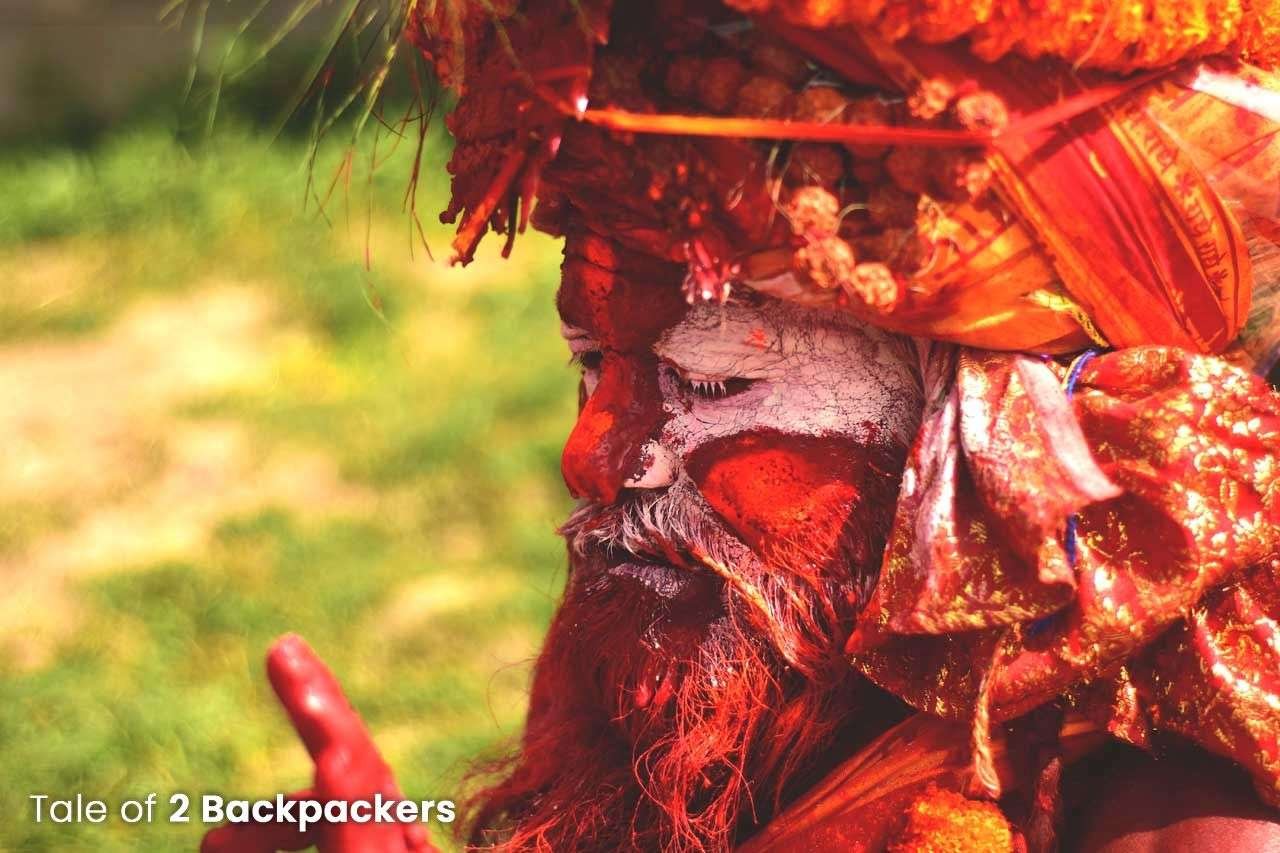
How to reach Nepal?
Nepal has only one international airport in Kathmandu. So if you are flying in, you will arrive at Kathmandu’s Tribhuvan Airport . The flight fares depend on the seasons. Expect high costs especially during the Christmas time and autumn, which is a peak season in Nepal. Also, the rate of flight cost depends on where you are coming from.
Do expect long queues at the immigration lines if you are getting Visa on arrival at the Tribhuvan Airport.
Prepaid taxis are available at the airport terminal to take you to your hotel. Sometimes, a few hotels also provide free pick-up and drop from the airport.
Getting into Nepal from neighbouring countries by border crossing
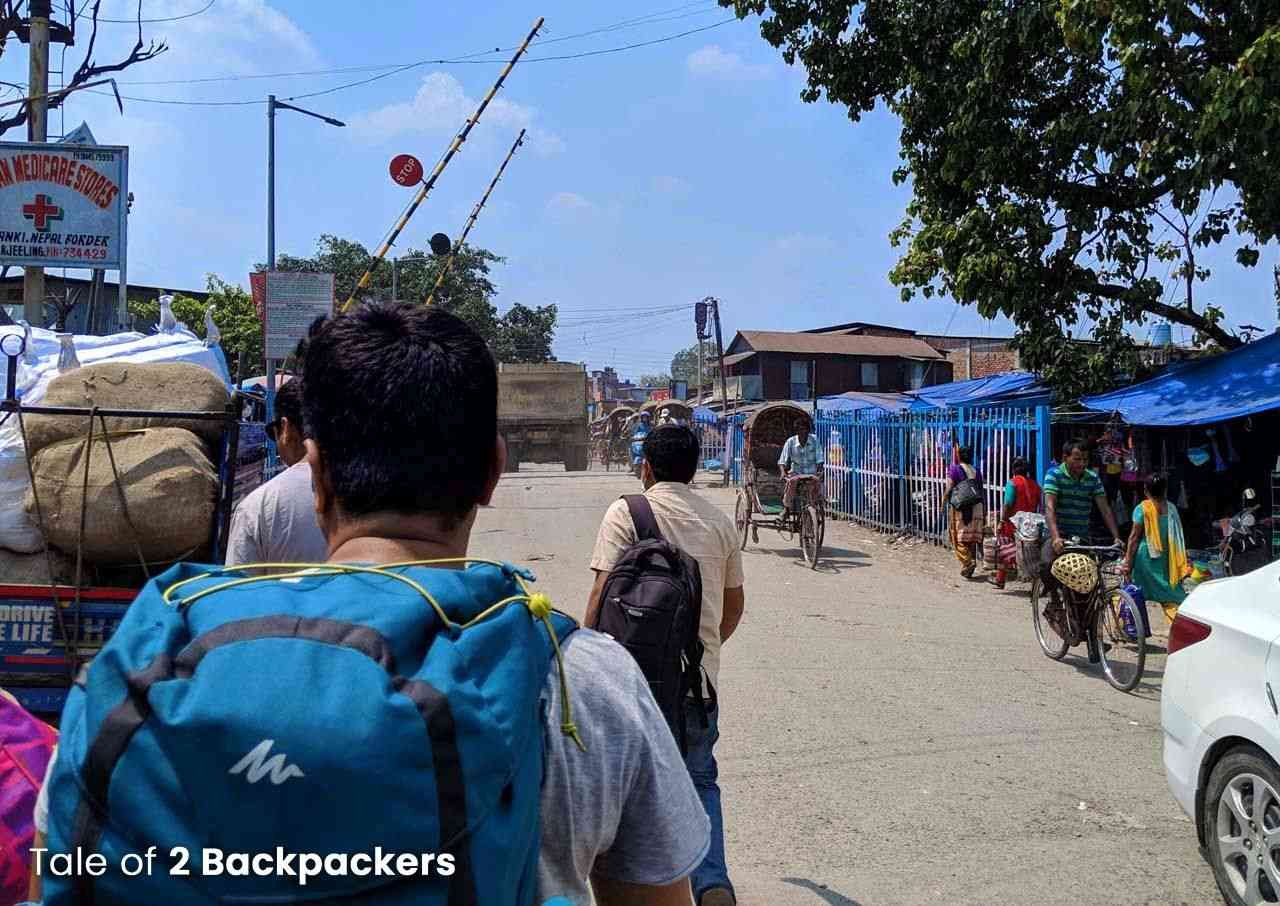
Many travellers often combine a trip to Nepal with that of India. Those in India can also consider getting into Nepal by crossing the road borders. There are a number of border crossings between India and Nepal and an overland route can be easily planned. The most common border crossing between India and Nepal includes the following:
- Raxaul (India side) – Birgunj (Nepal side): The nearest main town is Patna (6 hours). From Birgunj, buses are available to Kathmandu (136 km).
- Panitanki (India side) – Kakarbhitta (Nepal side) : The nearest main town is SIliguri. Those who are coming from Darjeeling can take this border crossing route. From Kakarbhitta, you will get buses to Kathmandu (458 km) and Pokhara (600 km)
- Sunauli (India side)- Belahiya (Nepal side) : The nearest main town is Varanasi. Belahiya is nearest to Lumbini (30 km). So if you are entering by this route, consider stopping at Lumbini first and then carry on your journey to Nepal. Like all the other border towns, buses to Kathmandu and Pokhara are available from here.
- Jogbani (India side) – Biratnagar (Nepal side) : The nearest main town is Katihar (3 hours). From Biratnagar, you will get a bus to Kathmandu. The distance is 240 km. Biratnagar also has an airport and you will get flights to Kathmandu and Pokhara from Biratnagar airport.
Getting around in Nepal | Nepal Travel Guide
Well, getting around in Nepal is a bit tricky. Distances between cities are not that great, but the roads are poor, travelling is slow and the buses are not in the best of conditions. Some of the roads are pretty decent, but there are few that do not deserve to be called roads! Air travel in Nepal is said to be a bit risky. For moving from one town to another, you have tourist buses, local buses, minibuses and jeeps for remote places. There are flights connecting Kathmandu, Pokhara, Jomson and Lukla as well.
Tourist buses in Nepal
Tourist buses are the most common way of travelling across Nepal. There are AC buses with reclining seats, as well as non-AC buses. These buses connect the border town like Kakkarbhitta, Sunauli, Birgunj and Biratnagar with Kathmandu and Pokhara. They also run between all the major towns like Kathmandu, Pokhara, Sauraha (Chitwan National Park), Lumbini, Jomson etc. These vehicles are generally in better conditions than the local buses. In high seasons, it is better to get the tickets to these buses a day in advance, as they tend to get filled. You can get the tickets from the bus stations or bus parks. But all the travel agencies and hotels also can book the ticket for you. They usually charge a 10% commission on the price of the tickets.
We had taken a tourist bus from Kakkarbhitta to Kathmandu. The distance of 458 km was covered in 15 hours. The bus did not have an AC but had reclining seats. Though we would not say that we had a great bus journey, but it was also not uncomfortable altogether. 2 tickets costed us NPR 1600.
Also, we would recommend you to have a look at the bus before booking your tickets.
Express Bus/ Deluxe Bus
These days, a few buses run between the major towns of Nepal that are faster and more comfortable. These deluxe buses have AC and reclining seats with cushions and are quite comfortable. These buses usually run between Kathmandu and Pokhara and also between Kathmandu/Pokhara and Chitwan National Park or Lumbini. These buses usually run during 2 times – day and night. The day buses usually start in the morning and reach the destination by afternoon while the night buses starts in the evening and reach the destination the next morning.
We had taken a deluxe bus from Kathmandu to Pokhara. The bus was quite a comfortable one and the tickets cost us NPR 1200 per head. Yes, these buses are comparatively costlier, but you will have a comfortable journey.
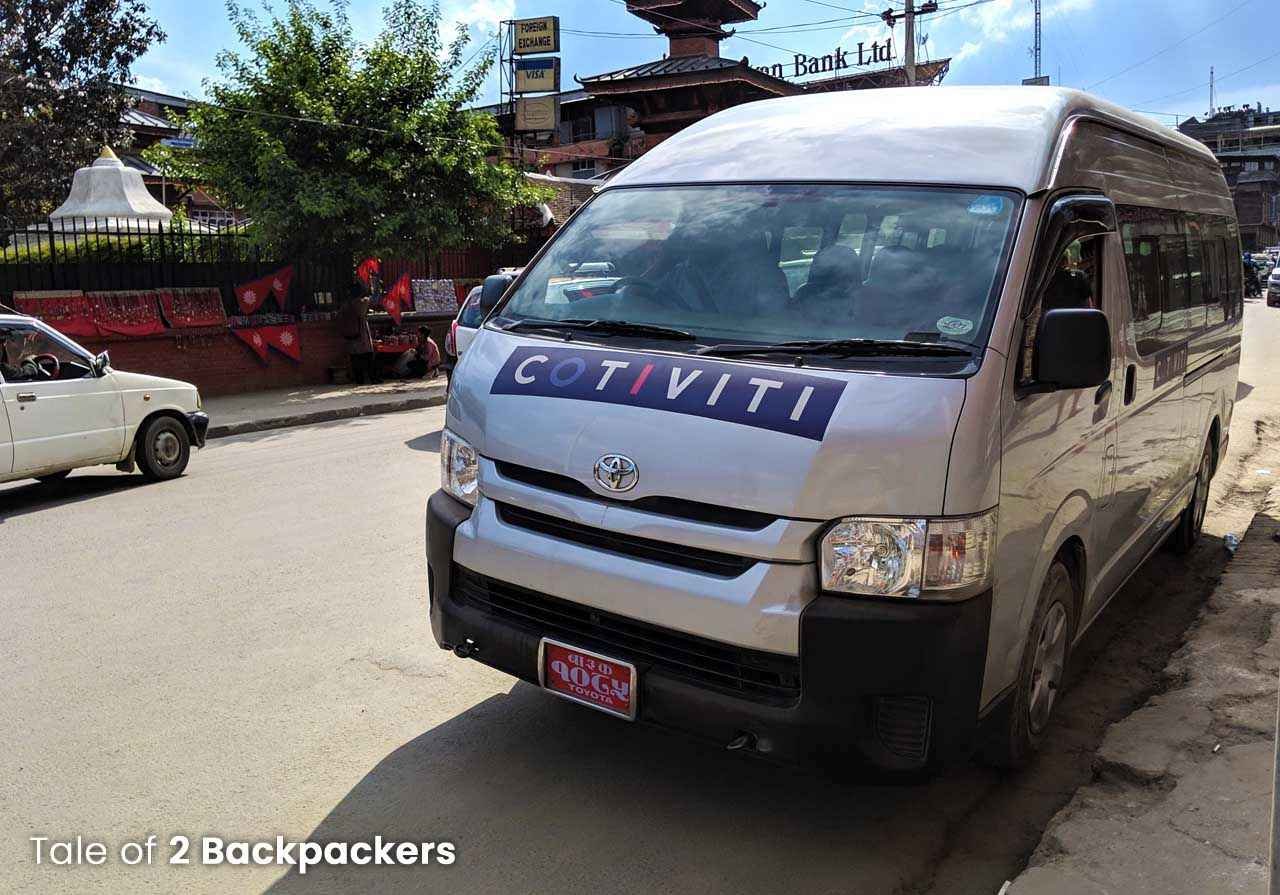
Minibuses travel on all the routes as the tourist buses and also on other routes. They are generally a bit faster, cheaper and a little less comfortable. Unlike the tourist buses, the minibuses run throughout the day. If you plan to go by minibus, then there is no need to get a ticket beforehand. Infact, you should get the tickets directly from the bus conductor and not from any vendors who might try to sell you a ticket at an inflated price.
Local buses
You need to be really adventurous if you try to travel across Nepal in local buses. Travelling within the city is all fine, but we would not recommend you to travel between cities on a local bus. These buses are definitely much cheaper but are old, slow and uncomfortable and prone to breakdown. Also, the buses will be cramped with passengers and you might find it hard to travel with all your luggage.
Jeep or 4WD
You might not need to ride a jeep or 4WD unless you are off to the remote places. Jeeps are the only mode of transport in the remote places where the roads are mere mud tracks. On the roughest routes you might even find a tractor! These jeeps are usually used to carry local supplies along with people, so you might find yourself huddled with groceries and goods! The price of a jeep ride depends on the place and region of your travel and the season.
Just like any other place, you will get taxis to take you from one city to another. Do bargain with the driver before deciding on the price.
Air travel is an essential part of Nepal transport network. But air safety record is worse than the road safety record. A flight over the Himalayas can be a visual treat to the eyes and exhilarating, but it can also be quite scary. You might have to take flights in Nepal from Kathmandu to Lukla (for Everest Base Camp trek ) or Pokhara to Jomson (For Annapurna Circuit Trek). If you are a part of a package tour or hike, then the flight cost is usually included. But if you are looking for flight tickets yourself, you can look into Buddha Air, Yeti Airlines and Sita Air .
Be prepared for bad weather and delays when you are flying in Nepal. Cancellations are also quite common. Also, book your tickets well in advance during the peak trekking seasons.
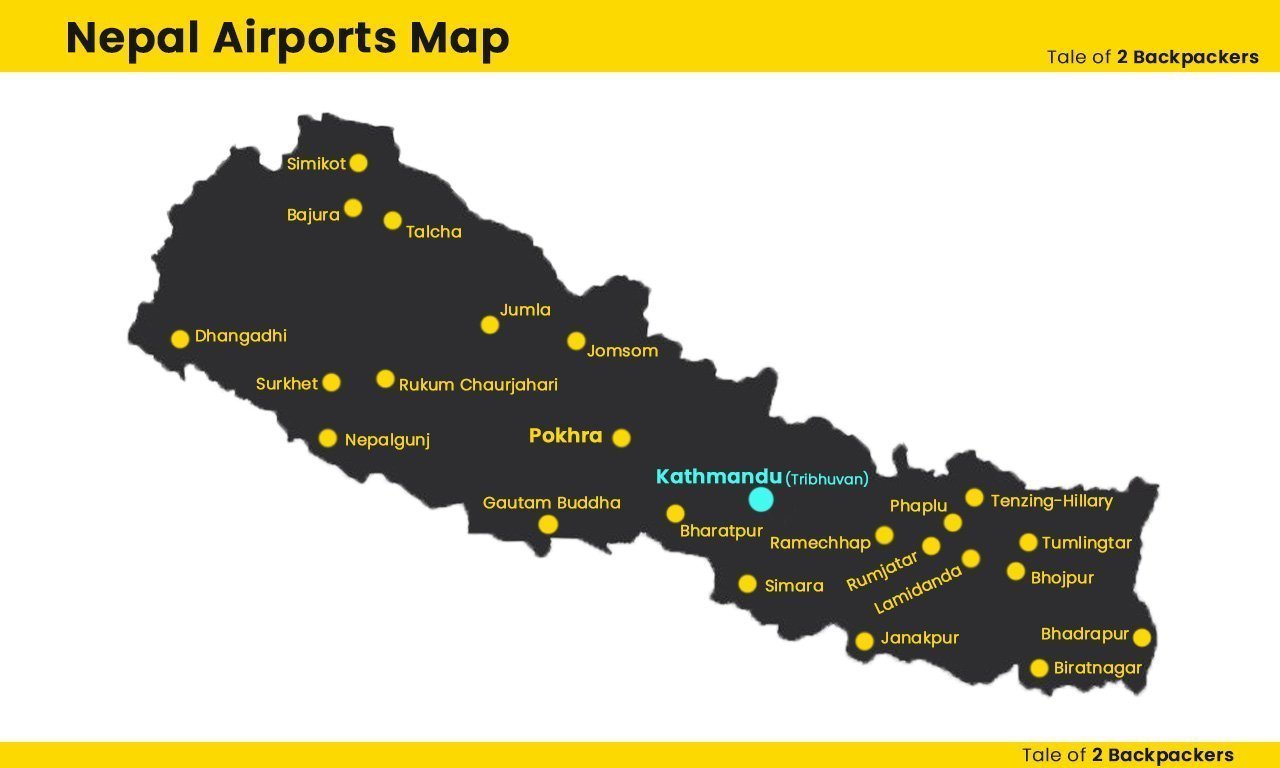
Travelling within the city – how to get around cities? | Nepal Travel Guide
In Kathmandu and Pokhara, going around by car is a great option. They are quicker and much more comfortable than the local buses. Also, they will take you to the exact location of your destination. Although these taxis have a meter, they always refuse to go by meter and will quote a price. You do have to bargain with the driver. And yes, there are no Ubers here!
Local buses are super cheap but are often crowded and packed to the brim. In most of the cities, the standard fare is NPR 20-25 for a ride within the city. Well, if you are okay with the crowd, then a bus ride is a fun way to observe the local Nepali people and their culture.
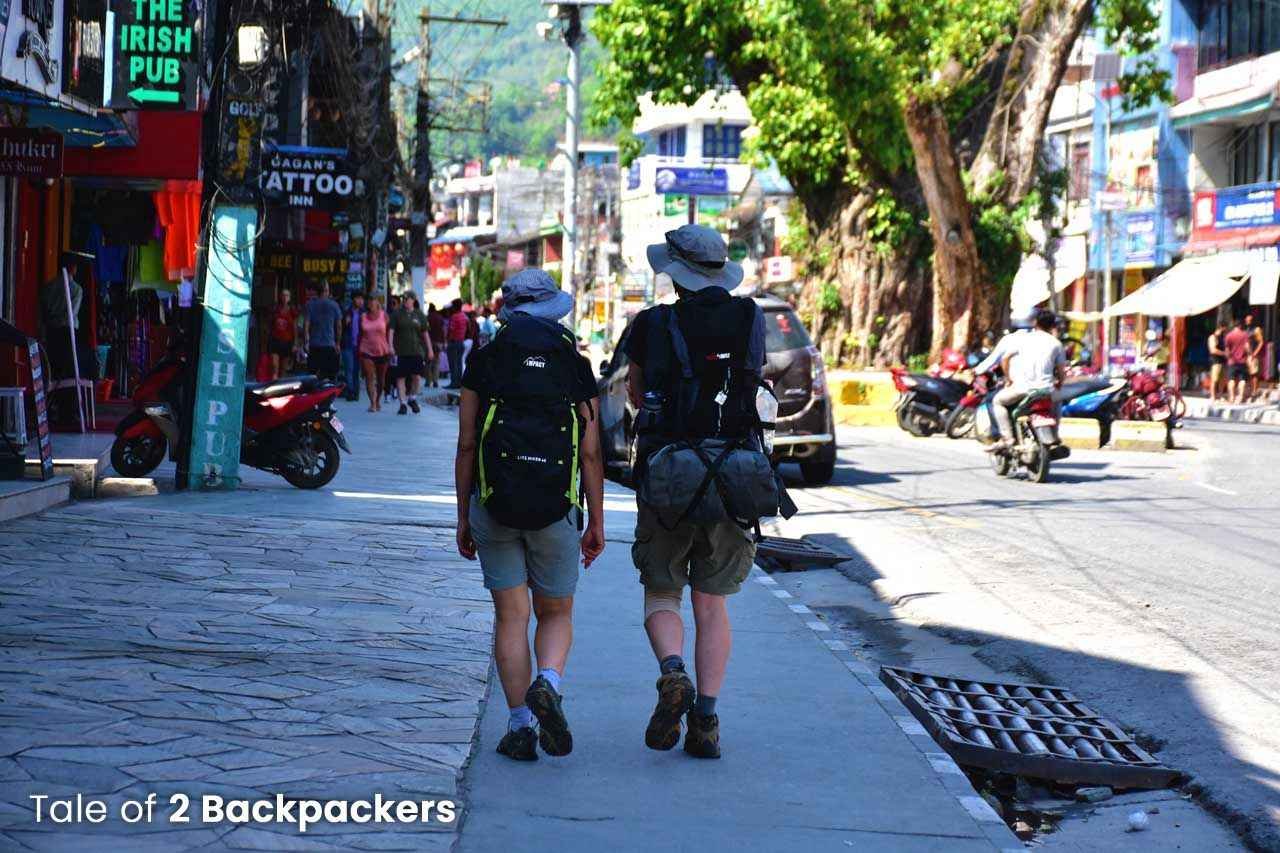
Motorcycles and cycles
You will get motorcycles and cycles on rent on per day basis. For renting a motorcycle, you need to have a valid driving license. You might have to leave your passport or return ticket as a deposit for renting a 2-wheeler. Motorcycles can be rented at NPR 700-800 per day based on the type. This rate is excluding fuel. Keep in mind that there is a shortage of fuel in Nepal. So if you are visiting the offbeat tracks, then get your tanks full.
Bicycles will cost you around NPR 200-300 per day.
Driving is on the left-hand side of the road. Indians will probably not face many problems because road rules are just like that in India. Tourists from the West might face a problem with the traffic, road conditions and vehicles or people jumping in front of yours while driving.
What is the best time to visit Nepal?
The best time to visit Nepal depends on the where you want to visit and what you want to do. Nepal has a temperate climate with four main seasons centred around the summer and monsoon. Before your Nepal trip plan, decide when you want to visit the country.
Autumn (late September to late November)
Autumn is the peak season in Nepal when the weather is clear and dry. It is neither too cold in the higher altitudes, not too hot in the Terai region. The rains have already cleared away the pollution and dust and you will get a clear view of the mountain peaks. This is also the best time for trekking. Thousands of trekkers hit the Everest and Annapurna region during this time. Prices at Kathmandu are also at their peak.
Winter (December and January)
The weather is most stable and clear during this time. During this time, the trekking trails are relatively less crowded as the temperature becomes quite low at those places. If you can bear the cold, then it is an excellent time to be near the mountains. Otherwise, the Terai region or the plains have a fantastic climate. This is a good time to explore the cities of Nepal.

Spring (February to mid-April)
This is the second-best time to visit Nepal. The weather is warmer and the days are longer. Rhododendrons bloom in the higher altitude areas. This is the best time for viewing the wildlife. This is also a good time for the trekkers. However, during April and May, a haze sits over most of Nepal due to crop burn. So visibility can be low especially in Kathmandu valley and Pokhara.
Monsoon (June to September)
This is the lean season for trekkers in Nepal. Monsoon brings heavy rains, landslides and clouds obscure the mountain views. The countryside though takes a fresh green look. July and August is also the best time to visit the Mustang Valley that falls in the rain shadow area.
Places to visit in Nepal

Kathmandu Valley
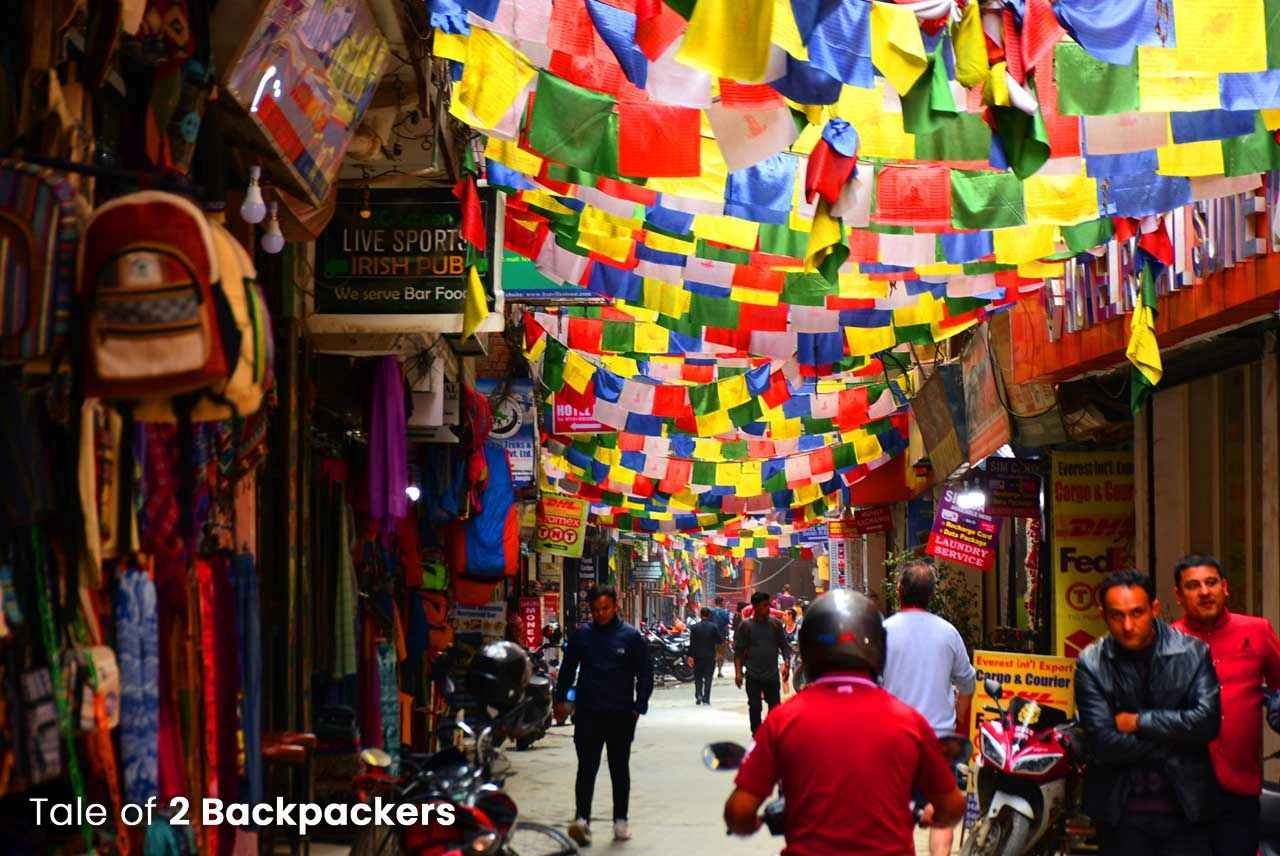
Kathmandu, the capital city of Nepal is an electrifying mix of medieval alleys, Hindu temples, Buddhist stupas and vibrant city life. There is an entire list of UNESCO World Heritage sites in Kathmandu city itself. Kathmandu is crowded, noisy and dusty, but is also unique in its diversity. While in Kathmandu, do not miss the UNESCO World Heritage Site Kathmandu Durbar Square. After the earthquake in 2015, many of the ancient buildings were thoroughly damaged, but now the majority of the buildings are being restored gradually, mainly with the help of China. You will see bid signboards saying the donation and help of China in restoring these ancient monuments. Well, China seems to have reached everywhere.
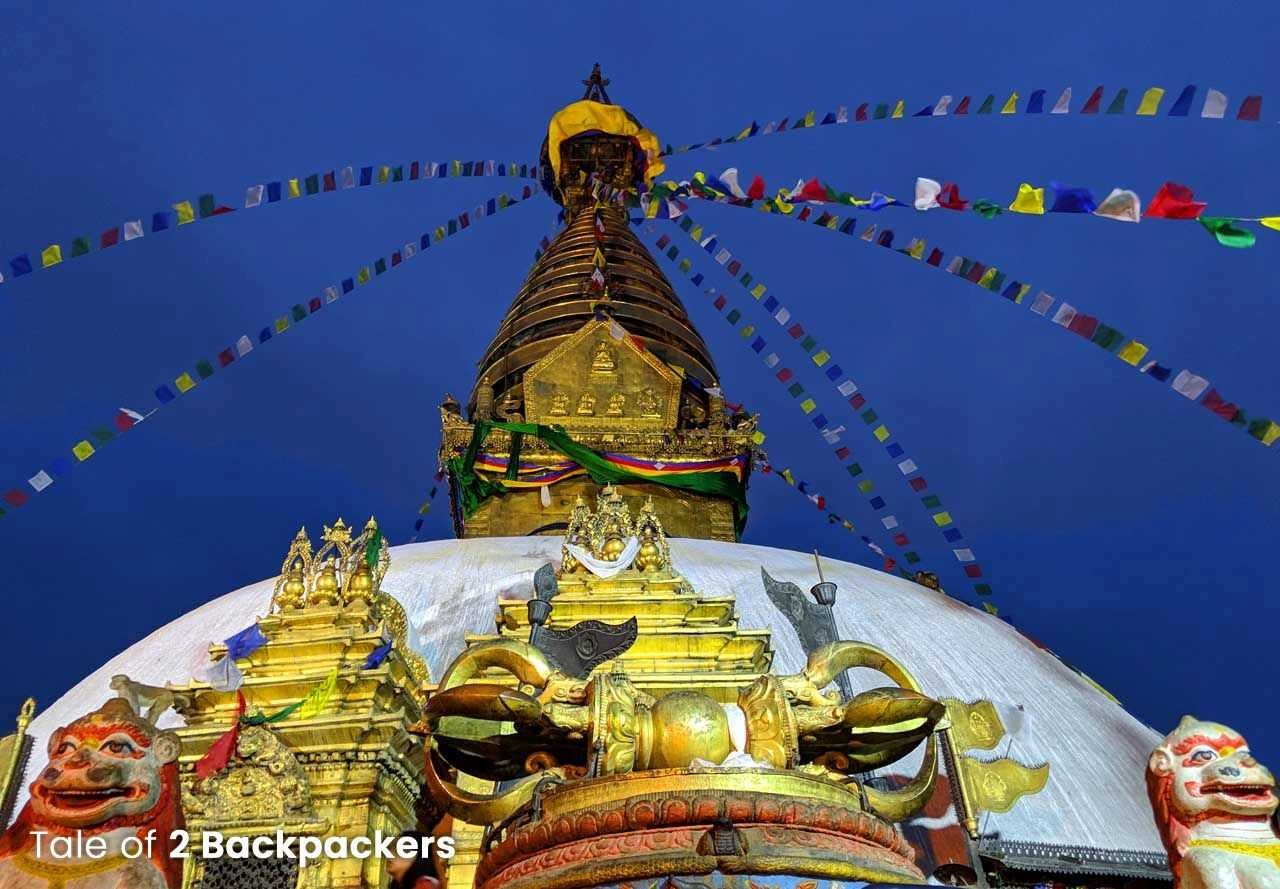
The other places of attraction in Kathmandu city are Pashupatinath Temple , the sacred Hindu pilgrimage site, Boudhanath Stupa and Swayambhunath Stupa , the two Buddhist sites. The Narayanhiti Palace , Garden of Dreams are 2 other interesting places to visit in Kathmandu. And of course, do not miss to visit the Thamel market . Thamel is definitely your one-stop solution for all your trekking and hiking needs.
After you have explored Kathmandu city, visit the 2 other UNESCO Heritage sites Patan and Bhaktapur Durbar Squares . Kathmandu, Patan and Bhaktapur were the 3 ancient kingdoms of Nepal. All the 3 Durbar Squares are beautiful and magnificent in their own rights.
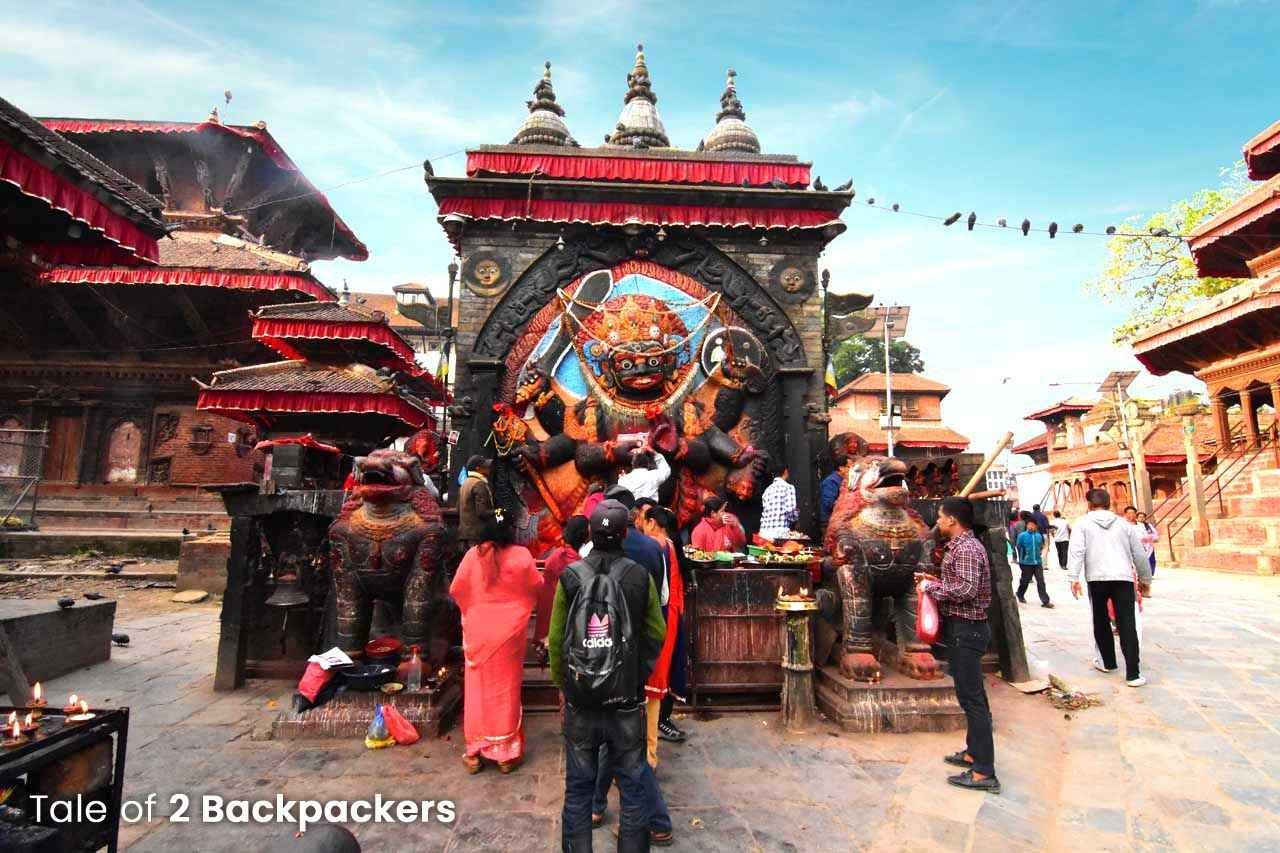
While many have complained Kathmandu to be crowded and noisy (which I agree completely), I found Kathmandu totally fascinating. Infact, there is a sense of calm amidst all the chaos in the city. It is something just as we felt when we were in Varanasi . Interestingly, there is a Nepali temple in one of the Ghats of Varanasi built by a Nepali King.
If you do not at all prefer the chaos of Kathmandu, you can visit the rural landscape of Kathmandu valley. A visit to Nagarkot will take you close to the mountains and give you a sense of serenity. Although Nagarkot has now become quite commercialized with many hotels cropping out here and there and is no longer offbeat, still the place is much more serene than Kathmandu.
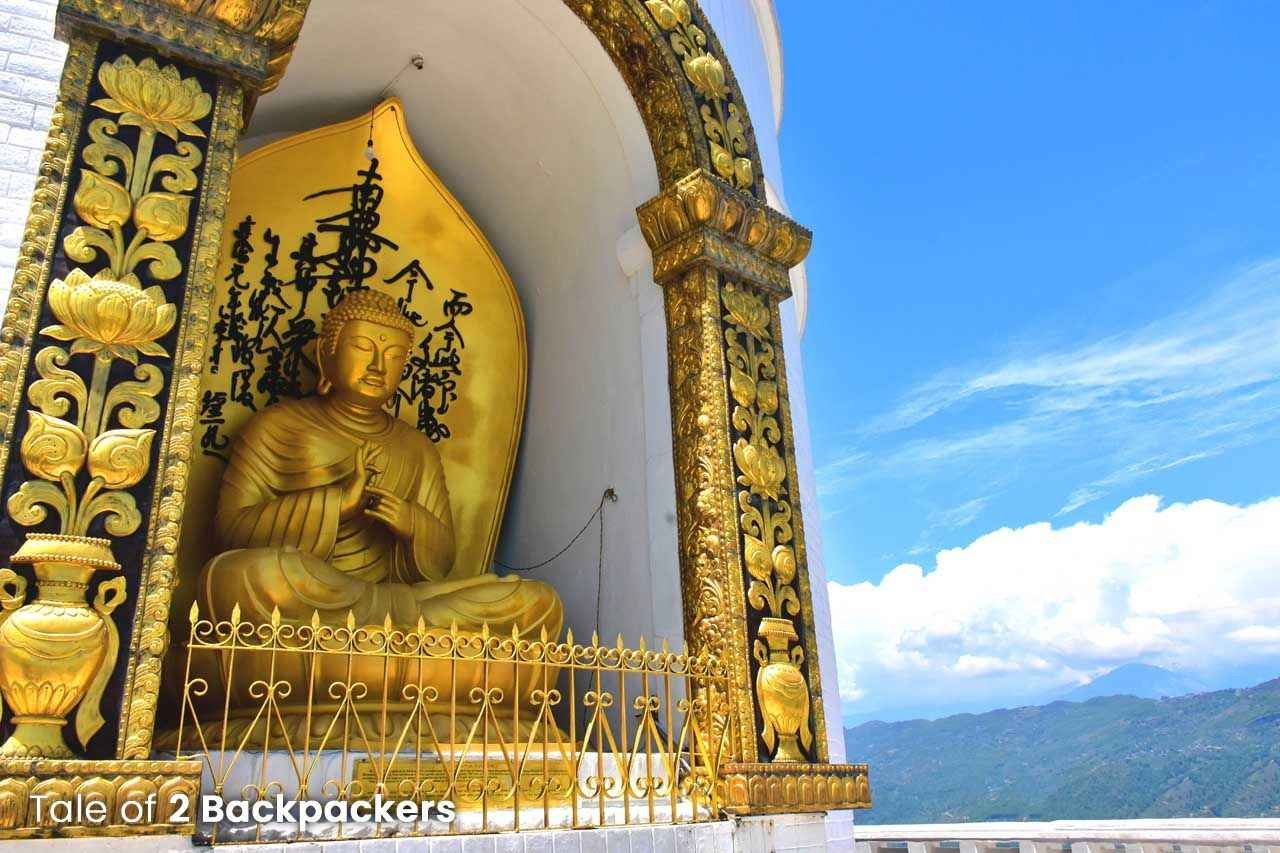
Pokhara is perhaps the next most visited place in Nepal. While Pokhara downtown can be quite crowded and noisy, the lakeside Pokhara is the epitome of tranquillity. Located around the Fewa Lake with the Macchapucchre Peak (Fishtail Peak) at the backdrop, Pokhara is a paradise for the laidback travellers, backpackers, trekkers and the adventure enthusiasts. Afterall, treks to the Annapurna circuit, Ghorepani Poon Hill Trek , Mustang valley – all starts from Pokhara. You can also indulge in various adventure activities like paragliding. There are few other touristy things to do in Pokhara as well. The best place, however, is the Peace Pagoda located high up on a hill. It was definitely one of our favourite places.
Evening in Pokhara lakeside is completely chilled. There are shacks and restaurants lining the lake where you can simply sit down, enjoy the sunset and have a beer. Pokhara is the perfect antidote to the crowded Kathmandu.
Read about our complete guide on Places to visit in Pokhara .
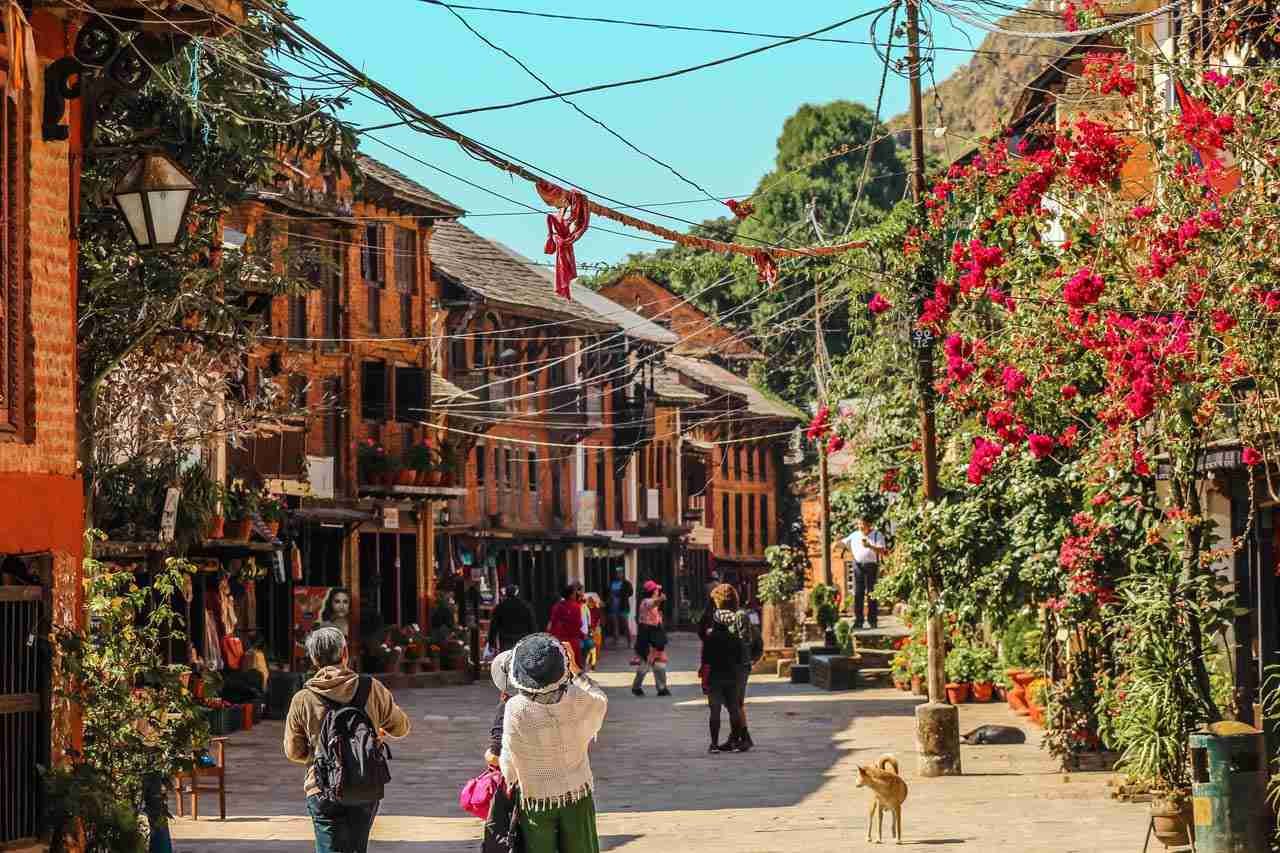
The ancient Newari village of Bandipur is often overlooked by tourists due to its slight offbeat route, but the place is worth visiting. Bandipur is the living open-air museum of the ancient Newari culture of Nepal. The town was once the stopping point on the Indo-Tibet trade route.
The village has beautifully preserved traditional Newari houses having intricate woodwork (Newari houses are known for their elaborate woodworks. You can also see a few of them in the old alleys of Kathmandu). The town has a distinctly European feel to it with quaint houses and vehicle-free streets. You can also visit the nearby peak to get a great view of the surrounding valleys.
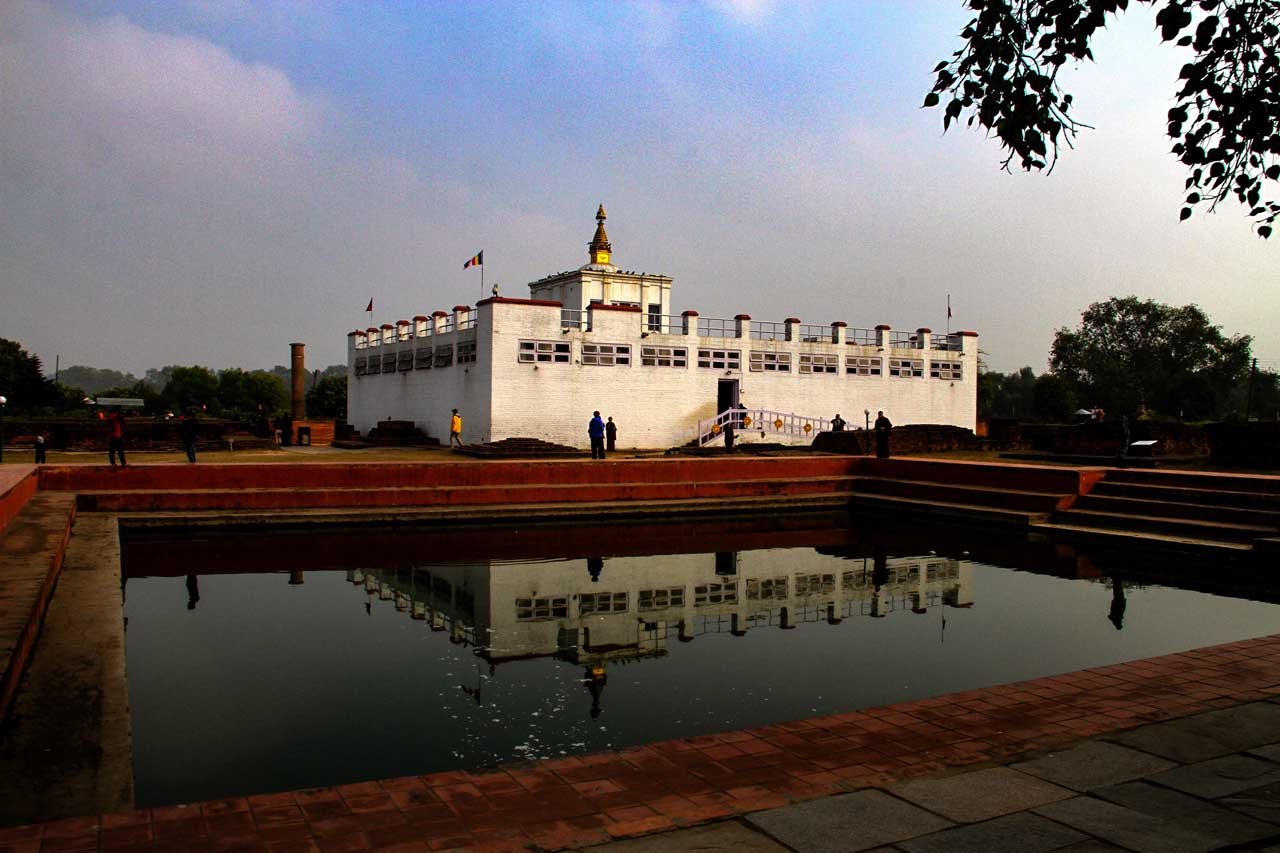
When you are Nepal, you will see quite a few graffiti on walls, buses saying “Buddha was born in Nepal”. Well, Lumbini is the place where Gautam Buddha was born. We thought that our Nepal Travel Guide can never be completed unless we mention about Lumbini. A UNESCO World Heritage Site of immense global significance, Lumbini is visited by thousands of Buddhists every year. The Maya Devi Temple is the most significant place in Lumbini. The place also has a number of monasteries, stupas and temples constructed by the Buddhist community.
Didn’t we tell you before that Nepal is an incredible mix of cultures?
Chitwan National Park
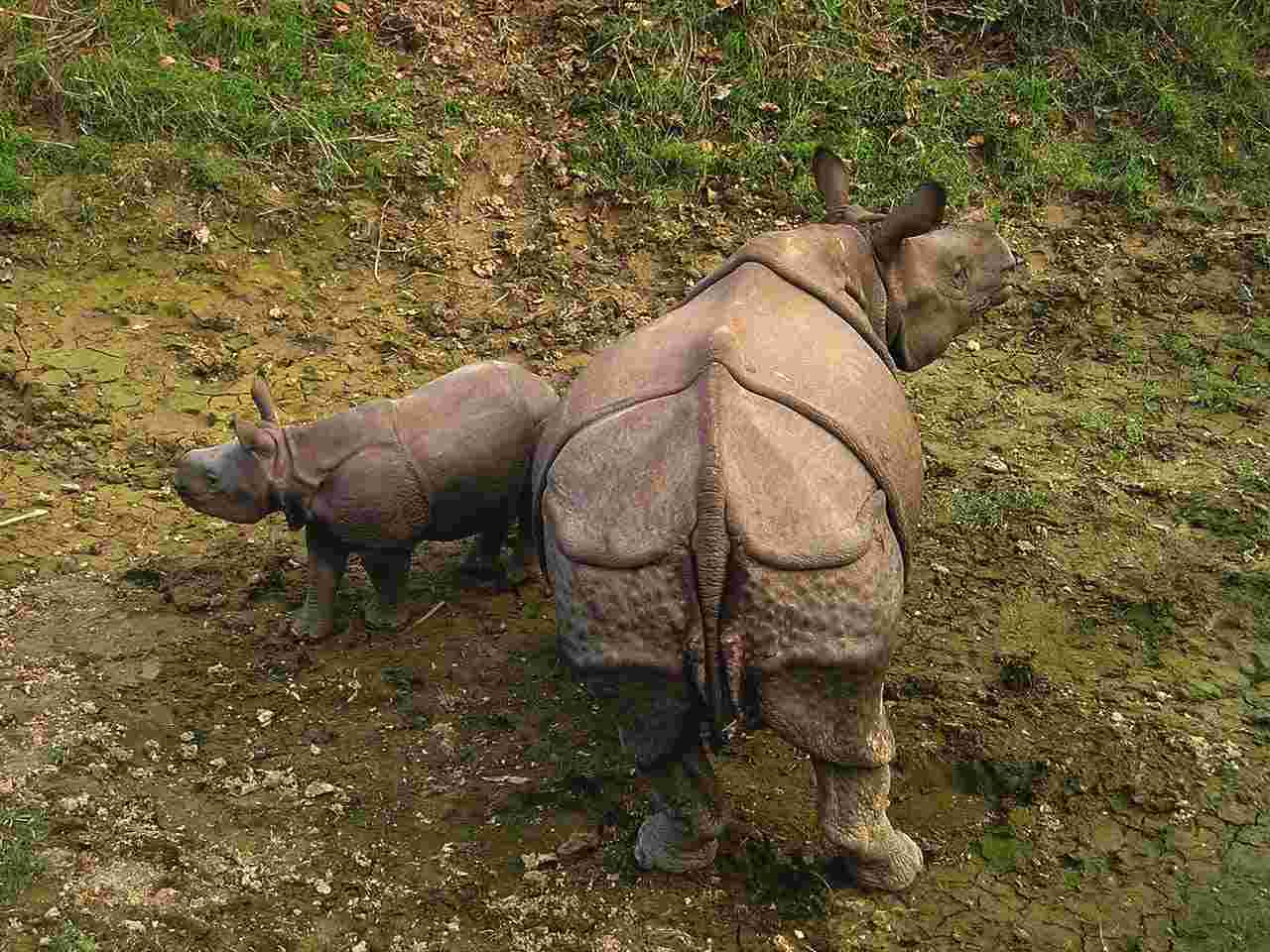
Located in the lowlands of Nepal bordering India, Chitwan National Park is one of the most beautiful national parks of Nepal. It once served as the royal hunting ground, but presently it had achieved the distinction of being a zero poaching place in 2015. You can see the one-horned rhino, sloth bear, crocodile, gharial and monkeys on a game safari. Having said that, try to avoid doing an elephant safari. We had done it once and decided to do it never again!
Adventure in Nepal | Nepal Travel Guide

Nepal is a heaven for the adventure enthusiast. Being the home to the world’s highest mountain ranges, trekking is no doubt one of the main reasons that people visit Nepal. Apart from trekking, Nepal also offers numerous activities for the adventure junkies. Nepal is surely a Disneyland for the adventure enthusiasts. Here is a list of the best adventure in Nepal:
- Bungee Jumping and canyon swing
- White water Rafting
- Paragliding
- Mountain flight over Everest
- Jungle safari
Trekking in Nepal | Nepal Travel Guide
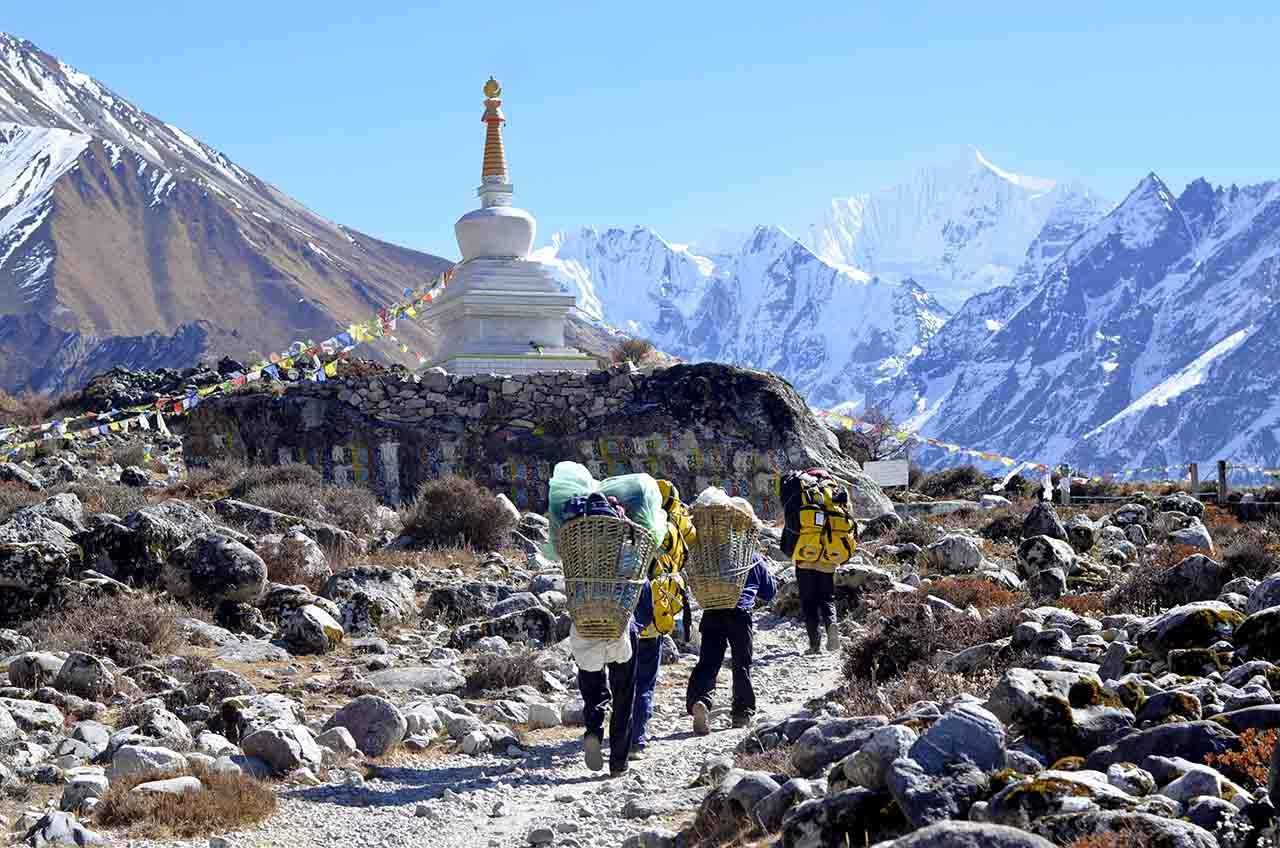
Trekking in Nepal is perhaps the greatest thing to do. We believe that all the mountaineers and trekking enthusiasts visit Nepal at least once in their lifetime. There is something about trekking in Nepal that gives you a sense of accomplishment. It might be the majestic Himalayas that makes trekking so memorable and enriching experience.
Read about our complete guide on Trekking in Nepal along with 14 Best Treks in Nepal .
The best thing about trekking in Nepal is that it has trails for everyone. Of course, Everest Base Camp Trek is one of the ultimate experiences, but in Nepal, there are smaller trails like Poon Hill Trek for all those who do not have much time.
The Annapurna Circuit Trek takes about 16 days and goes through the picturesque Nepali mountain hamlets and gives you a glimpse of the local life in Nepal. However, we feel that Mustang Valley bordering Tibet is one of the ultimate experiences in trekking. The Upper Mustang valley is not frequented by many trekkers because of the high permit fees (USD 500 for 10 days) but it is worth all of it.
Some Quick Information for your Nepal trip plan
Money matters.
The currency of Nepal is Nepalese Rupee (NPR).
You can convert all the major currencies at Kathmandu and Pokhara. You will find many currency exchange shops there. You can also exchange currencies at the airport and near the land borders.
ATMs in Nepal
Debit cards and credit cards are accepted in most of the hotels and restaurants these days. ATMs are widely available in all the major cities of Nepal. Most ATMs have a maximum withdrawal limit of NPR 10,000; however, some NABIL machines have an NPR 35,000 limit. But if you are travelling to interior places, then it is advisable to carry cash.
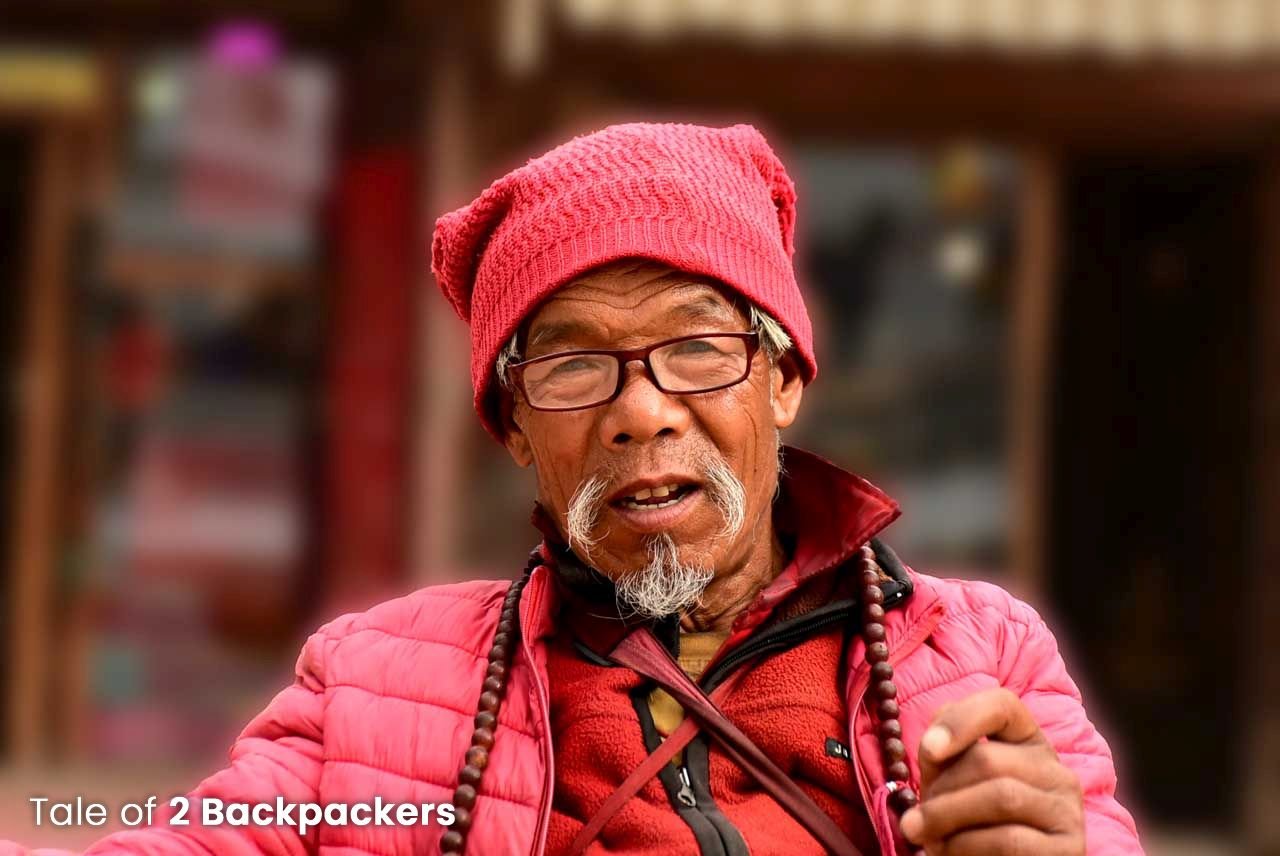
For Indians
You can exchange Indian Rupee to Nepalese rupee near the border. But do inquire about the exchange rate beforehand. We had exchanged INR to NPR near Panitanki-Kakarbhitta border and got quite a good rate.
You can also withdraw money from the ATMs. Usually, NPR 400 per withdrawal is charged. If you have a State Bank of India Debit Card, then you can withdraw money from State Bank of Nepal at a nominal rate. Usually, Indian rupees of smaller denomination (Rs50 & 100) are accepted in Nepal. Do not carry high denomination currency (Rs500 & 2000) to Nepal. You will find it difficult to exchange them.
Electricity
Power cuts are quite normal in Nepal. While most of the bigger hotels will have generator facilities for power backup, it is always better to keep your mobiles and cameras charged. Do keep a power bank with you.
Electricity Socket: The power outlets are compatible with European plugs (three prongs). Do carry a universal travel adapter with you so that you can use your electronic gadgets.
What is the language of Nepal?
Nepali and Newari is the main language of Nepal. Hindi is also spoken widely, and so is English. Since Nepal receives a lot of foreign tourists, most of the trek operators and sherpas understand and speaks English.
What to eat in Nepal?
Food in Nepal has a lot of Indian influence. Indian travellers will probably feel at home in Nepal. The food in Nepal is extremely good having both Indian and Tibetan influence. A few of the must try dishes in Nepal are:
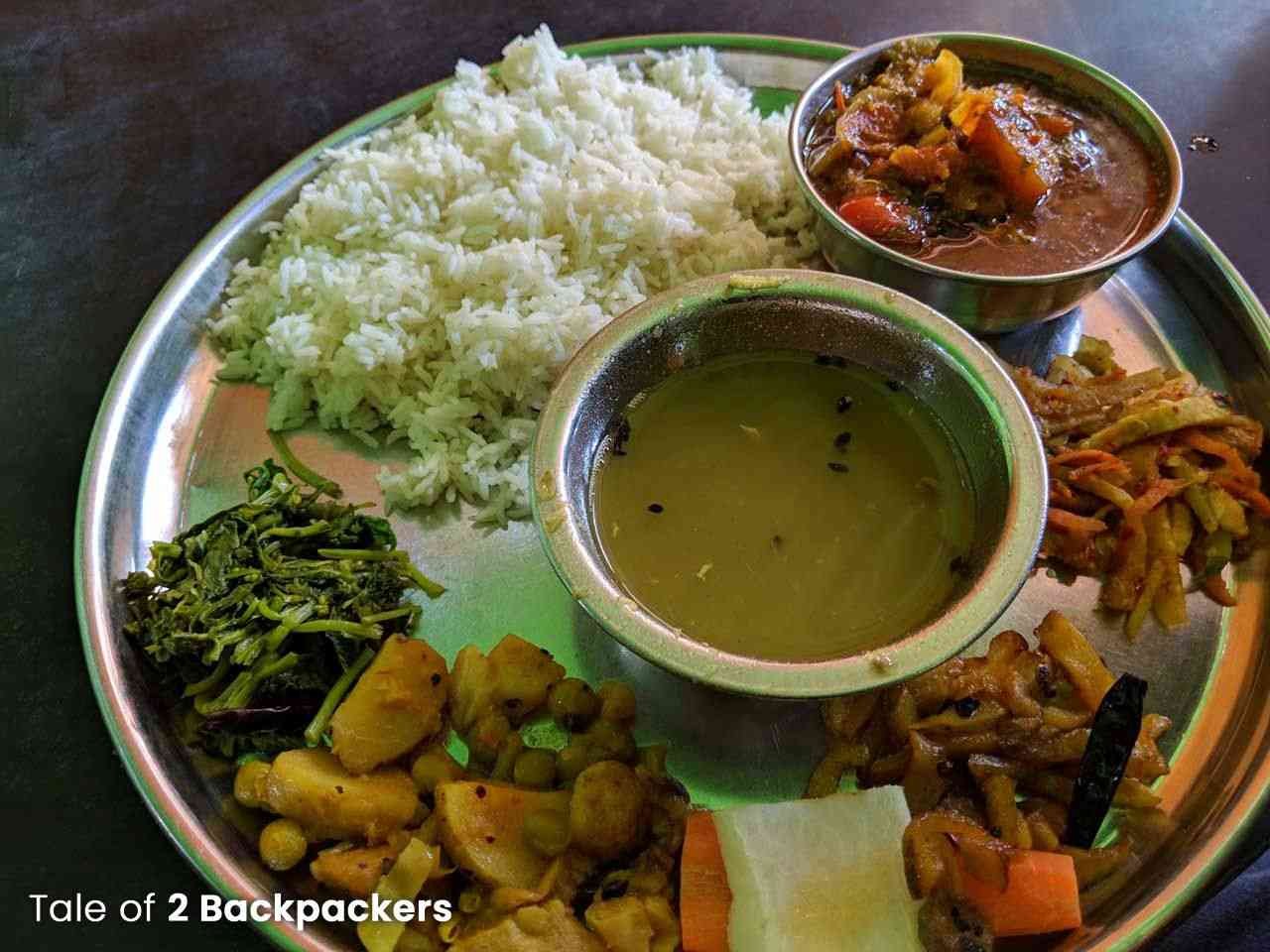
Yes, Dah Bhat is the staple food in Nepal. You will get it all over Nepal and you will also see people wearing tee-shirts with the slogan written on it “Dal Bhat Power, 24 hour” ! Dal Bhat is a set meal consisting of rice, curry and veggies and dal (soup-like serving of lentils). You can also add some non-veg items with you if you want. Dal Bhat is stomach filling and a serving of Dal Bhat is enough to carry you through the day. Personally, we both are also fond of the Dal Bhat power!

As Indians, we are all familiarized with momos. They are the Nepali version of dumplings filled with veggies or meat and served with spicy chutney. Steamed or fried, momos are the best snacks that you can get in Nepal. It was also our comfort food there.
Where to stay in Nepal?
Tourism has been on the rise in Nepal and so there are a number of hotels, hostels, guesthouses and homestays in Nepal. There are tree-houses in the trekking areas for accommodation.
You will find stays catering to almost all kind of budgets in all the major cities and towns in Nepal. During the peak season, you can pre-book your accommodation. But in cities like Kathmandu and Pokhara, you will probably get a place to stay at all the time. We usually do not pre book hotels and prefer looking for deals once we arrive at the place. If we have to do a booking online, we prefer booking.com
Major Festivals of Nepal

Hindus are known for their many festivals. Nepal, being a Hindu nation has a number of festivals celebrated all around the year. Also, Buddhist festivals are celebrated with lots of vigor and enthusiasm. Nepal is such a place where the Hindu and Buddhist culture has been inexorably mixed. Both the communities have borrowed practices, traditions from each other and they coexist seamlessly.
Nepali New Year celebration is one of the major festivals of the country. This usually occurs in the 2 nd week of April and New Year is a time for week-long celebration all over Nepal. We happened to visit Nepal during this time and witnessed the interesting and visually stunning festivals like Bisket Jatra and Sindur Jatra.
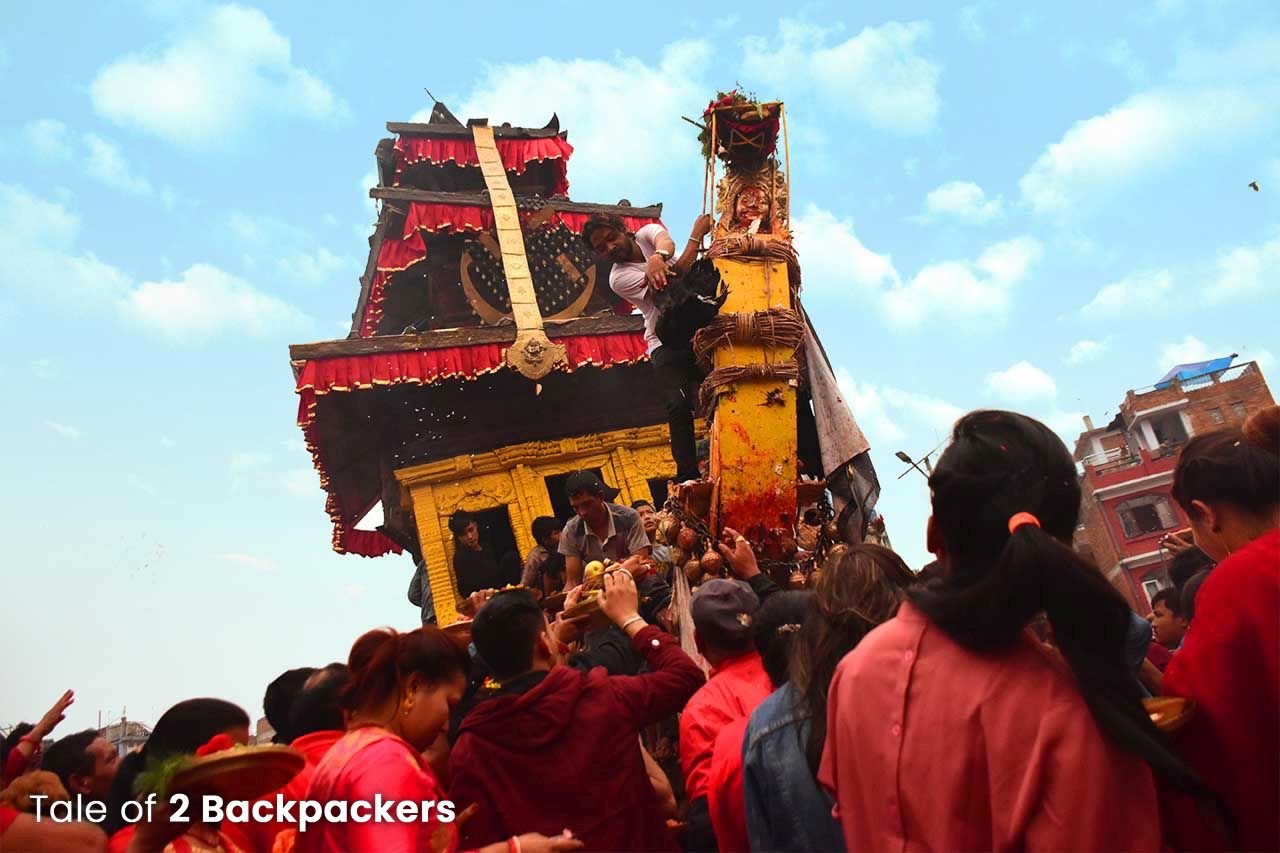
Indra Jatra is another important festival in Nepal when the Kumari, Living Goddess of Nepal comes out in front of the common people. Indra Jatra is celebrated usually in the month of September. Dasain or Dussehra and Holi are also celebrated with great pomp.
How much does it cost to travel to Nepal? | Nepal Travel Guide
Nepal can be as cheap and as expensive as you want it to be. But yes, Nepal is an extremely affordable country to visit. Nepal caters to all types of tourists – budget to luxury.
Being a tourist in Nepal can be cheap, but cost of trekking and mountaineering in Nepal can be quite high depending on the type of the trek you choose and what comfort level you want. Trekking permits come at a high cost in Nepal.
The typical cost of travelling in Nepal is given:
Accommodation:
- Dorms in a hostel with shared bathroom: NPR 500-800
- Budget hotels (with DBR) & homestays : NPR 1200 – 2000
- Mid-range hotels: NPR 2000 – 4000
- Luxury hotels: NPR 5000 onwards (available only in main cities like Kathmandu and Pokhara)
- Tea houses/ trekking lodges: NPR 500 – 2500
Cost of food
- Local meal in guesthouses and small eateries: NPR 150 – 250
- Snacks: NPR 50 – 200
- Three-course meal in fancy restaurants : NPR 600+
- Water bottle (1 litre) : NPR 20-25
Remember, the cost of food and things will increase as you go higher up the altitude. Be prepared to pay almost 10 times the price at higher altitudes than you would pay at Kathmandu or Pokhara.
Cost of transport in Nepal
- Local buses within city : NPR 25-50
- Taxi: NPR 150 onwards depending on the distance
- Tourist buses: NPR 800 – 2200
- Everest Experience Flight cost: USD 180-195
Cost of Hiking in Nepal:
- Porter /guide: NPR 800 – 1500 per day
- Organised Trek: NPR 4000 – 600 per day
- Trekking permit:
TIMS Card: NPR 1000 for Group trekker and NPR 2000 for free individual trekker per trekking route per person per entry.
For SAARC countries TIMS Card fees are as follows – Group trekker: NPR 300; FITs: NPR 600, per trekking route per person per entry.
Books to read about Nepal
Sometimes a book you read can inspire you to visit the place. I love reading and I first read about Kathmandu in a Bengali detective novel “Joto Kando Kathmandu te” by Satyajit Ray. I first read about the vibrancy of Kathmandu in the book which tells the story about Bengali’s most famous sleuth Feluda. So if you are the one who loves to read before travelling a place, here are a few books about Nepal that you might want to read.
Into the Thin Air by John Krakauer
Into the Thin Air is the personal account of Krakauer about his Everest expedition which turned out into a disaster. The book is a fantastic read about the incredible power of mother nature. You can buy the book from here.
Arresting God in Kathmandu by Samrat Upadhyay
Arresting God in Kathmandu by Samrat Upadhaya is the first Nepali author writing in English to be published in the West. The book explores the nature of desire and spirituality in the changing society.
The Snow Leopard by Peter Matthiessen
The Snow Leopard is an account of Matthiessen and naturalist George Schaller’s search of the elusive snow leopard in the Dolpo region of Nepal.
From Goddess to Mortal by Rashmila Shakya
The Royal Kumari of Nepal is a fascinating aspect of Nepal and its religious beliefs. In this book, From Goddess to Mortal by Rashmila Shakya, the erstwhile Kumari recounts her days as the living Goddess in the temple at Kathmandu and her life after post-Kumari status.
Is Nepal safe for travel?
Nepal is quite safe to travel.
After a period of political turmoil and Maoist insurgencies, Nepal has now relatively stable and making strides towards peace. Although demonstrations and strikes (known as Banda in Nepal) can occur anytime anywhere. We were stuck in one such strike during our trip. But overall, tourism is not usually affected. The locals are also quite friendly and warm and will help you. There are no issues about personal safety as such.
Problems might occur during trekking in the Himalayas, but that is also related to unforeseen natural disasters. So while trekking, be in groups, adhere to all the safety precautions and listen to whatever your guide instructs. They know the place well and will give you better advice.
For women travellers, Nepal is quite safe. We would recommend you not to trek alone or walk alone at night. Also, dress conservatively. Infact, these tips go for all the places you visit, not only Nepal!
Recomended read: Best Nepal Quotes that captures its spirit, mysticism and charm .
We have tried to cover all the major questions that had cropped in our mind before travelling to Nepal. Hope you find this Nepal travel Guide useful and it will help you in Nepal trip plan. If you have any other questions about Nepal, ask us in the comments below and send us a mail. Also if you liked the post, share it with others. Pin it for a later read!
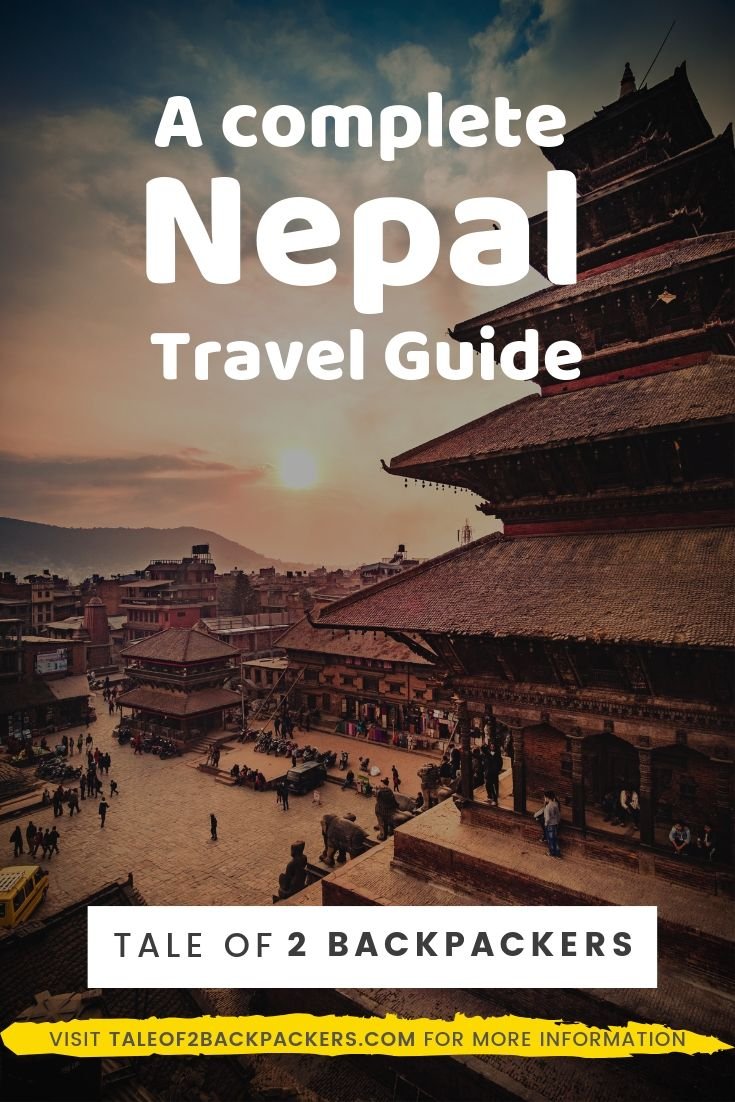
Enjoyed reading? Please share it with others.
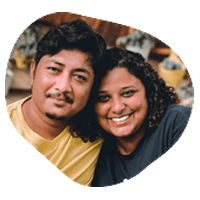
Agni Amrita
Related posts.
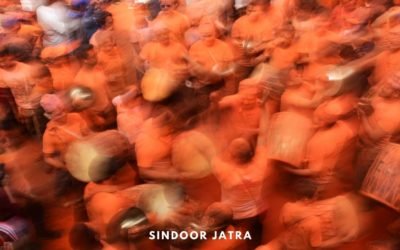
Sindoor Jatra – A Frenzy of Colours at Thimi, Nepal
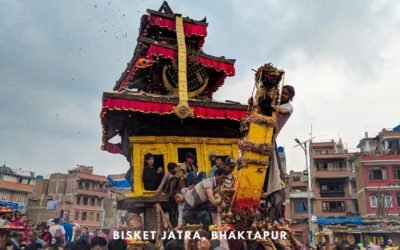
Bisket Jatra, Bhaktapur – A Visually Stunning Festival in Nepal
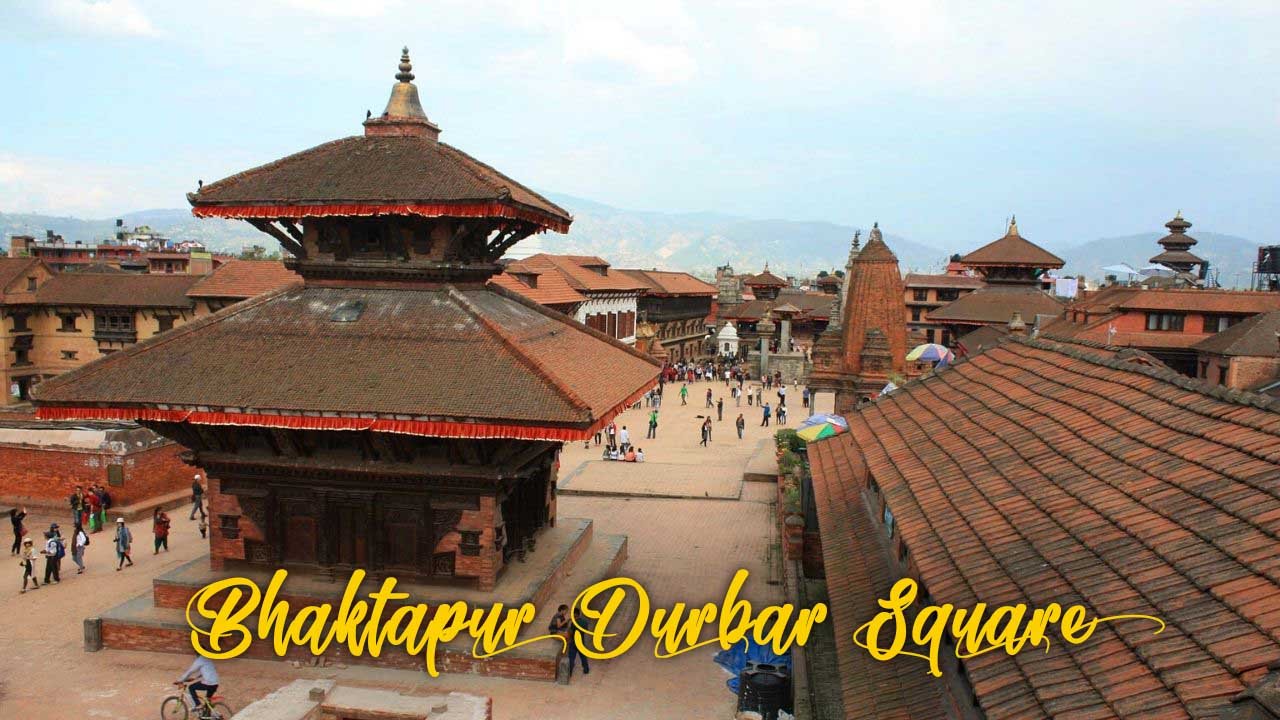
Bhaktapur Durbar Square – things to do in and around
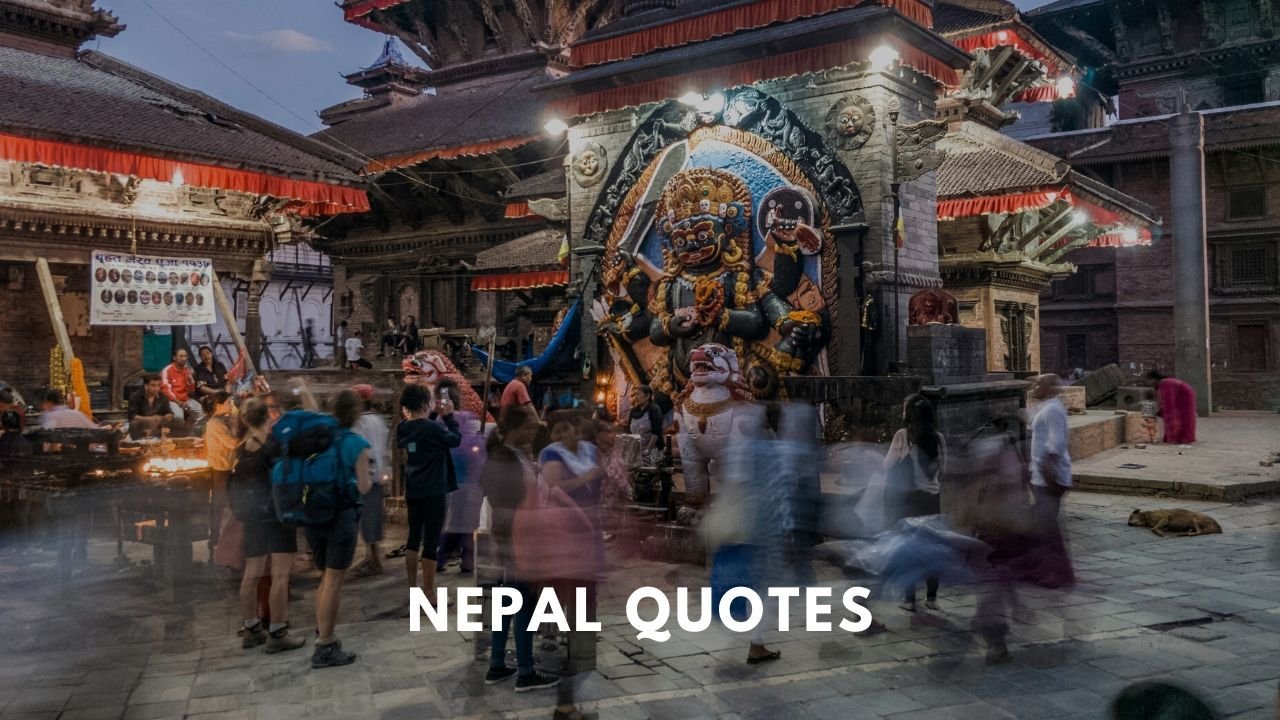
Best Nepal Quotes that captures its spirit, mysticism and charm
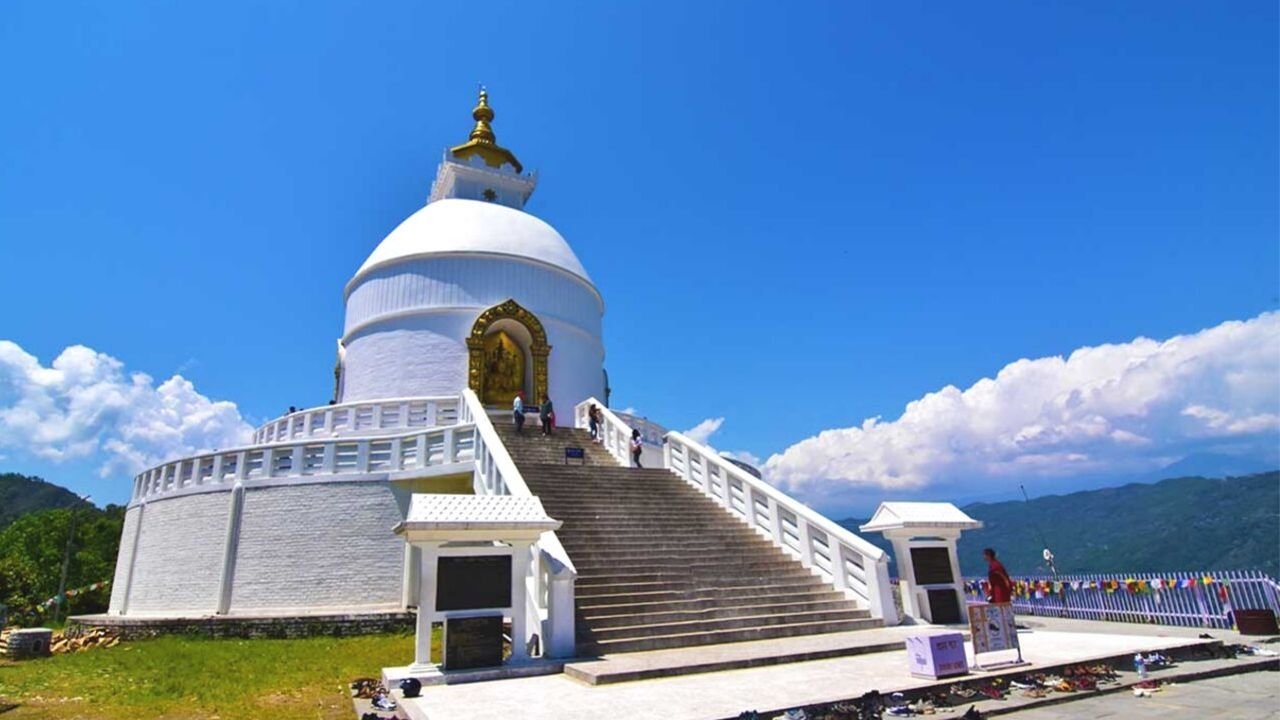
Places to visit in Pokhara – Travel Guide
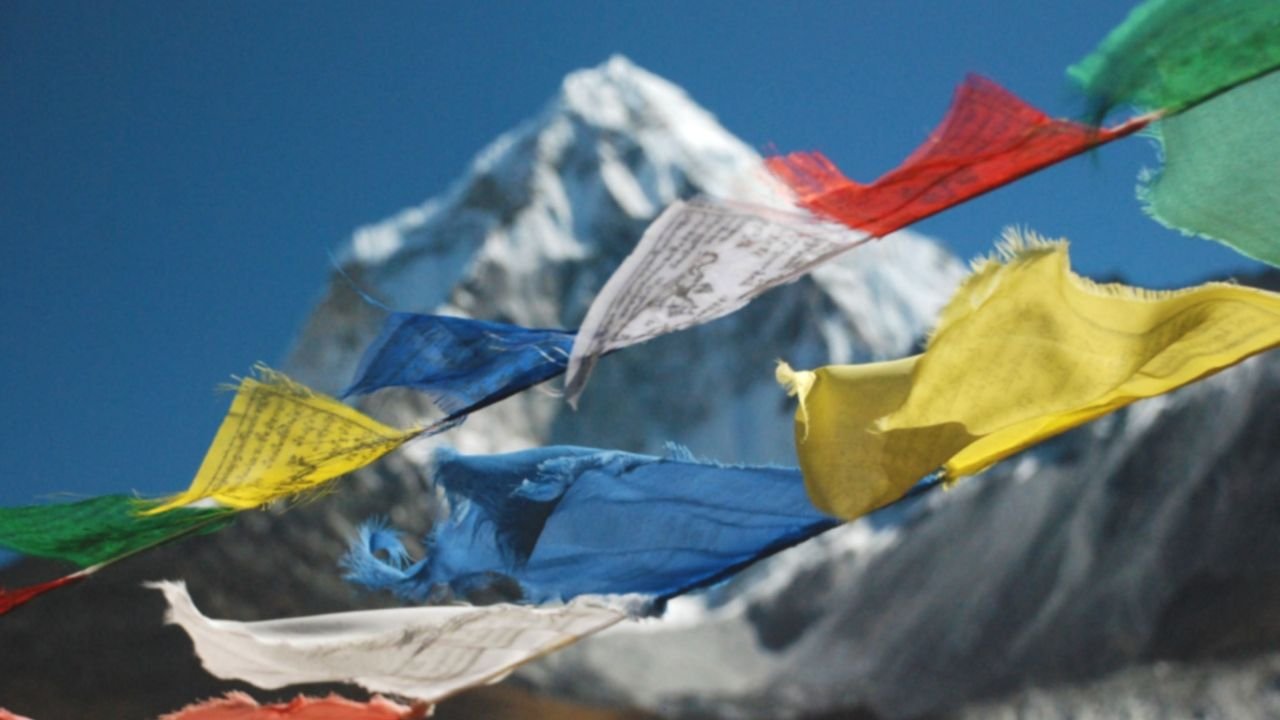
Trekking in Nepal: 15 Best Treks and all that you want to know
45 comments.
I have read many blogs regarding Nepal Visit but i found this is such an informative. Glad to read your blog. Thank you so much for sharing with us.
This DIY Nepal travel guide is a valuable resource for anyone planning a Nepal tour. It provides essential information on the best time to visit, visa requirements, and helpful tips. From the majestic Himalayas to vibrant markets, Nepal has something for every traveler. An excellent guide for a memorable trip!
This is great information and thanks you for the helpful article.
thank you for the detailed article…..
Great infomaction about Nepal tourism given. I love that you have provide so much practical information such as visas, transport and climate, before covering the sights. I knew about Kathmandu and Chitwan Pakhara, Nagarkot but less about , Bandipur and Lumbini!
Thanks for sharing this article it is very helpful for those who want to travel to Nepal. Through your blog, People easily understand Nepal and its culture.
Wounderful blog about Nepal.Thank you very much for sharing your travel experience in Nepal.
Wow this was such a thorough and helpful guide to Nepal. On top of that, your photography is just amazing! I think I would be most interested in visiting Kathmandu and the ancient village of Bandipur.
Thank you author for your article. Keep it up.
Hi Agni & Amrita Thank you so much for sharing your informative post, it is imperative who is willing to Visit the Himalayan country.
Thank you so much!
Why do you advise against elephant rides? Just curious. And thank you for the informative article.
We usually do not take an elephant ride because most of the animals are not treated well in the elephant camps. But we do not stop others if they want to take a ride! 🙂
This is really great blog about Nepal. All the needed information about traveling to Nepal is included. How to get visa to transportation, Cost to the best book about the travel information about Nepal. Thank you for such a great article.
Nice blog author. Thank you. Keep it up.
This is an old post but I found it very useful, Thanks for sharing!
Happy to hear from you Agni & Amrita…very informative… useful also… Thank you so much…
Thank you so much, Sarbari. Glad that you liked the post.
This was super informative! Nepal looks like a great destination to visit. So glad I came across your post to find out all this info!
Thank you so much, Stephanie. Glad that you liked the article.
I love Nepal, and I’ve been three times. Although each time I have had someone else making the arrangements. This is super helpful when I go back!!
Oh wow! 3 times. I am envious. 🙂
This is a real complete guide. After reading it, I feel like I am ready to go to Nepal! I love it – and also the photos are so vibrant and beautiful.
Thank you Adele. Please visit Nepal, I am sure you will love the place.
Thank you for sharing these detailed travel guide. We have been planning on visiting Nepal but was a bit concerned with the visa.
Happy to know that we can apply for an online visa and the fees are affordable.
Can’t wait to get started with the travel planning.
Oh wow! I am excited that you are planning to visit Nepal. It is a beautiful country.
What a nice guide to the country! It is nice to learn that the country is safe to travel.But does the earthquake take place often as well?
Thank you, Mijia. Well, it is difficult to predict nature. No major earthquake happened after that. Hope it remains such.
Nice information
I’ve read many blog about Nepal, and never I read any negative thoughts about this country. Truly rich in traditional culture, this is another destination that is worth visiting by anyone with open-minded heart. Thanks for spreading good news and views about Nepal. Those foods are making me hungry 🙂
Nepal is truly a lovely place. Thanks for liking it.
Wow this was such a thorough and helpful guide to Nepal. On top of that, your photography is just amazing! I think I would be most interested in visiting Kathmandu and the ancient village of Bandipur. I like the contrast of being able to see a well known and busy city contrasted with a quieter authentic village.
Thank you so much! Bandipur is realy an interesting place. The architecture there is simply mindblowing.
Since seeing the Dali Lama talk last year, I’ve always wanted to visit Nepal
Please do visit Nepal. It is a wonderful place.
What an amazingly comprehensive guide to Nepal. I love that you have provide so much practical information such as visas, transport and climate, before covering the sights. I knew about Kathmandu and Chitwan Park but less about Pokhara, Bandipur and Lumbini!
Thank you Kavita. We are glad that you liked the article.
Submit a Comment Cancel reply
Your email address will not be published. Required fields are marked *
Submit Comment
This site uses Akismet to reduce spam. Learn how your comment data is processed .
Pin It on Pinterest
Best time to visit Nepal

The best time to visit Nepal is pre- and post-monsoon (March to April and September to November), especially if you want to go trekking . Spring (March to May) is a particularly beautiful season as the rhododendrons are in bloom. That being said, there’s still lots to do even in the off-season (not to mention a jam-packed calendar of cultural and religious festivals), so you're bound to have a brilliant trip no matter when you go. Here’s our month-by-month guide to travel in Nepal.
Best for: crowd-free trails, clear skies, wildlife spotting in Chitwan National Park
January is a magical time to trek in the Himalayas thanks to little to no rainfall. Despite being the coldest month, there are consistently clear skies and the mountain views are some of the best all year. Popular treks like Everest Base Camp and the Annapurna Circuit typically aren’t busy, so there’ll be less foot traffic and fantastic photo ops on the trails.
If trekking isn’t your thing, January is slap bang in the middle of the dry season in Chitwan National Park, so it’s an ideal time to spot wildlife. It can be hectic in the capital of Kathmandu and other major cities due to domestic travelers celebrating the New Year, but it's a great time to immerse yourself in Nepalese culture if you enjoy the hustle and bustle.
Best for: trekking, small crowds, Maha Shivaratri, Tibetan New Year
The bite of winter in the high Himalayas eases towards the end of the month, and signs of spring start appearing. As an off-season, the trails are still crowd-free and sunny skies make for near-perfect trekking conditions (win-win!).
February is also a great month to experience some of Nepal’s major religious festivals. One of them is Maha Shivaratri, an auspicious Hindu festival that sees thousands of devotees gathering at Kathmandu’s Pashupatinath Temple to pray, chant and take part in rituals to worship Lord Shiva.
There’s also the Losar festival (Tibetan New Year) celebrated by the Sherpa, Tibetan, Tamang, Bhutia and Yolmo peoples. Each community has unique traditions, but they often involve ceremonial dances at local monasteries and family feasts of chaps (deep-friend pastries), guthuk (dumpling soup) and other specialties. You’ll undoubtedly be invited to join in the festivities if you’re trekking in the Himalayas.
Best for: Holi festival, trekking, spring blooms
One word: Holi! Nepal is a predominantly Hindu country, and Holi is a big deal. This ancient Hindu festival celebrates the eternal love between deities Radha and Krishna and the welcoming of spring. Expect a riot of color, folk music, roaring bonfires and lots of laughter as you join locals to (literally) throw bright-colored powders over each other.
March also marks the first of Nepal’s two peak trekking seasons (the other being September to November). The days get longer, and some higher-altitude trails become accessible again. The highlight of trekking in March is the beautiful rhododendrons that bloom and add a splash of red and pink to the (already incredible) landscape – there’s no sight quite like it. Some of the prettiest flowers are in Langtang Valley and the Everest Region.
Best for: trekking, spring blooms Bisket Jatra
April is one of the busiest months in Nepal, and for good reason. The warmer weather creates ideal conditions to tackle higher passes, and mountain meadows and forests are filled with sweet-smelling blooms. It can get quite hot towards the end of the month, with temperatures in Kathmandu and Pokhara reaching the low 30s. If you’re not keen on the heat, head out of the city to the Trisuli River to enjoy cooler temperatures and fresh air.
April also sees the eyebrow-raising festivities of Bisket Jatra, a nine-day festival to welcome the arrival of spring. Celebrated in Bhaktapur Durbar Square and Thimi, a massive chariot of two deities, Bhairav and Bhadrakali, is pulled through the city and two neighborhoods battle it out in an intense tug of war to bring it to their area. Crowds also throw vermillion powder over each other while singing folk songs and dancing in the streets.
Best for: trekking, Buddha Jayanti
May is the last month of spring (and the final month to trek before the monsoon). Temperatures begin to climb with hot and sticky conditions in Kathmandu Valley and Pokhara, but it’s glorious weather to hike up the mountains where a cooler climate awaits. Afternoon showers become more frequent towards the end of the month, but it’s usually not wet enough to disrupt your travel plans.
A highlight in May’s festival calendar is Buddha Jayanti, AKA Buddha’s birthday. Celebrated on May's full Moon, locals decorate their homes with pretty butter lamps, visit temples and monasteries in white clothing to make offerings and pray, and eat kheer (a sweet rice pudding).
Best for: thinner crowds, cultural activities
June marks the start of summer and the rainy season. While it doesn’t rain all day, you can expect some rain every day (the afternoons usually bring heavy downpours). Trekking isn’t recommended during the monsoon as the trails are muddy (and you’ll likely encounter leeches), rivers swell and thick cloud cover can hide the mountains.
If you don’t mind the heat, there’s plenty to do in Kathmandu (even when it’s raining). Stroll the city’s frenetic streets alongside holy men, monks and sacred cows, peruse the markets and bazaars or watch pilgrims bathing along the banks of the sacred Bagmati River.
Best for: scenic flights over the Himalayas, cultural activities
July is one of the quietest months in Nepal. Trekking isn’t recommended in some areas as the monsoon rains saturate the ground and increase the risk of landslides, though hikes in Kathmandu Valley are still doable. Frequent road closures can also make it challenging to get around.
If you’re itching to see the Himalayas, why not take off on a scenic flight from Kathmandu? You’ll be treated to stunning views of the Himalayas in just an hour. You could also learn how to whip up Nepalese fare at a cooking class or visit one of the city’s many temples.
Best for: Twenty Thousand Lakes, Everest Base Camp trek with small crowds
The rain eases at the end of August and the landscape starts flourishing with greenery again. Everest Base Camp treks kick off again, and while it's warm and wet at lower elevations, the weather will get cooler and drier as you ascend the mountains. The plus side is that there aren’t as many trekkers, so you’ll have the views (almost) all to yourself.
August is also a great month to visit Twenty Thousand Lakes (Bis Hajaar Tal) near Chitwan National Park. Explore a maze of small lakes teeming with wildlife, including crocs and hundreds of migratory bird species. If you’re lucky, you might spot the Indian rhino.
Best for: trekking, white water rafting, Indra Jatra festival
The monsoon usually ends mid-September and clouds make way for blue skies. Hikers return to the trails in large numbers towards the end of the month as conditions continue to improve and teahouses (guesthouses) open up again. With high river water levels, thrill seekers can get their kicks on a white water rafting adventure on the Trisuli, Bhote Kosi or Upper Seti rivers.
If you’re in Kathmandu, be sure to check out the Indra Jatra festival, where you can watch the chariot of Kumari, Nepal’s Living Goddess, carried through the streets to a procession of loud drums.
Best for: trekking, white water rafting, camping by the Trisuli River, Dashain
October marks Nepal’s second trekking season of the year. Trail conditions are near-perfect, and you’ll be treated to incredible views of the Himalayas thanks to clear skies. If you want to tick off Base Camp, Annapurna or Poon Hill, now’s the time. Just remember that it’ll be busy (October is one of the peak tourist months).
White water rafting season is also in full swing, and now that the heavy rain has stopped, you can camp under the twinkling Nepalese skies on the banks of the Trisuli River. Culture vultures will also love Dashain, a two-week festival in honor of the Hindu goddess Durga. Expect elaborate pujas (prayer rituals), feasts, kite flying, and sword and music precessions.
Best for: trekking, Diwali
Prime hiking conditions continue into November with very little rain, low humidity and clear skies. The temperature gets considerably colder, but a few extra warm layers are worth it for the unobstructed vistas.
If you’re around for Tihar (also known as Diwali), you’re in for a real treat. Hindus, Jains and Sikhs celebrate this religious festival to deter darkness with light and celebrate the triumph of good over evil. Thousands of lights illuminate Nepal's cities and towns, fireworks light up the sky and locals draw beautiful mandalas outside their homes.
Best for: wildlife watching in Chitwan National Park, smaller crowds
Crowds start to thin out as icy temperatures take hold. However, the weather is mostly dry, so if you don’t mind layering up, it can be a magical time to explore with a backdrop of the snow-clad Himalayas. It’s much warmer on lower ground and in the country's southern reaches, which can see highs of 77°F.
December is one of the best months to discover wildlife in Chitwan National Park as it’s dry and the visibility is excellent. You might get lucky and spot tigers and larger animals as they tend to congregate around waterholes.
Let's create an exclusive trip for your group.
The silly side of small group travel you have to experience to understand
Yeah the girls: meet the female leader challenging gender norms in Nepal
It’s official: Phurba Sherpa is the world’s best outdoor guide
The top 10 destinations to travel in May 2024
What to pack for a hike: An essential checklist
Meet the 3 Intrepid leaders nominated for the 2023 World Guide Awards
10 awesome places to go for your 21st birthday
Peak romance: The intrepid couple who met trekking to Everest Base Camp

2 Weeks in Nepal: 3 Itineraries
DISCLAIMER: This post might have links to travel services and products that we enjoy. We might make a commission from it at no extra cost to you.
Nepal is one of the most popular destinations located in the Himalayas mountain range . A chance to get close enough to the ceiling of the world. The home of the highest mountain, unique animals, and the home birth of Buddha and Gurkha elite fighters.
Being a landlocked country, Nepal’s tourism is driven by trekkers of Everest Mountain . Today, almost 80% of foreign visitors to Nepal come for the mountain. However, if you only have 14 days, can you even go on a trek? Is there something else worth seeing here?
This 2 weeks in Nepal itinerary will answer exactly that. This guide includes travel itineraries for Nepal, covering both trekkers and non-trekkers. I also listed below everything you need to know before you plan and book your trip to Nepal.
CHECK OUT: 2 weeks in India itinerary
THINGS TO KNOW BEFORE VISITING NEPAL
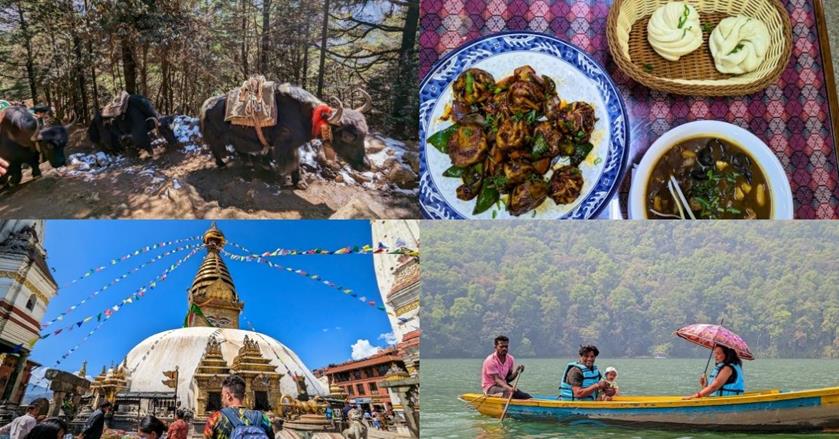
You don’t want to travel halfway across the world just to find out you’re visiting at the wrong time or planning a trip that’s too cramped. Below are answers to basic things you should remember about spending a vacation in Nepal.
When is the best time to go to Nepal
The best time to visit Nepal, particularly for the Everest Base Camp Trek, is during the pre-monsoon season (March to May) or post-monsoon season (late September to November). During these periods, the weather is usually clear, providing stunning views of the Himalayas, and temperatures are moderate, making it ideal for trekking.
It is advisable to avoid the monsoon season (June to early September) when heavy rainfall occurs. Additionally, Nepal doesn’t experience typhoons but the monsoon season brings heavy rain and potential landslides, which is not ideal for outdoor activities.
March to May is also the Everest Base Camp summit season , meaning the window time for people who want to climb Everest Mountain to come to Nepal. During this time, it’s very busy, and many teahouses in the Khumbu region are fully booked. Hence, planning is necessary.
If you plan to trek other trails, you should also know when the best season for that. For example, the summit season for the beautiful Ama Dablam is between October and November, but that’s not the right season to summit Everest Mountain.
Keep in mind that it is very cold in many areas of Nepal during the winter season. Not many hotels in Kathmandu or Pokhara have central heating.
Are 2 weeks enough for Nepal
Well, that depends on what you plan to do. For trekking at Everest Base Camp (EBC) or Annapurna Base Camp (AB), that’s definitely enough, but that’s all you can do. This means that If you plan to go to Chitwan or Pokhara after the EBC trek, that’s impossible.
But if you plan to trek ABC, which is only 7 days, you will have extra time to go to Chitwan and other parts of Nepal.
How to get around
Getting around Nepal can be tricky. Due to being a hilly country in general, flying always comes with a challenge, and it’s not the most affordable. On the other hand, taking the bus is long and very uncomfortable.
Nepal is a developing country, like literally. Many roads are under construction, making road travel super bumpy and taking longer. For example, our bus from Kathmandu to Pokhara was supposed to take 6-7 hours, but because the road was not finished, it took 10-12 hours.
Around the cities, you should install ridesharing and ride-hailing travel apps similar to Uber and Grab. The most popular transportation app in Nepal is Pathao, but you can also try Sahara.
You can pay in cash with these apps. However, it mostly works in Kathmandu only, although it won’t take too long until it’s available for Pokhara and other parts of the country.
Language and currency
Nepali (Nepalese) is the main language in Nepal. However, a large population of the country speaks English well. Around tourist areas such as Kathmandu and Pokhara, you wouldn’t have a hard time communicating with the locals.
The currency here is Nepalese Rupees (NPR). Most transactions are done in cash, but you can pay with your card at tour agencies, hotels, restaurants, and major stores. But it’s vital that you carry cash with you at all times.
There are many ATMs around the country, but most will only allow you to withdraw $70 to $100 (10,000 to 15,000 NPR). Go to the ATM of Nabil Bank, which allows you to withdraw up to 30,000 to 40,000 NPR ($230 to $300) per transaction. This will save you in ATM withdrawal fees.
Nepal has a very easy tourist visa. It’s one of the very few countries that allow almost all nationalities to enter and travel around Nepal for up to 90 days at a time. However, it’s not free unless you hold a passport from India.
The rest of the world must apply for an evisa before you arrive or get a visa on arrival. You can choose between 15, 30, and 90 days, which costs between $30 to $125. You can extend your visa for a minimum of 15 days for $45, and $3 for additional days after that.
I recommend you get the visa arranged in advance , meaning apply online versus getting it upon arrival.
This is because if you plan to get the visa on arrival, you will have to wait in a queue to use the “visa machine” where you fill in your information and usually, there are only 2-3 machines, which takes a long time.
If you already have one from the online application, you just proceed to the payment booth and be done. Make sure to bring:
- printed or digital copy of your evisa (printed might be better)
- cash in USD, GBP, or Euro (your change will be in NPR)
- no credit card payment
- a passport photo
What is the average cost for 2 weeks in Nepal
A great budget for 14 days in Nepal is around $1000 for a single person . Accommodation and food is cheap. Transportation could cost a bit more than its neighbouring country, but still good range.
If you plan to stay in hostels, you can save even further and bring the budget down to $800 for backpackers . For those planning to stay in high-end hotels, around $2,000 is a good idea for a luxury trip .
Keep in mind that this doesn’t cover your flights to and from Nepal, travel and medical insurance (which is required for treks 5,000 m and above). If you’re booking a trek, best to budget it at $100 per day just to be sure.
Other basic travel tips
Whenever you’re ready to plan your trip , below is a list of great sites to book your hotels, flights, and even insurance. I recommend that you book the hotels in advance. There are lots of accommodations, but the good ones get fully booked early and the mid-range hotels can be at a mediocre level.
PINNED MAP OF TOP THINGS TO SEE IN NEPAL
Click the icon on the top right to enlarge the map. Credit: map data: Google
2 WEEKS IN NEPAL ITINERARY
Nepal offers natural beauty and a rich culture. The country boasts eight of the world’s fourteen 8,000-meter peaks, including Mount Everest, making it a paradise for trekkers and mountaineers.
Temples, stupas, and ancient palaces abound, and festivals colour the streets year-round. The warmth and hospitality of the Nepali people add to the unforgettable experience. Below are the travel itineraries for Nepal, see which one suits you best.
When I decided to take a trip to Nepal, my main objective was to hike the famous Everest Base camp trek. That idea came to me before the pandemic, and I was not able to fulfil that goal until after the international borders had opened.
And once I got there, it was so much better than I imagined. The Nepalese people are super friendly and welcoming, the accommodation is affordable, and there are loads of things to do.
I started my trip in Kathmandu just like everyone else. In this list of itineraries for 2 weeks in Nepal, you can choose between including hiking or without hiking on your travel plan.
Itinerary #1: Trekking the EBC
This itinerary is suitable for those who plan to trek the famous Everest Base Camp. The actual trek actually takes only 11 days, but the 3 extra days are for preparing in Kathmandu at the beginning, a day for getting from Lukla (Khumbu region) back to Kathmandu, and an extra day to prepare for your departure from Kathmandu back home.
We have an in-depth guide for 14 days Everest Base Camp trek which will give you everything you need to know. This includes when to go, what to pack, doing a tour vs not, policies, what to expect, day-to-day expectations, how much to spend, and so much more.

Kathmandu before the trek
Spend a day in Kathmandu after you arrive to gather everything you need. Most people go to rental shops to rent sleeping bags and down jackets. Some people would buy hats, gloves, a duffle bag, and snow pants for the hike.
If you booked a tour, this is also the time you want to say hi to the tour company, get briefed on what time you’re leaving the next day for your flight to Lukla, and discuss what the trek will be like.
You’ll also meet your trekking guide , and if the tour company is generous enough, they will also give you a duffle bag for you to keep. You will meet your porters once you arrive in the Khumbu region (Lukla).
Porters prefer to carry a duffel bag over a hiking backpack. So, if your tour company is not providing one, it’s better to get a duffle bag. It will cost between $15 to $20. Spend this day to get cash as well. Plan around $30 a day if food and lodging are covered on the tour.
If not, it’s best to budget $100 which will cover your accommodation, food, drinks, and snacks. Not to mention payment for your independent tour guide and porter.
Leaving Lukla
Now that your trek is finished, your last day in the Khumbu region is about flying from Lukla and back to Kathmandu. Keep in mind that if you’re travelling during summit season, you might be flying to Manthali/Ramachep instead of Kathmandu due to busy air traffic.
If that’s the case, from Manthali, there’s another 6-hour drive from there to Kathmandu. If you’re on a booked tour, this will be arranged. If not, it’s very important that you arrange this beforehand because Manthali can be a rural area and arranging this last minute can be costly.
Kathmandu after the trek
Spend your last day in Nepal by returning your rented items and buying some souvenirs. This is also the time to arrange how you plan to get to the airport and get debriefed by the tour company.
If you have a few days extra, you should look into walking tours and/or day trips that you can book to maximise your time.
Itinerary #2: Trekking and More (Kathmandu, Chitwan, Pokhara, Annapurna)
This next 2 weeks in Nepal itinerary is perfect for people who want to do some trekking on the stunning Himalayas and also explore other parts of Nepal . For this trek, you will be conquering Anapurna Base Camp, also known as ABC.
Then, you will also get to spend time in Kathmandu, Chitwan National Park, and Pokhara. This itinerary is tight, but with good planning, it can definitely be done.
I also recommend you consider skipping Pokhara, you will be there to get to Annapurna, but expect that you might not have enough time to explore it.

Kathmandu for 2 days
Two days in Kathmandu is not a lot, but don’t worry, you’ll have an extra day at the end of this trip. For the first 2 days, plan to do a walking tour which will maximise your time here by visiting all the must-see spots in the capital city.
Chitwan for 2 days
After Kathmandu, it’s time to head to the famous Chitwan National Park where you can see wild animals such as elephants, Bengal tigers, and rhinoceros. Remember that you must go on a guided tour to Chitwan for your and the animal’s safety.
Avoid riding elephants in Chitwan. This is a common practice, but you have the power to not fuel this activity. Nepal’s neighbouring countries in Southeast Asia have started banning this tourist activity. There is more than one way to enjoy South Asian elephants without being cruel to them.
There are plenty of accommodations outside the national park and getting there from Kathmandu is not a problem. There are lots of buses that will take you, and the travel time is around 5-6 hours or even more if the roads are under construction, and the cost is $6 to $7 (600 to 800 NPR).
Pokhara for 3 days
Pokhara is a great place covered in trees, centred by a lake, and accented by the Himalayan mountains. The only downside here is the smog. During the spring season, the air and humidity in Pokhara can be unbearable. You can’t see the mountains and feel like the air quality is questionable.
This is because the city sits on a valley . Before the typhoon season, the wind blows towards Pokhara. But then due to its location, the wind and pollution from other parts of the country get trapped above Pokhara creating thick smog.
During my visit to Pokhara, the air wasn’t good and I couldn’t see the Annapurna mountain range (but it was hike-able), but I still had a great time. I booked walking tours, went to the lake to rent a row boat, and did whitewater rafting.
You can reach Pokhara from Chitwan via bus . The travel time is around 5-6 hours and the ticket is about 1,000 to 2,000 NPR ($10-$20).
Annapurna Trek for 7 days
Your adventure for Annapurna starts in Pokhara. If you’re going with a tour company, they will be briefing you a day before and arrange the time to pick you up the next day. The trek is for 7 days and there will be multiple ways to get to the Base Camp, which you and your tour guide will be discussing in advance.
Spend a day shopping for other things that you need for the hike such as a sleeping bag, snacks, a pair of gloves, and water tabs.
Depending on your arrangement with the tour company, they will either transport you back to Pokhara or Kathmandu at the end of the trek.
Itinerary #3: No Trek (Kathmandu, Chitwan, Gorkha, Pokhara)
You can surely travel and spend 2 weeks in Nepal without doing any treks . There is more than one way to explore this country and its beauty.
There are lots of people I met in Kathmandu and Pokhara who weren’t doing any hikes and planned their trip around learning about the culture, and people, and admiring the natural beauty.

Kathmandu for 4 days
Travel slowly through the capital city and make sure that you see and explore all the top attractions. Visiting Kathmandu is a melting pot of history and modernity, which means you can learn and experience both the old and new world.
There are lots of ancient ruins and temples that you can visit, but also see how far it has come to modernisation.
The city’s ancient temples and stupas, such as Swayambhunath and Boudhanath, offer spiritual experiences and insights into Buddhism and Hinduism. The lively streets of Thamel are perfect for shopping and savouring local cuisine.
I found this restaurant in the heart of Thamel called Spize (Karnali Organic Thali) , which offers traditional Tibetan dishes. I think I ate here so many times during my visit and can’t recommend it enough. My favourite dishes were momo, Mustang chicken, and the lassi.
Chitwan for 3 days
One thing I want you to avoid is riding an elephant. You’ll see that many posters for tourists going to Nepal are of people riding elephants.
Not only are you supporting an unethical and cruel treatment of elephants , but you are also wasting your time. You can still appreciate this anima’s beauty in so many ways when you visit Chitwan.
Visiting Chitwan National Park in Nepal offers an exhilarating escape into the wilderness. As a UNESCO World Heritage Site, it’s renowned for its biodiversity including the endangered one-horned rhinoceros and Bengal tigers.
There is a jungle safari via jeep where you can spot elephants, Bengali tigers, and monkeys.
Gorkha for 3 days
Visiting the Gorkha region in Nepal is an adventure that takes you to the historical roots of the Nepali kingdom. It is famously known as the birthplace of Prithvi Narayan Shah, who unified Nepal.
The iconic Gorkha Durbar is a fortress palace situated on a hilltop, offering panoramic views of the snow-capped Himalayas.
The region is also a gateway to the Manaslu Circuit Trek, but that takes 14 to 18 days. Gorkha is a destination that offers a blend of culture and adventure. Don’t forget to visit the Gorkha Museum as well to learn about Nepal and the Gorkha region.
Gorkha is directly north of Chitwan. There are buses, but they can be limited, so planning in advance is crucial. The driving time is around 3-4 hours and the ticket will cost 500 to 700 NPR ($5 to $7).
Pokhara for 4 days
Pokhara is known for many things including yoga retreats. But if you’re looking for a thrilling activity , don’t miss white water rafting, paragliding with a Himalayas backdrop, hot-air balloon riding, and ATV drives, to name a few.
Don’t miss out on boating around Phewa Lake, which is surrounded by the Annapurna range. It is a nice experience, and you can enjoy the lake and its serene atmosphere. There are plenty of boat rental places all around the lake, and they all have the same price since they’re regulated by the local government.
You can also visit the Peace Pagoda for panoramic views, or explore the mystical Gupteshwor Cave. Pokhara’s laid-back ambience is a perfect contrast to Kathmandu’s hustle.
THINGS TO SEE AND DO IN (per city)
There are so much to do all around Nepal including hiking, city exploration, yoga retreats, and wild animal safaris. There is honestly something for everyone – including cooking classes. I wish I could stay longer, but perhaps that more reason to come back.
Here is a list of things to do during your 2 weeks in Nepal and tours that you can book to make the trip more convinient:
- Explore Kathmandu – do the UNESCO World Heritage Sites tour or a full-day Kathmandu tour
- Kathmandu Durbar Square
- Narayanhiti Palace Museum
- Do a whole day massage and spa with lunch
- Garden of Dreams
- Pashupatinath Temple and Bodnath Stupa – guided tour
- Shankhadhar Park
- Go white water rafting – read the tour reviews
- Dharahara Tower
- Discover Nepalese cuisine by joining a cooking class in Thamel or sign up to a walking street food tour or a walking food tour at local eateries
- Boudha Stupa
- Pashupatinath Temple
- Sunrise hike to Nagarkot – see the tour details
- Swayambhunath Temple
- Day trip to Nagarkot and Bhaktapur – book your spot
- Bhaktapur Durbar Square
- Half-day tour to Chandragiri to ride the Cable Car – look at the tour price first
- Patan Durbar Square
- Go on a helicopter tour to Everest Base Camp from Kathmandu – either over the air only or including a landing at the base camp
- Amitabha Monastery Hike
- Kakani Hike (viewpoint at Kakani View Tower)
- Phulchowki Temple Hike
- Nagarkot Trail Hike – see the sunrise tour details
- Sundarijal Waterfall
- Shivpuri Nagarjun National Park
- Go paragliding – read the reviews
- Mahendra Cave
- Go Bungee jumping – see the tour price or fly over Sarangkot
- International Mountain Museum
- Davis Falls
- Zip lining – experience the world’s steepest zip-line
- Seti River Gorge
- Explore Nepalese cuisine – join a cooking class
- Pokhara Canyoning
- Visit Tibetan Settlements – either book a full-day or a half-day tour
- Muldhai Viewpoint
- Annapurna – do a day hike to the Australian camp or the Annapurna and Upper Mustang trail
- Poon Hill Sunrise Viewpoint – book a 5-day hike for Poon Hill and Ghandruk
- Dhampus View Tower
- Ghorepani Poonhill
- Panchase Hilltop Heliport
- Sarangkot View Tower
Everest Base Camp Trek
- EBC hike 14 days (with food)
- EBC hike 14 days (w/o food)
- EBC helicopter tour (with landing)
- EBC helicopter tour (no landing)
Annapurna Base Camp Trek
- Annapurna base hike 14 days
- Annapurna foothill hike 8 days
MUST-TRY NEPALI DISHES, DRINKS, AND SNACKS

Nepali cuisine is one of the best foods I’ve ever had in Asia. The best way for me to describe it is to compare South Asia with East Asia. You got the curries and also dumplings, it’s all rich in flavour, taste, and colour.
Make sure to try at least 3-4 foods. If you’re hiking, I’m sure you won’t be able to avoid Dal Bhat. Here’s a list of recommended dishes from Nepal:
- Dal Bhat – a staple Nepali meal consisting of lentil soup (dal), rice (bhat), and usually served with vegetable curries and pickles
- Momo – Tibetan-style dumplings filled with meat or vegetables, often served with a spicy dipping sauce
- Gundruk – fermented leafy greens, often served as a soup or a side dish
- Chatamari – a Newari dish, often referred to as Nepali pizza, made from rice flour with meat toppings
- Sekuwa – grilled meat skewers, usually marinated with spices and herbs
- Thukpa – a hearty noodle soup with meat and vegetables, influenced by Tibetan cuisine
- Panipuri /Golgappa/Puchka – a popular street food snack consists of a round, hollow deep-fried crisp bread, which is filled with a mixture of smashed tamarind chutney, chilli, chaat masala, potato, onion, chickpeas or white peas
- Sel Roti – a traditional, sweet, ring-shaped rice bread, common during festivals
- Juju Dhau – A famous creamy yoghurt from Bhaktapur, known as the “King of Yogurts”. It has a rich, creamy texture and a slightly sweet flavour
- Yomari – A Newari dessert made from rice flour dough shaped like a fig and filled with a mixture of molasses and sesame seeds
- Sikarni – a yoghurt-based dessert, mixed with dried fruits, sugar, and spices like cinnamon and cardamom
- Chiya (Nepali tea)
- Lassi – a yoghurt-based drink which can be either sweet or salty
- Tongba (Hot Millet Beer) – A traditional alcoholic beverage made by fermenting millet
- Sherpa Beer
ACCOMMODATIONS
To help you even more with planning your trip, here’s a list of my recommended places to stay in Nepal. There are options depending on your budget and arranged by city.
- Affordable: Flock Hostel or Shantipur Kathmandu
- Mid-range: Kumari Boutique Hotel or Hotel Jampa
- Luxury: Arushi Boutique Hotel or Hotel Blue Horizon
- Affordable: Chital Lodge or Kasara Resort or Hotel Tree Tops
- Mid-range: Shanta Ghar or Hotel National Park
- Luxury: Hotel Siraichuli or Tiger Tops Tharu Lodge
- Affordable to Mid-range: Universal Hotel & Lodge or Gorkha Garden Hotel
- Affordable: Hotel Cherry Garden or Pokhara Backpackers Hostel
- Mid-range: Bodhi Suites Boutique Hotel & Spa or Hotel Middle Path & Spa
- Luxury: Hotel Portland or Bar Preepal Resort
SUMMARY OF 2 WEEKS IN NEPAL ITINERARY
Spending 14 days in Nepal is an enriching experience that offers so much. From the lofty peaks of the Himalayas to the lush jungles of the Chitwan, the diversity in landscapes is awe-inspiring.
The warm smiles and the hospitality of the Nepali people stay with you long after you leave. Whether it’s the challenge of a trek, the tranquillity of a spiritual retreat, or the thrill of adventure sports, Nepal offers something for every traveller.
I hope that this list of itineraries for 2 weeks in Nepal has been helpful in planning your trip and visualising what to expect.
TO SAVE THIS ITINERARY, PIN THIS IMAGE BELOW:

- Deutschland
Best Time To Visit Nepal
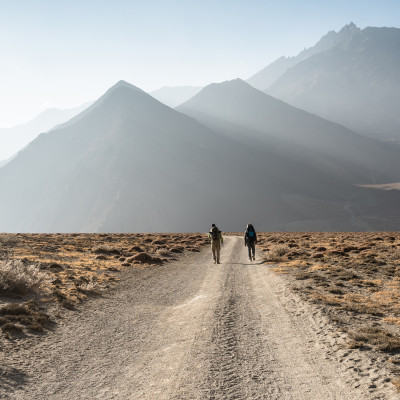
Nepal through the seasons
The best time to visit Nepal is during the months of October and November. The monsoon is over, which means magnificent, green, lush vegetation as well as clean air – the perfect time to explore the country in all its beauty, especially given the mild temperatures. This is also the time the views of the peaks of the Himalayas are nearly picture perfect.
May is considered low season and we recommend not visiting the country from June to mid September.
Best Time To Visit
We recommend.
- The mountain views are the best in winter so you could opt for a short trek at low altitudes
- Visit Chitwan National Park and try and spot the big five – the one-horned rhino, the Royal Bengal tiger, the Asian elephant, leopard and the Himalayan Sloth bear
- Witness the colorful Maha Shivratri celebrations (A Hindu festival worshipping Lord Shiva) at the Pashupatinath Temple
- Head out to one of the popular trekking trails in the Everest or Annapurna. But book early as these are usually in high demand!
- Get the adrenalin flowing with a white water rafting trip
- Fly and get up close and personal with the Everest, as you soak in stunning aerial views of the Tibetan Plateau’s lakes and glaciers
- Enjoy the festivities around the Nepali New Year
- Get the adrenalin flowing with a short kayaking trip given the weather will be warm
- Spend time at the several restaurants across Kathmandu sampling Nepalese cuisine, or participate in a cooking class at a local’s home
- As the Mustang region falls in the rain shadow area of the Himalayas, it is relatively dry during this time, which means you can trek in the upper and lower Mustang region
- Nepal’s rice fields will be a lush green at this time, so why not capture stunning photographs of the panoramic landscape?
- Enjoy the various trekking trails around Pokhara, with its crystal clear lakes, turbulent rivers, deep gorges, and picturesque valleys
- Be part of the Dashain, the most auspicious religious celebration in the country, which usually begins end September and head into October
- Visit the small town of Nagarkot to savor panoramic views of the Himalayas and get a taste of village life
- Stroll through Kathmandu’s backstreets, catching glimpses of art and daily lives
- Kathmandu Valley is a World Heritage Site so make sure you visit the Durbar Squares, Patan and Bhaktapur, the Buddhist stupas and the Hindu temples
- Attempt one of the most popular long treks (21 days), the Annapurna trek, which takes you along the edge of the Tibetan Plateau and through the Thorung La Pass (5,400 meters)
- To catch a glimpse of Nepali village life, stop off at the quaint Newari village of Bandipur, en route to Pokhara or the high-altitude Sherpa village of Namche Bazaar in the Everest region
- Tihar or the festival of lights is usually celebrated in Nepal in November and is the country’s second-biggest religious festival
- Visit the town of Dhulikhel with its panoramic views of the Himalayan range, enchanting temples, and exquisite local handicrafts
- Indulge in a spot of mountain biking
Best Time to Visit Nepal by Season
The weather patterns are largely predictable. There are four seasons in Nepal:
- Spring from March to May
- Summer from June to August
- Autumn from September to November
- Winter from December to February. The monsoon season lasts from late June to mid-September, while it is relatively dry the rest of the year.

What to Pack for Nepal
There are largely no clothing restrictions in Nepal and you can wear what is most comfortable and weather appropriate. Choosing to be formal or casual is entirely up to you. Traveling in mountainous regions means experiencing a wide range of temperatures across 24 hours. During the day it can be quite warm, whereas at night temperatures can drop dramatically. Crossing over a pass requires an extra layer of clothing just for an hour or two. Lightweight and tropical clothes with umbrellas are advised from June to August. Between October and March, lightweight clothes with a coat for the evenings and warm clothing for the mountainous areas are recommended.
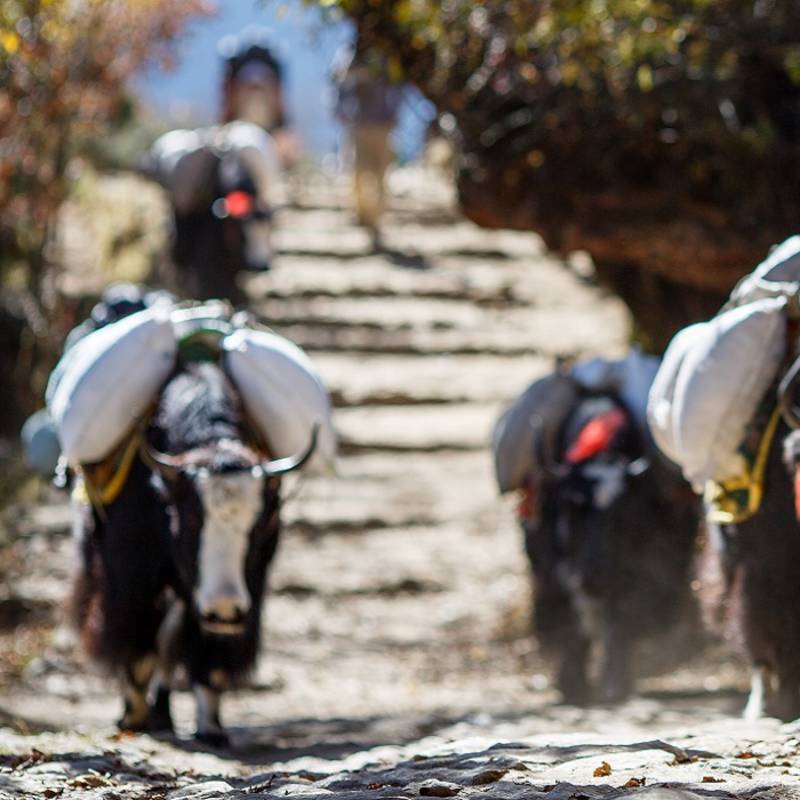
Popular Trips to Nepal
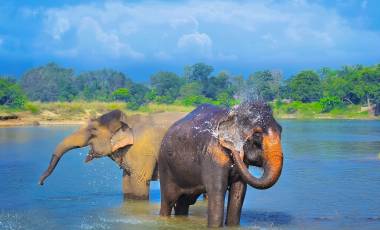
Nepal & Bhutan: Highlights
Discover the Himalayan kingdoms of Bhutan and Nepal on this 16-day tour. Start your journey in Kathmandu, the capital of Nepal, and take in its magnificent UNESCO World Heritage sites. Go on an exciting safari at the Royal Chitwan National Park and bask in panoramic mountain views in the scenic town of Dhulikhel. Continue your…
![how much time to visit nepal Enchanting Travels Nepal Tours Women in sari standing on the boat,Phewa lake,Pokhara city ]](https://res.cloudinary.com/enchanting/q_70,f_auto,w_380,h_230,c_fill,g_face/enchanting-web/2023/09/Enchanting-Travels-Nepal-Tours-Women-in-sari-standing-on-the-boatPhewa-lakePokhara-city-.jpg)
Undiscovered Nepal: Lower Mustang, Kathmandu and Pokhara
Take an unforgettable journey into Nepal’s unexplored destinations where few tread! This private Nepal tour introduces you to the Lower Mustang region where you will explore hidden gems such as Kagbeni, part of the Annapurna Circuit Trek and the windiest city in Nepal! At Jomson, you have the chance the discover one of the world’s…

Classic Nepal for Beginners
From its lofty mountains to its warm people, Nepal is yours to discover! Home to enchanting UNESCO World Heritage sites, give in to Kathmandu’s mesmeric charm before you tackle lofty heights at Pokhara. In Chitwan, befriend a herd of elephants or laze by the Rapti, and soak in the undiscovered, tranquil charm of Dhulikhel. Your…
Best Places To Visit

Kathmandu is a Himalayan valley kingdom, cradled within the foothills of mighty peaks. The city is home to seven UNESCO World Heritage sites and several other attractions, such a carved rose-brick pilgrimage sites, artistic workshops, and cafes and courtyards brimming with friendly local families.

Pokhara has it all – a picturesque valley nestled amid majestic mountains, glorious adventure trails and delicious cuisine! Originally envisioned as a center of commerce, the city’s roots can be traced back to the 17th century, when it featured on the trade route between India and China.
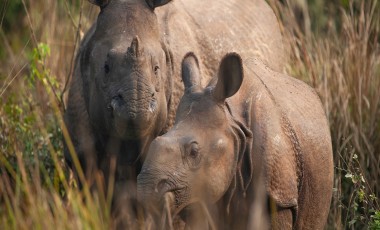
Chitwan: A wholly different experience! Chitwan is home to one of Asia’s finest National parks and one of the most traditional and conservative indigenous people of Nepal – the Chepangs.

Dhulikhel: Undiscovered gem Dhulikhel is a scenic and ancient town located east of Kathmandu with panoramic views of the Himalayan range, enchanting temples, exquisite local handicrafts, and friendly and intriguing culture.

The second highest point on the valley rim at an elevation of 7,200 feet, Nagarkot boasts panoramic views of the Himalayas and is ‘so near yet so far’ from the maddening crowd of a bustling city.
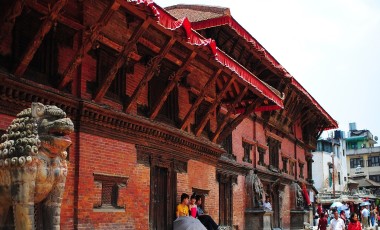
Patan is one of three royal cities in the Kathmandu Valley, located on the southern side of the Bagmati River and about half a mile south of Kathmandu.
Things To Do
From towering mountain peaks to incredible hiking opportunities and cultural delights – Nepal holidays are a joy! Our destination experts share their personal favorite highlights.
Travel Guide
Discover the most essential details before you travel to Nepal, from visa formalities to combating altitude sickness in the Himalayas, and everyday traditions, in our Nepal travel guide.
From the Blog
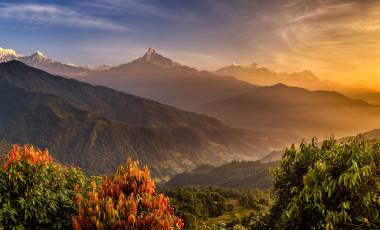
Climb every mountain: Why you need to plan a Nepal holiday
On your Nepal holiday, find spiritual bliss in the ancient temples of Kathmandu, many of them UNESCO World Heritage Sites, bathe elephants at Chitwan National Park, or challenge yourself with treks in the Himalayas.
What Our Guests Say

The Enchanting Difference
Authentic & unique.
Our award-winning, licensed local guides provide incredible insights and exclusive experiences for you.
Personalized & Private
Our experts completely customize your private tour to match your interests and preferences.
High-Quality Experiences
All our accommodations and services are personally tested by our team.
Fully Supported Travel
You’ll have a personal and dedicated trip coordinator, backed by 24/7 support in case of emergencies while you’re traveling.
Financial Protection & Flexibility
Your booking is flexible and completely secure with us.
Safe & Secure
Your safety and well-being are our top priorities.
Do you have a vacation in mind? Personalize your itinerary with our Trip Builder.
- Skip to primary navigation
- Skip to main content
- Skip to primary sidebar
- Skip to footer
TravelAwaits
Our mission is to serve the 50+ traveler who's ready to cross a few items off their bucket list.
9 Things To Know Before You Visit Nepal Plus Bonus Tips

- Destinations
Note: The Travel Awaits team regularly updates content to provide the latest, and most accurate information to our readers. The updated content in this article may not reflect the views or opinions of the original author.
Nepal is a tiny, landlocked country surrounded by two giant neighbors, China and India. When it comes to adventure travel, Nepal is one of the best destinations in the world, with challenging trekking routes, breathtaking glaciers, and picturesque valleys. But even if you have no desire to spend a single day in hiking boots, there is so much to see and do in this unique country. But there are definitely some things worth knowing before you visit.
9 Things To Know Before You Visit Nepal
1. where is nepal .
Nepal, officially the Federal Democratic Republic of Nepal , is a landlocked country in South Asia, lying along the southern slopes of the Himalayas, with the Tibet Autonomous Region of China to the north, and India to the south, east, and west.

2. How Do I Get There And What About A Visa?
Most visitors fly into Tribhuvan International Airport, in Nepal’s capital, Kathmandu . Only a small number of international airlines fly to Nepal, and they fill up fast, so if traveling over peak periods, book flights well in advance.
If entering by land, there are numerous border crossings between India, in the south of Nepal, and these can be navigated fairly easily, especially when organized through tour agencies.
Getting a visa for Nepal is easy. You can get your visa on arrival if flying or if entering by road (for most nationalities). A 15-day visa costs $25, a 30-day visa costs $40, and a 90-day visa costs $100.

3. Getting Around
Buses are the main form of public transport. Local buses run pretty much everywhere and will stop for anyone, but I’m going to say that while incredibly cheap, I don’t recommend them. Tourist buses are the most common way to get between cities and are more comfortable and less crowded than the local busses, but journeys can be long and arduous. Roads are shocking, traffic is appalling, buses stop frequently for meals/tea breaks, and a breakdown or flat tire is almost guaranteed. It once took me 7 hours to travel the 124 miles from Kathmandu to Pokhara!
Flying is the transport of choice for many visitors, and it’s definitely the fastest way to travel. When faced with the choice between a cramped 24-hour bus ride, or $100 for an internal flight, I know which one I’d choose! Bear in mind flights are weather dependent and are often canceled at the last minute.


4. Where To Stay
Accommodation is varied and plentiful. Nepal is no stranger to tourists, and no matter where you go, you’ll find a place to rest your head. The greatest variety of options can be found in the most popular tourist spots of Kathmandu, Pokhara, and Chitwan, with everything from luxurious 5-star accommodations to basic guesthouses. Prices vary substantially from region to region, but for the most part, accommodations are remarkably affordable . A teahouse on a trek can cost as little as a few dollars a night, while a safari lodge in Chitwan could set you back $250 a night.

5. Trekking
Eight of the world’s 10 highest peaks are in Nepal, as well as countless trekking routes. If you want to trek you’ll need to organize a “Trekkers Information Management System” card, and for more remote treks you’ll need a special permit. If you’re booked on a group trek, which I recommend, the tour operator should organize this on your behalf. Some interesting, unfrequented treks include the Manaslu Circuit, the Gokyo-Cho-La Pass, the Tsum Valley, the Kanchenjunga Trail, the Rolwaling Trail, and the Nar Phu Valley.
When you think of Nepal and trekking, Mt. Everest probably springs to mind, and if that’s the case, you can read more about that here . But trekking isn’t the only way to see Mt. Everest. Travelers can take a one-hour round trip flight from Kathmandu to see Mt. Everest from the air; a fantastic trip for photographers, as the airlines only sell window seats, ensuring everyone gets a great view.
When visiting Nepal, don’t miss a few amazing national parks. Chitwan National Park is a biodiversity hotspot renowned for its lush jungles, diverse wildlife, and conservation efforts. Home to Bengal tigers, one-horned rhinos, and hundreds of bird species, it offers safaris, canoe rides, and jungle walks for an immersive wildlife experience. The park’s rich ecosystem attracts nature enthusiasts worldwide.
Other national parks in Nepal worth visiting are Sagarmatha National Park, Langtang National Park near Kathmandu, Khaptad National Park in the Far Western Region, and Rara National Park with the stunning Rara Lake.
TIMS Cards and Trekking Permits
The Nepal government has authorized the Nepal Tourism Board to implement a system called the Trekkers’ Information Management System (TIMS) to ensure the safety of popular trekking routes and control illegal trekking operations.
Trekking Permits are mandatory in Nepal for all kinds of trekkers whether they are traveling in a group or solo. Permit fees depend on the specific trekking regions.

6. Nepal Is Much More Than Mountains
Nepal might be famous for its mountains, but there are plenty of other amazing things to do that don’t include trekking. Nepal’s bustling capital, Kathmandu, is a historic city where three ancient kingdoms meet. Highlights through the Kathmandu Valley include the Kathmandu, Bhaktapur, and Patan Durbar squares (formerly royal kingdoms), the ancient Swayambhunath, and Boudhanath Buddhist stupas, as well as Pashupatinath Hindu temple. Outside of the Kathmandu Valley, Lumbini is the birthplace of Buddha, Pokhara is a vibrant and picturesque city known for Phewa Lake, and there are several safari parks like the national parks of Chitwan and Bardia, where you can see wildlife or go paragliding and bungee jumping

7. Language, Religion, And Customs
Nepali is an Indo-Aryan language, similar to Hindi spoken in India (Indian travelers should understand enough to get around). English is a secondary language spoken mostly in large cities like Kathmandu. Outside Kathmandu, English is spoken less, but getting around is still manageable. Simply smile and say Namaste , which is a traditional Hindu greeting meaning, essentially, “the divine spirit with me, bows to the divine spirit within you” or “my soul recognizes your soul.” You’ll say Namaste to everyone, and everyone will say it to you, but unlike at the end of your yoga class back home, here it’s used for pretty much everything — a greeting, goodbye, and even “pardon me, you’re in my way.” When saying Namaste, you hold your hands as if in prayer. Another good word to know is “thank you,” dhanyavad , pronounced: dahn-ya-vahd.
About 80 percent of Nepal’s residents are Hindu, 10 percent are Buddhist, and the rest are a mixed bag. The major religious festivals are a cross-pollination of both Hinduism and Buddhism. You’ll see as many Hindu symbols and temples around Nepal as you will statues and devotions to the Buddha.
Some Dos & Don’ts
If you want to be respectful in Nepal, there are a few golden rules: Don’t touch people on the head (the most sacred part of the body), don’t point with your finger (use a flat hand or your chin), don’t eat or pass food with your left hand (considered dirty and unhygienic), show respect by using both hands to give or receiving something (including money), remove your shoes before entering a temple or monastery, and always walk around a stupa clockwise.

8. Food And Drink
Nepalese cuisine is absolutely delicious, and it’s possible to have a filling and delicious meal for a few dollars. My favorites are momos , Nepal’s version of dumplings, made with curry spices, ground meats, veggies, or cheese, and served steamed or fried.
If you’re craving a taste of home, the restaurants in Thamel cater to travelers, and you’ll find plenty of familiar meals catering to western taste buds.
I love street food, but Nepalese street food has been known to cause stomach issues in some travelers! I’d advise you to stick to well-maintained and busy restaurants or, better still, take a reputable street food tour! Try Backstreet Academy’s Secret Street Food Tour to visit some of Kathmandu’s local haunts.
Tap water is not filtered or purified in Nepal. It’s best to buy bottled water. Avoid fresh fruit juices on the streets, and any fruits and veggies washed in tap water. Perhaps have bottled water to brush your teeth.

9. Toilets!
While westernized hotels and restaurants, and most tourist attractions have western toilets, you’ll find most local establishments and public restrooms have squat toilets. If you are used to sitting on a “porcelain throne” at home, squatting over a hole in the ground can be a little off-putting at first. But squat toilets are common throughout this part of the world, so the sooner you get used to it, the better. Carry a packet of tissue and hand sanitizer.
Some Bonus Tips:
Plan for domestic flights delays.
Flight cancellations and delays occur frequently because of bad weather, including to and from Lukla, a gateway to the Everest Base Camp trek, and Jomsom, a gateway to the Mustang region. However, it still beats taking the long-distance buses which take ages to get to your destinations.
Nepali Rupees Cannot Be Exchanged Outside of Nepal
Denominations greater than 100 rupees notes are restricted in Nepal. International travelers coming to Nepal from neighboring countries who hope to change their currency once in Nepal are advised to carry smaller denominations only.
Getting From the Airport To Kathmandu City
To get from the airport to the city center in Kathmandu, taxis or airport shuttle buses are your options. Make sure to agree on a fare with the taxi drivers before starting your journey.
Avoid Fake Tourist Guides
Keep an eye out for overly-friendly locals at popular tourist spots, who may approach you and begin “sharing’ the history of the site.” Often these are unofficial touts, and once finished with your “tour,” they’ll demand money for their time. If someone approaches you and starts a lecture, politely cut them off and ask how much their tour will cost, if they’re reluctant to give a specific price or say “pay me what you think it’s worth,” walk away.
Don’t Buy Knives
The famous “kukri” curved knife is still part of the Nepalese army’s weapons, and it’s almost 15 inches long. While you may be keen to buy one to show off to friends at home, it’s risky. Exporting a knife from Nepal usually isn’t a problem, but that may be a different story when your flight lands at home.
Eating “Buff”
You’ll see “buff” as an item in many Nepali restaurants, it means buffalo. Cows are sacred for Hindus and most refrain from eating them, eating buffalo instead.
Prayer Wheels And Prayer Flags
Prayer Wheels: These large, cylindrical objects are found in front of Buddhist temples and are inscribed with mantras, which are supposed to help balance your karma when you spin them.
Prayer Flags: When walking around temples or in the mountains, you will see strings of multicolored flags waving in the breeze. They are called lung ta (wind horse) and are traditional Tibetan prayer flags. The flags always have five colors: blue, white, red, green, and yellow, which represent the five elements, and are inscribed with Buddhist prayers.
You’ll find prayer flags for sale in many shops, so take home some for your loved ones. Just don’t let them touch the ground, it’s disrespectful.
Don’t Talk Politics
Nepal had a decades-long, brutal civil war in the mid-’90s, was a monarchy until 2008, and is still a relatively new republic. Keep this in mind and avoid bringing up uncomfortable political topics when conversing with locals.
The 2015 Earthquake’s Effects On Nepal’s UNESCO Sites
In 2015, Nepal suffered a devastating earthquake which the country is still recovering from. The country is rebuilding, and everywhere you look you’ll find construction.
Is It Safe to Visit Nepal?
Although Nepal is generally considered a safe country, there have been isolated incidents in the past which is something to keep in mind. Group travel is always safer than solo travel, but if you want to visit Nepal solo, it would be wise to choose a more lively place.
What Is the Best Time to Visit Nepal?
To avoid the monsoon season, the best time to visit Nepal is between October and December when the skies are clear blue and the views are spectacular. June through September is the monsoon season while January and February can be very cold, especially at night.
Why Should I Visit Nepal?
Comprising of three ancient cities, Nepal is home to seven UNESCO World Heritage Sites and a myriad of monuments, sculptures, and temples. Also, Nepal offers stunning trekking trails, natural beauty, and national parks where you can go on a jungle safari and other adventure activities.
What Are Nepal’s Major Cities?
The five largest metropolitan cities in Nepal are Kathmandu, Bharatpur, Biratnagar, Pokhara, Lalitpur, and Birganj. If you want to visit Nepal, then you will likely fly into Kathmandu unless you’re already in a neighboring country.
What Is the Most Popular UNESCO World Heritage Site in Nepal?
Kathmandu Valley in the hilly belt of the Central region is the most famous World Heritage site in Nepal that consists of seven distinct monument zones. The second most popular UNESCO World Heritage Site in Nepal is Lumbini, home to Maya Devi Temple.

Born and raised in Sydney, Australia, before moving to Africa at the age of 21, Sarah Kingdom is a mountain climber and guide, traveler, yoga teacher, trail runner, and mother of two. When she is not climbing or traveling she lives on a cattle ranch in central Zambia. She guides and runs trips regularly in India, Nepal, Tibet, Russia, and Ethiopia, taking climbers up Tanzania’s Mount Kilimanjaro numerous times a year.

The Best Time To Visit Nepal (And The Worst!) 2024
Wondering when the best time to visit Nepal is? Then you’re not alone. Thousands of tourists visit this beautiful country every single year, and if this is a once-in-a-lifetime trip then you’re going to want to make sure you’ve picked the best time to visit.
Nepal is a country that offers a diverse range of experiences for travelers, from trekking in the Himalayas to exploring ancient temples and immersing oneself in the vibrant culture. And we absolutely loved getting stuck into it all.
However, choosing the right time to visit Nepal is crucial to make the most out of your trip.
Nepal’s climate and weather conditions vary significantly throughout the year, which can affect the availability of activities and the overall experience of your trip.
Before we booked our trip to Nepal we scoured the internet trying to find the best time to visit, but unfortunately for us we didn’t have availability to visit at the peak time. This was both a blessing and curse, and we’ll explain more below.
In this blog post, we will explore the best time to visit Nepal based on different factors such as weather, festivals, and activities, to help you plan your trip effectively and make it a memorable one.
Whether you’re a nature lover, adventure enthusiast, or cultural explorer, this guide will provide you with valuable insights into the ideal time to visit Nepal based on your interests and preferences.

As an Amazon Associate, we earn from qualifying purchases. We also earn from other affiliate programs. This means we may receive a small commission on products purchased through our links at no extra cost to you.
Table Of Contents
Is nepal worth visiting, the best time to visit nepal, what is the best time to go trekking in nepal, when do most tourists visit nepal, the cheapest time to go to nepal, what month is the most hot in nepal, what is the rainy season in nepal, the worst time to visit nepal, frequently asked questions, top tips for visiting nepal.

Absolutely, Nepal is worth visiting! In our opinion anyway.
Nepal is a unique country with a rich culture, history, and stunning natural beauty. From the soaring peaks of the Himalayas to the lush jungles of Chitwan National Park, Nepal offers a diverse range of landscapes and experiences.
I think Nepal was the place where we had the most unique experiences of any of our travels. We saw tigers in the jungle, trekked in the Himalayas, and explored some of the most beautiful religious sites, including Lumbini, birth place to Buddhism.
Nepal is home to several UNESCO World Heritage Sites, including the historic city of Kathmandu, which offers a glimpse into the country’s rich cultural heritage.
The Nepali people are incredibly friendly and hospitable. Everyone will stop and bow their hellos as you walk past. The country is known for its delicious cuisine, which offers a blend of Indian, Tibetan, and Chinese flavors.
Moreover, Nepal is a popular destination for adventure enthusiasts, offering opportunities for trekking, mountaineering, rafting (the white water rafting here is amazing), and more.
Overall, Nepal is a destination that should be on every traveler’s bucket list, offering a unique and unforgettable experience. We highly recommend you book a visit NOW!
The best time to visit Nepal depends on various factors such as weather, festivals, and activities you plan to do. There is such a huge range of things to do in Nepal and some quite distinct weather patterns.
Here are the best times to visit Nepal based on different interests:
The best time for trekking in Nepal is during the dry season, which is from October to May. During this time, the skies are clear, and the temperature is pleasant, making it ideal for trekking in the Himalayas.
However, the peak trekking season is from October to November when the weather is at its best, and the trails are less crowded than during the spring season.
We’ve written more on this below, as let’s be honest, trekking is one of the main reasons most people visit Nepal.
Cultural Exploration
Nepal is a culturally rich country, and the best time to explore its heritage is during the festivals. The most significant festival in Nepal is Dashain, which falls between September and October, followed by Tihar in November.
During these festivals, the streets are decorated with lights, and the temples are bustling with people, offering a unique cultural experience.
Nepal does have an awful lot of festivals though, so whatever time of year you visit you will probably find there is something going on. We were there during International Womens Day and even in a remote village in Chitwan they were still celebrating with music and dancing.
Wildlife Safari
The best time for a wildlife safari in Nepal is from October to March, which is the dry season. During this time, the animals gather around waterholes, making it easier to spot them.
Mountaineering
The best time for mountaineering in Nepal is during the pre-monsoon season, which is from April to May. During this time, the weather is stable, and the snow conditions are ideal for climbing. However, the post-monsoon season, which is from September to November, is also suitable for mountaineering.
Again, we’ve written more about this in the section below.
In summary, the best time to visit Nepal depends on your interests and activities you plan to do. However, generally speaking, the best time to visit Nepal is during the dry season, which is from October to May, when the weather is favorable for most outdoor activities.

Nepal is famous for its mountains, with the Himalayas being some of the most sought-after trekking and mountaineering destinations in the world.
It’s honestly hard to imagine the scale of them until you see. They never failed to take my breath away and they are some of the most awesome views I’ve seen in my entire life.
Saying that, these mountains are no joke. No matter what kind of trek you are planning you should always take an experienced guide. These mountains constantly move and breath, whether that’s due to avalanches or landslides. They are surrounded by dense jungle that would be easy to get lost in forever, and altitude sickness is also a very real danger.
The best time to go trekking in Nepal is during the dry season, which is from October to May. During this time, the skies are clear, and the temperature is pleasant, making it ideal for trekking in the Himalayas.
The peak trekking season in Nepal is from October to November when the weather is at its best, and the trails are less crowded than during the spring season. The skies are clear, and the temperature is moderate, making it the perfect time to enjoy the stunning mountain views and natural scenery.
However, trekking during the winter months, from December to February, can also be a fantastic experience as the skies are still clear, and the trails are relatively quiet. The only drawback is that it can be very cold at higher altitudes, so proper equipment and clothing are necessary.
You should also be aware that when there is snow on the mountains, there is always an avalanche risk. You should be well versed in avalanche survival tactics and always take an experienced guide who has the proper safety communications equipment.
The great thing about trekking Nepal during the dry season is that you’re almost guaranteed incredible views.
Trekking during the spring season, from March to May, is also a popular option as the weather is still pleasant, and the flowers and vegetation start to bloom, making the landscapes even more beautiful. However, the trails can be quite crowded during this time, and there can be occasional rain showers.
During the rainy season of June through to August you’ll get regular monsoon rains and possibly absolutely no views due to cloud cover. This is more likely that you’d think, so plan carefully if you’re going for the views (which are honestly incredible).
We visited in July and August and got very, very lucky. We managed to get little glimpses of the view on most days of our 12 day trek, though they were short glimpses before the clouds rolled in again.
The other thing to note about trekking during the rainy season is that landslides aren’t uncommon. We were forced to scale our way across a recent landfall when it was blocking our exit from the mountain. It was pretty scary!
Overall, the best time to go trekking in Nepal is during the dry season, which is from October to May, depending on your preferences and trekking route. It’s essential to research your trekking route and the weather conditions beforehand to ensure you have the best possible trekking experience.
The peak tourist season in Nepal is from September to November and from March to May. During this time, the weather is pleasant and dry, and the skies are clear, making it the perfect time to explore Nepal’s natural beauty, cultural heritage, and outdoor activities.
The September to November period is the best time for trekking in Nepal, and it coincides with the Dashain and Tihar festivals, which are the most significant festivals in Nepal. This period attracts a large number of tourists who come to Nepal to witness the festivities and explore the country’s natural beauty.
The March to May period is also a popular time to visit Nepal as the weather is mild, and the flowers and vegetation start to bloom, making the landscapes even more beautiful. This period is perfect for exploring Nepal’s cultural heritage, as many festivals and events take place during this time.
However, it’s worth noting that the peak tourist season can also mean higher prices, crowded tourist destinations, and limited availability of accommodations and services.
If you prefer fewer crowds and lower prices, it’s best to consider visiting Nepal during the shoulder seasons, which are from February to April and from September to November, or during the winter months from December to February.
During these periods, the weather can still be pleasant, and there are fewer tourists, making it a great time to explore Nepal’s natural beauty and cultural heritage without the crowds.

The cheapest time to visit Nepal is generally during the monsoon season, which runs from June to August. During this period, the tourist inflow decreases, and prices for accommodation, flights, and other services tend to be lower than during the peak tourist season.
However, it’s important to note that the monsoon season brings heavy rain showers, and some roads and trekking routes may be inaccessible or challenging to navigate. Outdoor activities such as trekking, rafting, and mountain climbing may also be limited or not recommended during this time.
Another option for budget-conscious travelers is to visit Nepal during the winter months, from December to February, which is considered the low season for tourism.
While the temperature can be cold, and some higher-altitude trekking routes may be closed, it’s still possible to explore the lower elevations and enjoy the cultural attractions in cities like Kathmandu and Pokhara.
Overall, if you’re looking for the cheapest time to visit Nepal, consider planning your trip during the monsoon season or the winter low season, but keep in mind that some activities may be limited, and the weather may not be ideal for outdoor adventures.
The hottest month in Nepal is generally considered to be May, which falls during the pre-monsoon season. During this month, the temperature in the lower elevations, including Kathmandu Valley, can reach up to 30-35 degrees Celsius (86-95 degrees Fahrenheit).
May is also the month when Nepal’s pre-monsoon season starts, which brings hot and humid weather with occasional thunderstorms and rain showers. The high humidity and hot temperatures can make it challenging to explore the outdoors, especially for activities such as trekking and mountaineering.
However, it’s worth noting that the temperature can vary depending on the altitude and location in Nepal. For example, in mountainous regions, the temperature can be much lower, and in higher elevations, it can be quite cold even during the hottest months.
Overall, if you’re planning to visit Nepal during the hottest month of May, it’s best to be prepared for the heat and humidity by wearing lightweight and breathable clothing, staying hydrated, and taking breaks in shaded areas.

The rainy season in Nepal is known as the monsoon season, which usually starts in early June and lasts until late September. During this period, the country receives the majority of its annual rainfall, particularly in the southern and eastern regions.
The monsoon season in Nepal is characterized by heavy rain showers, high humidity, and occasional thunderstorms, particularly in the afternoons and evenings. The rainfall can cause flooding, landslides, and disruption of transportation and infrastructure, particularly in rural areas.
Despite the challenges posed by the monsoon season, it can also be a beautiful time to visit Nepal, particularly in the lush greenery of the country’s forests and hills.
It’s important to keep in mind that some trekking routes may be inaccessible or challenging to navigate during the monsoon season, and outdoor activities such as rafting and mountaineering may also be limited.
Overall, if you plan to visit Nepal during the rainy season, it’s important to prepare for the weather conditions by bringing waterproof gear, planning indoor activities, and being flexible with your itinerary in case of disruptions.
Nepal is a beautiful country to visit throughout the year, and the best time to visit depends on your personal preferences and interests. However, there are a few periods that are not recommended for visiting Nepal due to weather conditions or other factors that may affect your travel experience.
The winter months, from December to February, can be quite cold in Nepal, particularly in the higher elevations. Some trekking routes may be closed or challenging to navigate, and outdoor activities such as rafting and mountain climbing may be limited.
However, it’s still possible to explore the lower elevations and enjoy cultural attractions in cities like Kathmandu and Pokhara.
The monsoon season, which runs from June to September, can be challenging for travel due to heavy rainfall, landslides, and flooding. Trekking and outdoor activities may be limited or not recommended during this period, and transportation and infrastructure may be disrupted, particularly in rural areas.
In addition, it’s important to consider Nepal’s festivals and events when planning your visit. During peak festival times, such as the Dashain and Tihar festivals in October and November, accommodation prices can be higher, and tourist destinations may be crowded.
Overall, it’s essential to do your research and plan accordingly based on your interests, preferences, and the season in Nepal.
While there may be certain periods that are not ideal for travel, Nepal remains a beautiful and captivating destination throughout the year.
Here are some of your most commonly asked questions answered!
How Many Days In Nepal Is Enough?

The number of days you need to spend in Nepal depends on your travel interests, goals, and itinerary.
If you’re interested in trekking, you’ll need to set aside more time than if you’re only interested in visiting the cities and cultural attractions. Additionally, the duration of your trip will also depend on your budget and how much time you have available.
Generally, a minimum of seven to ten days is recommended for a first-time visit to Nepal, which would allow you to explore the main highlights of the country, including Kathmandu, Pokhara, and Chitwan National Park. This time frame would also allow you to do some short treks or day hikes in the surrounding areas.
If you’re interested in trekking in the Himalayas, you’ll need to set aside more time, as most treks take at least a week to complete. The Everest Base Camp trek, for example, takes about 12-14 days, while the Annapurna Circuit trek can take up to 21 days. Additionally, you’ll need to factor in a few days for acclimatization, rest, and travel.
Ultimately, the ideal duration of your trip to Nepal depends on your travel goals, interests, and budget.
Whether you’re interested in cultural sightseeing, trekking, adventure sports, or spiritual exploration, Nepal has a lot to offer, and you can customize your itinerary to fit your preferences and available time.
What Is The Best Month To Visit Kathmandu
Kathmandu, the capital city of Nepal, can be visited and enjoyed throughout the year.
The peak tourist season in Kathmandu is from September to November, after the monsoon season has ended, and the weather is dry and mild. During this period, the city is bustling with activity, and there are several festivals and events, including the Dashain and Tihar festivals.
However, it’s also the busiest time of the year, and prices for accommodation and flights can be higher.
Another good time to visit Kathmandu is from February to April, during the spring season when the weather is warm and dry. This is an excellent time for sightseeing, trekking, and other outdoor activities, and the city is less crowded than during the peak tourist season.
If you prefer to avoid the crowds and save some money, the offseason from June to August can be a good time to visit Kathmandu.
Although it’s the monsoon season, the rains are not continuous, and you can still enjoy some sunny days. However, you’ll need to be prepared for the occasional downpour, and some trekking routes and outdoor activities may be limited.
Ultimately, the best month to visit Kathmandu depends on your interests, preferences, and travel goals. Whether you’re interested in cultural sightseeing, trekking, adventure sports, or spiritual exploration, Kathmandu has a lot to offer, and you can customize your itinerary to fit your needs.
The Best Time To Visit Pokhara

Pokhara is a popular tourist destination in Nepal, known for its stunning natural beauty, lakes, and adventure sports. It’s also the jumping off point for the Annapurna mountain range trek, which is the one we did and it’s absolutely incredible.
The best time to visit Pokhara depends on your preferences and interests.
The peak tourist season in Pokhara is from September to November, after the monsoon season has ended, and the weather is dry and mild. During this period, you can enjoy clear skies, stunning views of the Himalayan peaks, and participate in adventure sports like paragliding, bungee jumping, and rafting.
Another good time to visit Pokhara is from February to April, during the spring season when the weather is warm and dry. This is an excellent time for sightseeing, trekking, and other outdoor activities, and the city is less crowded than during the peak tourist season.
If you’re interested in trekking, the autumn and spring seasons are the best times to visit Pokhara. During these periods, the weather is clear, and the visibility is excellent, making it perfect for trekking in the nearby Annapurna range.
The monsoon season from June to August isn’t the best time for trekking but we did ours in August and loved it. The tracks felt more dangerous as they were slippy and we saw frequent evidence of landslides, but with an experienced guide and some mountain knowledge you should be ok. You might not see any view at all though due to cloud cover.
Ultimately, the best time to visit Pokhara depends on your interests, preferences, and travel goals. Whether you’re interested in adventure sports, trekking, sightseeing, or simply relaxing by the lake, Pokhara has a lot to offer, and you can customize your itinerary to fit your needs.
What Is The Best Month To Visit Nepal?
Nepal has a diverse geography and climate, with varying temperatures and weather conditions throughout the year. However, generally, the best time to visit Nepal is from September to November and from February to April. It’s hard to pin it down to a certain month.
The period from September to November is the peak tourist season in Nepal, after the monsoon season has ended.
The weather is dry and mild, and the skies are clear, making it perfect for trekking, sightseeing, and outdoor activities. The views of the Himalayan peaks are spectacular during this period, and several festivals and events, including Dashain and Tihar, take place.
The period from February to April is also an excellent time to visit Nepal, as the weather is warm and dry. The skies are clear, and the visibility is excellent, making it perfect for trekking and other outdoor activities. The rhododendrons are in bloom during this period, adding to the beauty of the landscape.
If you’re interested in trekking, the autumn and spring seasons are the best times to visit Nepal, as the weather is favorable, and the visibility is excellent.
However, if you prefer to avoid the crowds and save some money, the offseason from June to August can be a good time to visit Nepal, especially for exploring the cities and cultural attractions. However, the monsoon season can limit outdoor activities and trekking.
Ultimately, the best month to visit Nepal depends on your interests, preferences, and travel goals. Whether you’re interested in trekking, adventure sports, cultural sightseeing, or spiritual exploration, Nepal has a lot to offer, and you can customize your itinerary to fit your needs.

Visiting Nepal can be an incredible experience, full of adventure, culture, and stunning natural beauty. Here are some top tips to make the most of your trip to Nepal:
- Pack appropriately: Nepal has a diverse climate, and you need to pack accordingly. Bring warm clothing, especially if you’re planning to trek in the mountains, as the weather can be chilly, especially at higher elevations. Also, pack comfortable walking shoes, a sun hat, and sunscreen.
- Take precautions against altitude sickness: If you’re planning to trek in the mountains, take precautions against altitude sickness. Acclimatize gradually and stay hydrated. It’s also a good idea to carry medication for altitude sickness, just in case. The locals drink ginger soup which you can get at the tea houses along the way.
- Respect local customs and culture: Nepal is a culturally rich country, and it’s essential to respect local customs and traditions. Dress modestly, especially when visiting temples and religious sites. Also, ask for permission before taking photographs of people and respect their privacy.
- Use a reputable trekking agency: If you’re planning to trek in the mountains, use a reputable trekking agency. They can provide you with experienced guides, porters, and the necessary equipment. They can also ensure that you’re trekking responsibly and following environmental and cultural guidelines.
- Stay in locally owned accommodations: Staying in locally owned accommodations, such as homestays and guesthouses, can help support the local economy and give you a more authentic experience of Nepal.
- Be mindful of the environment: Nepal is a beautiful country, and it’s essential to be mindful of the environment. Avoid littering and use reusable water bottles instead of single-use plastics.
- Try the local cuisine: Nepali cuisine is delicious and diverse. Don’t be afraid to try local dishes, such as momos and dal bhat. Also, try the locally brewed tea and coffee, which is grown in the mountains.
- Learn some Nepali phrases: Learning some basic Nepali phrases can go a long way in connecting with the locals and showing respect for their culture. Simple greetings such as “Namaste” and “Dhanyabad” (thank you) can make a significant difference in your interactions.
By following these tips, you can have a more enjoyable and meaningful experience in Nepal.
Conclusion: The Best Time To Visit Nepal
Nepal is a stunningly beautiful country with a diverse geography, rich culture, and warm and hospitable people. The best time to visit Nepal depends on your interests, preferences, and travel goals.
However, the peak tourist season in Nepal is from September to November and from February to April. During these months, the weather is mild and dry, making it perfect for trekking, sightseeing, and other outdoor activities.
The views of the Himalayan peaks are spectacular during this period, and several festivals and events take place, adding to the cultural richness of the experience.
The offseason from June to August can be a good time to visit Nepal, especially for exploring the cities and cultural attractions, but the monsoon season can limit outdoor activities and trekking.
Ultimately, the best time to visit Nepal is the one that suits your preferences and travel goals, and by following the tips mentioned above, you can have an enjoyable and memorable experience in this beautiful country.
Similar Posts

111+ Couple Travel Quotes For Instagram 2024

Is Nepal Safe To Visit In 2023?

The Best Places To Visit In Chitwan National Park

Is Nepal In India? The Location Of Nepal

The 21 Best Things To Do In Pokhara 2023

Backpacking Nepal: The Ultimate Guide
One comment.
Without a doubt, this Nepal guide ranks among the finest.
Leave a Reply Cancel reply
Your email address will not be published. Required fields are marked *
- Search Search Hi! We’re Emily, Adam and Tiny Cat, liveaboard sailors travelling the world on our 38ft sailboat and writing about it as we go. We hope we can inspire you to live the life you’ve always dreamed, whether that’s exploring the world or living a more simple way of life in a tiny home. Find out more. Patreon
- Privacy Policy
Cost of a Trip to Nepal & the Cheapest Time to Visit Nepal
The average price of a 7-day trip to Nepal is $1,135 for a solo traveler, $2,024 for a couple, and $688 for a family of 4 . Nepal hotels range from $25 to $146 per night with an average of $41, while most vacation rentals will cost $30 to $280 per night for the entire home. Average worldwide flight costs to Nepal (from all airports) are between $851 and $1,699 per person for economy flights and $2,672 to $5,335 for first class. Depending on activities, we recommend budgeting $22 to $45 per person per day for transportation and enjoying local restaurants.
See below for average , budget , and luxury trip costs. You can also look up flight costs from your airport for more tailored flight pricing.
The Cheapest Times to Visit Nepal
On average, these will be the cheapest dates to fly to Nepal and stay in a Nepal hotel:
- January 8th to March 25th
- May 7th to May 27th
- August 6th to October 21st
The absolute cheapest time to take a vacation in Nepal is usually mid to late September .
Average Nepal Trip Costs
Average solo traveler.
The average cost for one person to visit Nepal for a week is $788-$2,183 ($113-$312 per day)
Food, Travel, and Sightseeing : $22 to $45 per day for one person’s daily expenses
Flights : $448 to $1,574 for economy
Lodging : $35 to $49 per night for one 2 or 3-star hotel room
or $31 to $38 per night for a 1-bed vacation rental
Average Couple’s Trip
The average cost for a couple to visit Nepal for a week is $1,389-$4,079 ($198-$583 per day)
Food, Travel, and Sightseeing : $44 to $91 per day for two people’s daily expenses
Flights : $895 to $3,148 for economy
Average Family Vacation
The average cost for 4 people to visit Nepal for a week is $2,690-$8,159 ($384-$1,166 per day)
Food, Travel, and Sightseeing : $89 to $182 per day for four people’s daily expenses
Flights : $1,791 to $6,297 for economy
Lodging : $69 to $98 per night for two 2 or 3-star hotel rooms
or $46 to $56 per night for a 2-bed vacation rental
Traveling Cheap to Nepal
How cheap can you make a vacation to Nepal? The cheapest trip to Nepal is about $93 per person per day for travelers willing to take standby flights, deal with inconvenience, and otherwise limit travel expenses. About 43% of rentals are available in the $0 to $100 range for an entire place, and vacation rentals can be booked for as low as $16 per night. These inexpensive rentals must be booked as early as possible and may not be in the most desirable areas. 1-star hotels are more likely to be available, with rooms starting at around $21.
Even cheaper trips are possible depending on where you live and whether you can drive. Check the cheapest times to fly for more saving ideas.
Budget Solo Traveler
The lowest cost for one person to visit Nepal for a week is $651-$2,082 ($93-$297 per day)
Food, Travel, and Sightseeing : $11 to $22 per day for one person’s daily expenses
Lodging : $21 to $25 per night for one 1-star hotel room
or $29 to $59 per night for a 1-bed vacation rental
Budget Couple’s Trip
The lowest cost for a couple to visit Nepal for a week is $1,175-$3,810 ($168-$544 per day)
Food, Travel, and Sightseeing : $22 to $44 per day for two people’s daily expenses
Budget Family Vacation
The lowest cost for 4 people to visit Nepal for a week is $2,351-$7,448 ($336-$1,064 per day)
Food, Travel, and Sightseeing : $44 to $89 per day for four people’s daily expenses
Lodging : $42 to $49 per night for two 1-star hotel rooms
or $44 to $88 per night for a 2-bed vacation rental
Overall it is very easy to travel to Nepal cheaply.
The Cost of a Luxury Nepal Trip
There is no true ceiling on the cost of a luxury trip, so our estimates are based on what most people do in Nepal.
Luxury Solo Traveler
The high-end price for one person to visit Nepal for a week is $1,877-$7,704 ($268-$1,101 per day)
Food, Travel, and Sightseeing : $45 to $91 per day for one person’s daily expenses
Flights : $1,130 to $3,851 for first class
Lodging : $72 to $146 per night for one 4 or 5-star hotel room
or $268 to $536 per night for a preferred vacation rental
Luxury Couple’s Trip
The high-end price for a couple to visit Nepal for a week is $3,322-$12,200 ($475-$1,743 per day)
Food, Travel, and Sightseeing : $90 to $183 per day for two people’s daily expenses
Flights : $2,260 to $7,703 for first class
Luxury Family Vacation
The high-end price for 4 people to visit Nepal for a week is $6,644-$22,869 ($949-$3,267 per day)
Food, Travel, and Sightseeing : $180 to $366 per day for four people’s daily expenses
Flights : $4,520 to $15,405 for first class
Lodging : $144 to $293 per night for two 4 or 5-star hotel rooms
or $396 to $817 per night for a preferred vacation rental
Nepal Hotel Prices
The cost of staying in Nepal is much lower than the average city. On average hotels are less expensive than vacation rentals. Luxury vacation rentals are more expensive in Nepal due to very high property costs. The graphs below show how much cost can vary depending on the type of experience you’re looking for.
Nepal Lodging Cost by Star Status
The average price for the class of hotel is on the (y) axis. The hotel class (out of 5 stars) is on the (x) axis.
Prices are based on Nepal hotel averages and may not reflect current prices. In some cases, we extrapolate prices to estimate costs, and hotels with your desired star rating may not be available.
Vacation Rental Prices
The percent of vacation rentals in the price range is on the left (y) axis. Price range is on the bottom (x) axis.
There are a healthy amount of vacation rentals serving all budgets in Nepal.
Flight Costs to Nepal
Averaging flights around the world, prices go from a high of $1,699 average in late July to a low of $851 in mid to late September. Median flight price is $888. These prices are based on millions of flights. For Nepal our data includes thousands of originating airports, and hundreds of airlines. The area has much more variance in price compared with other locations.
Average Flight Cost by Season
Average flight cost by day of week.
The cheapest day to fly in is typically Monday, and the cheapest day to fly back is usually Monday. Click here to see data for the cost of flights from your airport. In Nepal, the difference between the cheapest and the most expensive week is about $848, so you can easily save about 100% simply by using our free flight guides and booking in advance.
Daily Expenses Budget
Daily vacation expenses vary more based on what you’re interested in doing. A fine dining restaurant with drinks around Nepal can easily cost $166 per person or more, while a standard nice meal might be about $11 per person. Private tours can cost $333 per day, but self-guided tours to see the outdoor sights can be free. Costs vary wildly, so recommendations are made based on the cost of living and averages we see for this type of vacation.
Other Nepal Guides
Travel costs nearby.
- Tansen, Nepal
- Pokhara, Nepal
- Gandaki Zone, Nepal
- Lekhnath, Nepal
- Butwal, Nepal
- Kawasoti, Nepal
- Tilottama, Nepal
- Ghachok, Nepal
- Devachuli, Nepal
- Meghauli, Nepal
Travel Costs in Popular Places
- Ko Lanta, Thailand
- Beijing, China
- Mt. Hood National Forest, the United States
Mountains for less moolah: exploring Nepal on a budget

Mar 28, 2022 • 7 min read
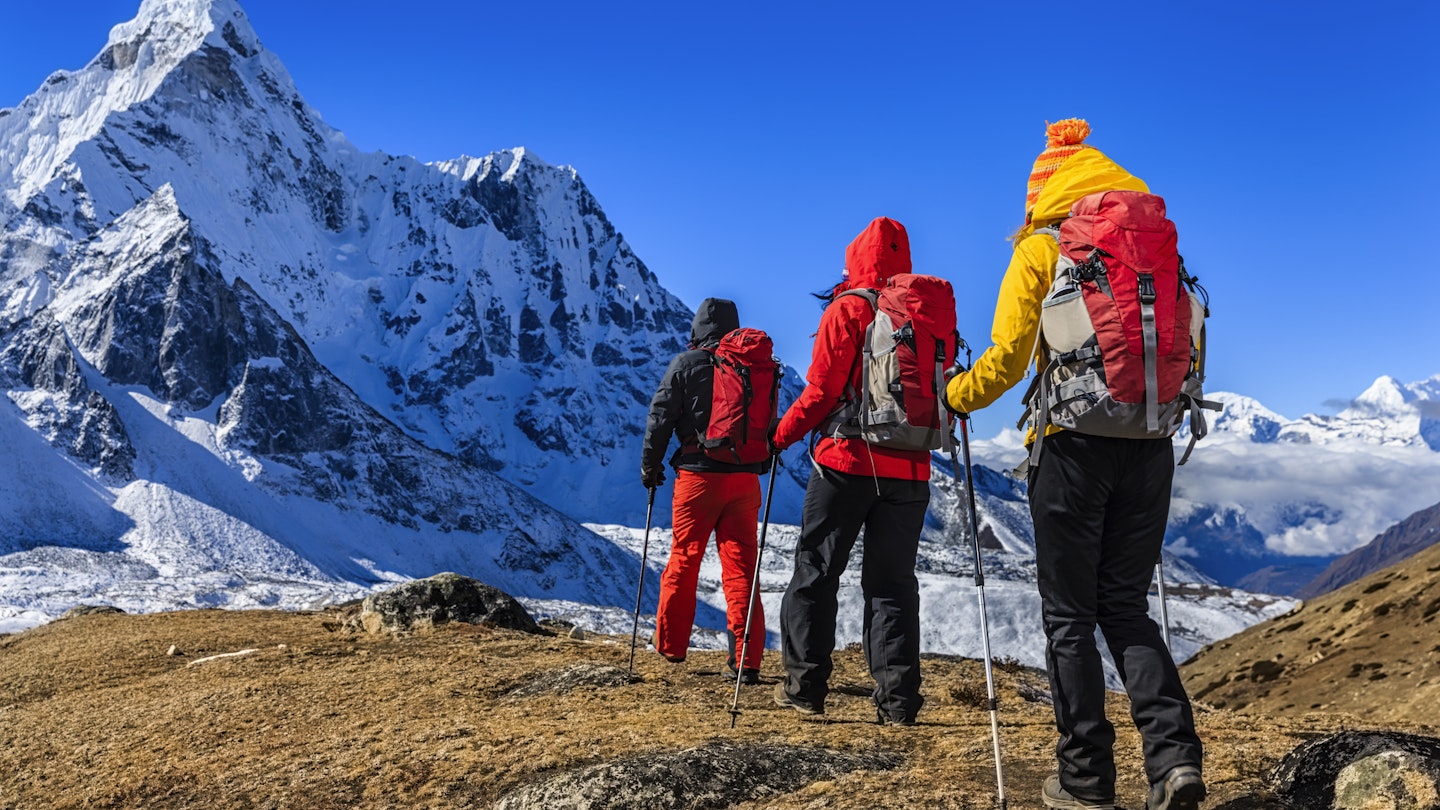
When planning a trip to Nepal, doing activities independently is a great way to save © Bartosz Hadyniak / Getty Images
Nepal is one of the cheapest countries in Asia for travelers and it's easy to explore this beautiful, culturally rich country on a budget. There are plenty of inexpensive places to stay and eat, public transport is extremely good value, entry fees for attractions are low by international standards, and that amazing mountain scenery comes for free.
However, costs are creeping up in the Kathmandu Valley, and you can easily end up spending more than you planned on activities such as trekking, mountain biking and wildlife safaris, as well as on accommodation and tourist-oriented transport.
Here are some tips for cutting your costs when traveling around Nepal on a budget.
Avoid the high season
Flight, accommodation and tour costs peak during Nepal’s October-November high season, which coincides with the best weather for trekking. For slightly lower prices, visit in the March-April shoulder season, which still sees good weather for trekking and wildlife-watching.
You can save even more money by traveling to Nepal in the winter, an excellent time for exploring warmer lowland areas such as the Terai . The cheapest time to visit Nepal is during the monsoon (roughly June-September), though views vanish behind heavy clouds, and getting around can be a challenge due to flooding and landslides.
It’s often cheaper to travel via India
Only a few airlines fly direct to Kathmandu , currently Nepal’s only functioning international airport (though the airports at Pokhara and Bhairawa are due to start receiving international flights in the near future). Getting to Nepal usually involves a change in Asia or the Middle East, and one of the cheapest options is to fly to Delhi and take a connecting flight to Kathmandu from there (though you may need to get an Indian visa to do so).
For even greater savings, you can travel overland from India. The Sunauli border crossing near Bhairawa is easily accessible from Delhi and Varanasi, with express buses running to and from the border in both directions.

Take advantage of a free airport pick-up
Many hotels in Kathmandu and nearby Patan will pick you up from the airport for free if you’ve booked a room in advance. If you haven't, it's not the end of the world – a taxi to town from the fixed-price desk in the arrivals hall at Tribhuvan International Airport costs Rs 750 (US$5.60).
Public buses are an economical way to get around
If you want to save money while traveling around Nepal, inexpensive public buses serve virtually every part of the country, though some services only run early in the morning. Although slower and less comfortable than dedicated tourist buses, domestic flights or private transfers, public buses are easily the cheapest way to get from A to B.
While it can be tempting to take a night bus to save on accommodation costs, be aware that deadly road accidents are common after dark and night buses are best avoided.
Negotiate a discount on your room rate
You'll find an incredible array of budget accommodation options in Nepal, from hostels and homestays to simple lodges and bare-bones budget hotels. It’s always worth haggling for the best price: room rates fluctuate significantly throughout the year and you can often negotiate sizable discounts (sometimes 20-40%) for longer stays or at quiet times, particularly outside of the high and shoulder seasons.
Note that mid-range and top-end places generally don’t include the 23% government and service tax in their quoted rates, so factor this in when drawing up your budget.
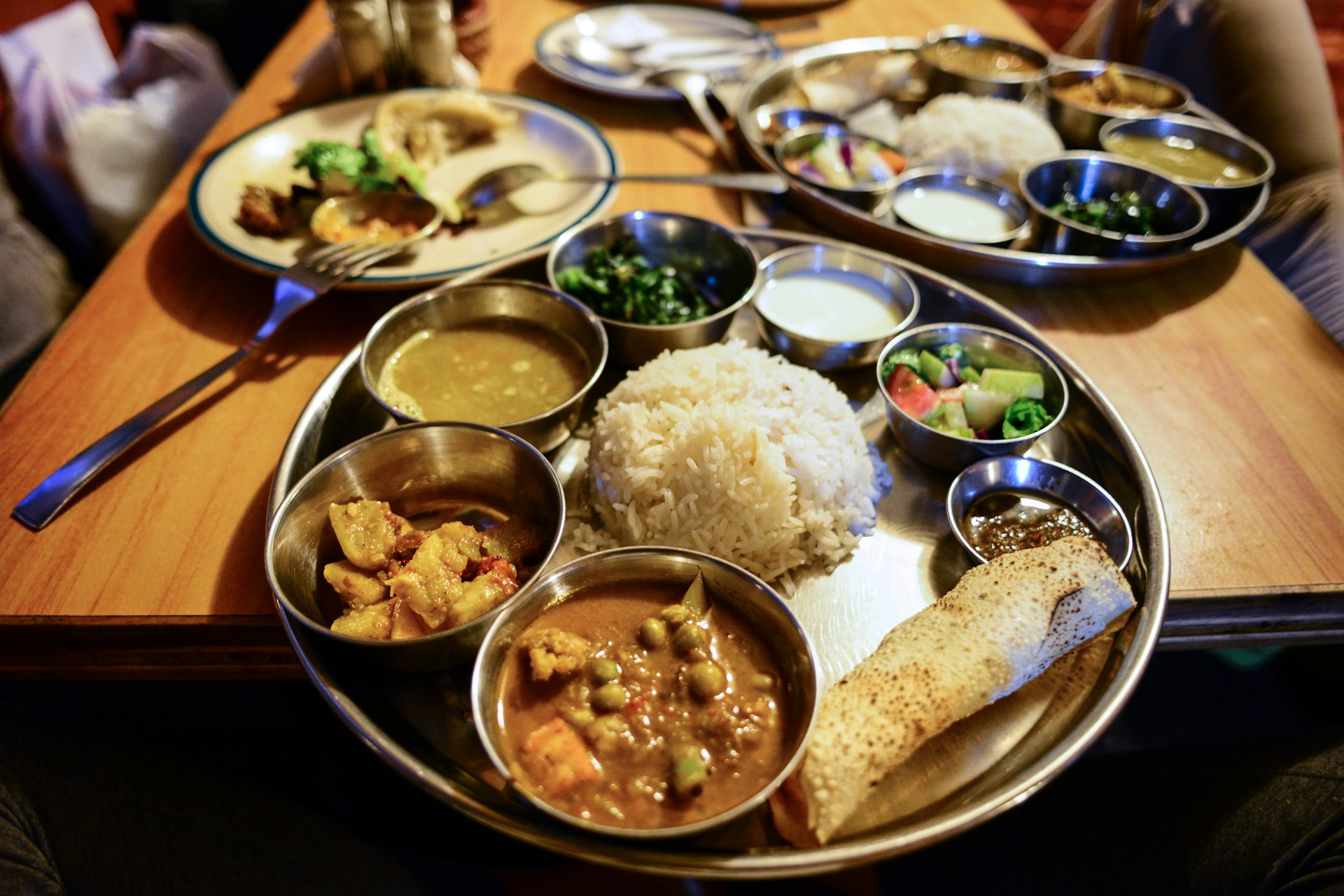
Eat like a local
Tourist hotspots such as Kathmandu and Pokhara are jam-packed with restaurants serving food from across the globe. However, prices – while inexpensive by international standards – are typically higher than in places serving local food to a local crowd. The costs of eating out can quickly add up if you’re on a tight budget.
To save a few rupees, head instead to local bhojanalayas – simple joints aimed at a Nepali clientele, serving inexpensive local staples such as daal bhaat tarkari (dal, rice and vegetable curry). Nepal also has some excellent and economical street food, including samsa (samosas) and momos (meat or vegetable dumplings), which go down a treat with a cup of sweet chiya (tea).
Choose a shorter trek, or trek independently
Nepal is famed for the myriad trekking trails that snake through the spectacular Himalayan scenery, but going on an organized trek with a guide and porters can put a big dent in your budget, particularly if you choose a longer route or have to fly to the trailhead.
To save money, opt for a shorter trek: there are several great options in the Annapurna region, including the memorable three-day Ghandruk Loop. Look for trailheads that you can reach without flying – most treks in the Langtang Valley and Annapurna region can be reached easily and inexpensively by public bus.
Another great way to save is to trek independently, instead of joining an organized trek. Many popular routes are relatively easy to follow without a guide, with plenty of teahouses providing simple accommodation and food (beer, however, can be pricey). Top choices include the Annapurna Circuit and Everest Base Camp treks.
Note that independent trekking does not mean solo trekking – it’s never wise to go hiking completely on your own. If you need companions for an independent trek, ask around at guesthouses in Kathmandu or Pokhara, or put up a note on noticeboards in tourist areas.
Make the most of Kathmandu’s Durbar Square
Most foreigners have to pay a Rs 1000 (US$8.50) fee to access Kathmandu’s famous Durbar Square , a Unesco World Heritage Site lined with magnificent medieval palaces and temples. Although the entry ticket is only valid for the date stamped, you can extend it for the length of your tourist visa for free at the site office, allowing you to visit multiple times during your stay. And you can do the same at the equally impressive Durbar Squares in the neighboring cities of Patan and Bhaktapur .

Skip “budget” Chitwan safaris
Many travel agencies in Kathmandu and Pokhara offer “budget” two-night, three-day safari packages to Chitwan National Park , but while these all-inclusive deals look tempting, they’re a false economy. You only get a day and a half in the park, have little choice over activities, and the accommodation and food are often below par.
It’s far better to travel to Chitwan independently and make the arrangements yourself; you’ll save money and have a far more enjoyable experience. Buses run from Kathmandu to Sauraha on the fringes of the park, where there are dozens of inexpensive lodges.
Slash your phone bill
Buy a local SIM card on arrival at Kathmandu’s airport or from retailers across the country to avoid being stung by a hefty mobile phone bill when you return home. Your phone should be unlocked and you’ll need a passport photo to register. If you need to make landline calls, use local call centers rather than using the phone in your hotel room.
Snag a SAARC discount
Travelers from countries that are members of the South Asian Association for Regional Cooperation (SAARC) – Afghanistan, Bangladesh, Bhutan, India, the Maldives, Pakistan and Sri Lanka, as well as Nepal – pay lower entrance fees than other foreign visitors at most museums, national parks and heritage sites. You may need to show identity documents to quality.
Arrange your own mountain-biking adventure
Nepal is a dream destination for mountain bikers, thanks to its plethora of fast-paced, downhill trails. Although going on an organized guided cycle tour with an operator such as Dawn Till Dusk and Himalayan Single Track is the easiest option, many routes can be followed independently, which significantly reduces the cost.
Bikes can be rented from numerous hire companies in Thamel in Kathmandu, and plenty of routes start just outside the Kathmandu city limits. For a taster, try the three-day Kathmandu Valley Loop via Nagarkot and the Buddhist pilgrimage site of Namobuddha .
Buying an up-to-date map and learning some basic Nepali phrases so you can ask for directions will make life immeasurably easier. If you're feeling less ambitious, consider taking some short out-and-back rides to the small towns and temples dotted around the Kathmandu Valley.
Daily costs in Nepali
- Hostel dorm bed: US$10
- Basic room for two: US$15-25
- Room and half-board in a trekking lodge: US$12-15
- Public bus Kathmandu-Pokhara (125 miles/201km): US$3-5 one-way
- Dinner for two: US$4-10
- Coffee or chiya (tea): US$1-2
- Beer: US$2.50-3.50
You may also like: 7 expert tips to sustainably trek to Everest Base Camp Uncovering Kathmandu’s cosmopolitan culture: why you're going to want to linger longer The best places to visit in Nepal, from mountains to Buddha's birthplace
Explore related stories
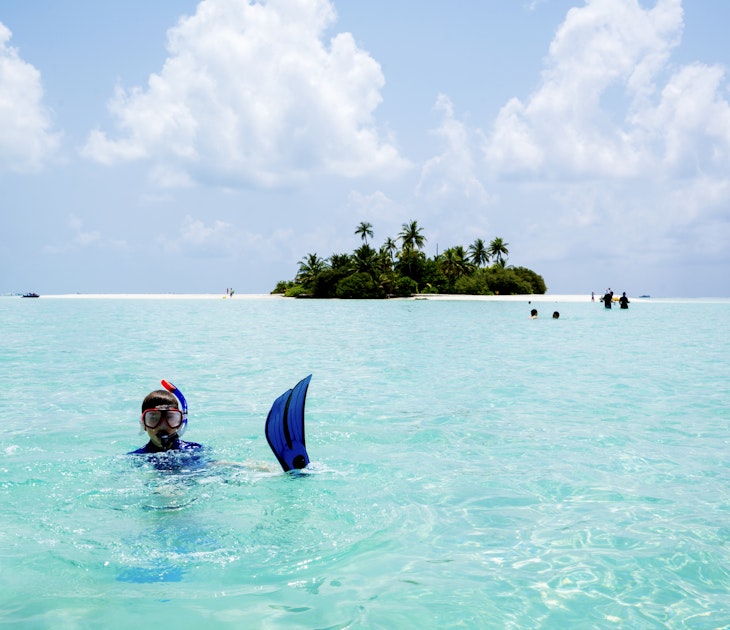
Budget Travel
Feb 22, 2024 • 5 min read
The Maldives is not a cheap place to visit, but there are ways to make your money stretch further. Here are our top budget tips.
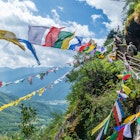
Jan 28, 2024 • 7 min read

Dec 20, 2023 • 11 min read
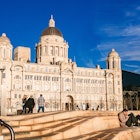
Aug 16, 2022 • 7 min read
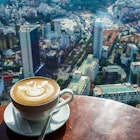
Feb 10, 2020 • 8 min read

Oct 28, 2019 • 19 min read
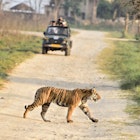
Apr 16, 2024 • 13 min read
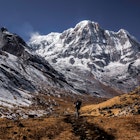
Feb 22, 2024 • 3 min read

Jan 11, 2024 • 4 min read
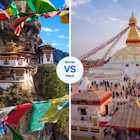
Dec 20, 2023 • 7 min read
No recent searches!
Luxury Trekking in Nepal
- Luxury Everest Base Camp Heli Trek - 9 Days
- Luxury Everest View Trek
- Luxury Everest Base Camp Trek
- Luxury Nepal Tour with Dhampus Sarangkot Trek
- Annapurna in Luxury – 11 Days
- Upper Mustang Heli Trek with Luxury Accommodations in Kathmandu and Pokhara
- VVIP Everest Base Camp Luxury Trek
- Ghorepani Poon Hill Luxury Trekking with optional Chitwan safari
- Everest Base Camp and Gokyo Lakes Luxury Helicopter Trek
- Luxury Everest Base Camp Trek - 14 Days
- Luxury Trekking in Nepal with Pokhara and Dhulikhel
Everest Region Trekking
- Everest Base Camp Trek
- Everest Base Camp Heli Trek with Kala Pathher Fly Over
- Everest Base Camp Trek with Helicopter flight from Kalapathar to Lukla
- Gokyo Lakes and Everest Base Camp Trek
- Gokyo Lakes and Gokyo Ri Trek
Annapurna Region Trekking
- Annapurna Base Camp Trek
- Annapurna Base Camp Trek - 10 Days
- Ghorepani Poon Hill Trek
- Mardi Himal Trek
- Kathmandu and Pokhara Luxury Tour with Dhampus Sarangkot Trek
- Ghorepani Poon Hill Sunrise Trek with Chitwan Jungle Safari
- Annapurna Circuit Trek
- Luxury Nepal Tour with Trek, Safari and Rafting
Luxury Trekking in the Everest Region
- Everest View Luxury Heli Trek
- Everest Base Camp Short Heli Trek 5 Days
- Everest Base Camp Helicopter Trek - All flight by Heli
- Premium Everest Base Camp Heli Trek
Everest Base Camp Trek with Helicopter Return
Manaslu region trekking.
- Manaslu Circuit Trek
- Tsum Valley Manaslu Circuit Trek
- Manaslu Circuit Helicopter Return Trek
Langtang Region Trekking
- Langtang Valley Trek
- Langtang Valley Heli Trek
Luxury Tours in Nepal
- Luxury Nepal Tour with Everest Scenic Flight
- Luxury Tour in Nepal: A 9-Day Journey through Kathmandu, Lumbini, Pokhara, and Chitwan
- Everest Base Camp Helicopter with Kathmandu and Pokhara Luxury Tour
- Everest Helicopter with Luxury Nepal Tour
- Everest Heli with Luxury Kathmandu, Pokhara and birthplace of Buddha
- Kathmandu and Chitwan Luxury Tour with Dhulikhel
- Family Tour in Nepal
- Honeymoon in Nepal
- Destination Wedding in Nepal - All Inclusive
- Luxury Nepal Tour with Everest Scenic flight - 6 Days
Best Selling Nepal Tours
- Luxury Nepal Tour with optional Chitwan, Pokhara and Lumbini
- Golden Triangle Nepal Tour (Kathmandu, Chitwan and Pokhara)
- Luxury Nepal Tour with Everest Landing Helicopter tour
- A adventure sports tour in Nepal
- A adventure sports tour in Nepal with Rafting, Jungle Safari and Mountain Flight
2 Days Nepal Tour with Nagarkot
3 Days Nepal Tour with Nagarkot
4 days Nepal tour with Pokhara
5 days Nepal tour with Pokhara and Chitwan Safari
Nepal's Most Popular Tours
- Discover the Splendor of Nepal: An Unforgettable 7-Day Luxury Journey
- The Ultimate 5 Nights 6 Days Luxury Nepal - Discover the Splendor of the Himalayas
- Discover the Heart of Nepal: 4 Nights 5 Days Nepal Luxury Tour Package
- Nepal Luxury Escape
- 9 Days Nepal tour with Pokhara, Lumbini and Safari
- 8 Days Nepal tour with Pokhara, Rafting and Safari
7 days Nepal Tour with rafting and safari
6 days Nepal tour with Pokhara and Safari
Cultural and Historical Tours
- Kathmandu Luxury Tour with the sunrise view from Nagarkot - 5 Days
- Nepal and Tibet cultural sightseeing Tour
- Nepal Family Tour
6000 M Peaks
- Mt Ama Dablam Expedition (6,812 m)
- Island Peak Expedition (6,160 m)
- Mera Peak Climbing (6,476 m)
- Chulu West Peak Climbing (6,419 m)
- Pisang Peak Climbing (6,091 m)
- Singu Chuli Peak Climbing (6,501 m)
- Island Peak Climbing with Everest Base Camp Trek
- Lobuche Peak Climbing with Everest Base Camp
8000 M Peaks
- Makalu Expedition (8,463m)
- Mt Everest Expedition (8848.86 m)
- Manaslu Expedition (8,163 m)
- Dhaulagiri Expedition (8,167 m)
- Kanchenjunga Expedition (8,586 m)
- Lhotse Expedition (8,516 m)
7000 M Peaks
- Gangapurna Expedition (7,455 m)
- Pumori Expedition (7,145 m)
- Tilicho Peak Expedition (7,134 m)
- Annapurna South Expedition (7,219 m)
- Annapurna Base camp Helicopter landing tour
- Kathmandu Sightseeing tour by Helicopter
- Langtang Helicopter tour
- Upper Mustang Helicopter Tour
- Mardi Himal Helicopter Tour from Pokhara
- Gosaikunda Helicopter Tour
- Everest Base Camp and Gokyo Landing Helicopter Tour
- Everest View Helicopter Tour from Hotel Everest View
- Everest Helicopter Landing Tour with Breakfast - All Inclusive
- Everest Scenic Flight by Plane with Hotel Pickup
- Everest Base Camp Helicopter tour with landing from Kathmandu
- Seven World Heritage Day Tour of Kathmandu Valley
- Private Tour Nagarkot Sunrise View and Day Hiking from Kathmandu
- Private Kathmandu Sightseeing Tour - UNESCO 4 World Heritage Sites
- Private Full-Day Tour With Nagarkot Sunrise and Bhaktapur From Kathmandu
- Chandragiri Cable Car Tour in Kathmandu - Private Half Day Tour
- Best Bhutan Tour 4 Days
- A Seven Day Majestic Bhutan Tour
- Majestic Bhutan: A Seven Day Luxury Bhutan Tour
- Bhutan Magical Tour - 5 Days
- Golden Triangle Bhutan Tour - 6 Days
- Dagala Thousand Lakes Trek - 6 Days
- 2 Nights 3 Days Bhutan Tour: A Glimpse into the Last Shangri-La
- Golden Triangle India Tour with Holy city Varanasi
- Golden Triangle India Tour of Delhi, Jaipur and Agra
- Luxury Dubai Tour with Burj Al Arab
- Best of Dubai Tour - 7 Days
- Tibet Cultural Tour - 8 Days
- Nepal - Bhutan
- Nepal - Tibet
- Nepal - India
- Nepal - Bhutan - Tibet
- Nepal - Bhutan - India
- Everest Base Camp Helicopter Tour & Kathmandu Cultural Tour - 4 Days
- Luxury Nepal Tour with Bardiya National Park Safari
- Make a Payment
- LHN & Responsible Tourism
- Core Values
- Fleets of LHN
- Refund & Cancellation policy
- Terms & Conditions
- Why Luxury Holidays?
- Best low price guaranteed
- Legal Documents
- How to Book a Trip
- Work with us

- How Many Days to Spend in Nepal

- May 18th 2023
- Travel Informations
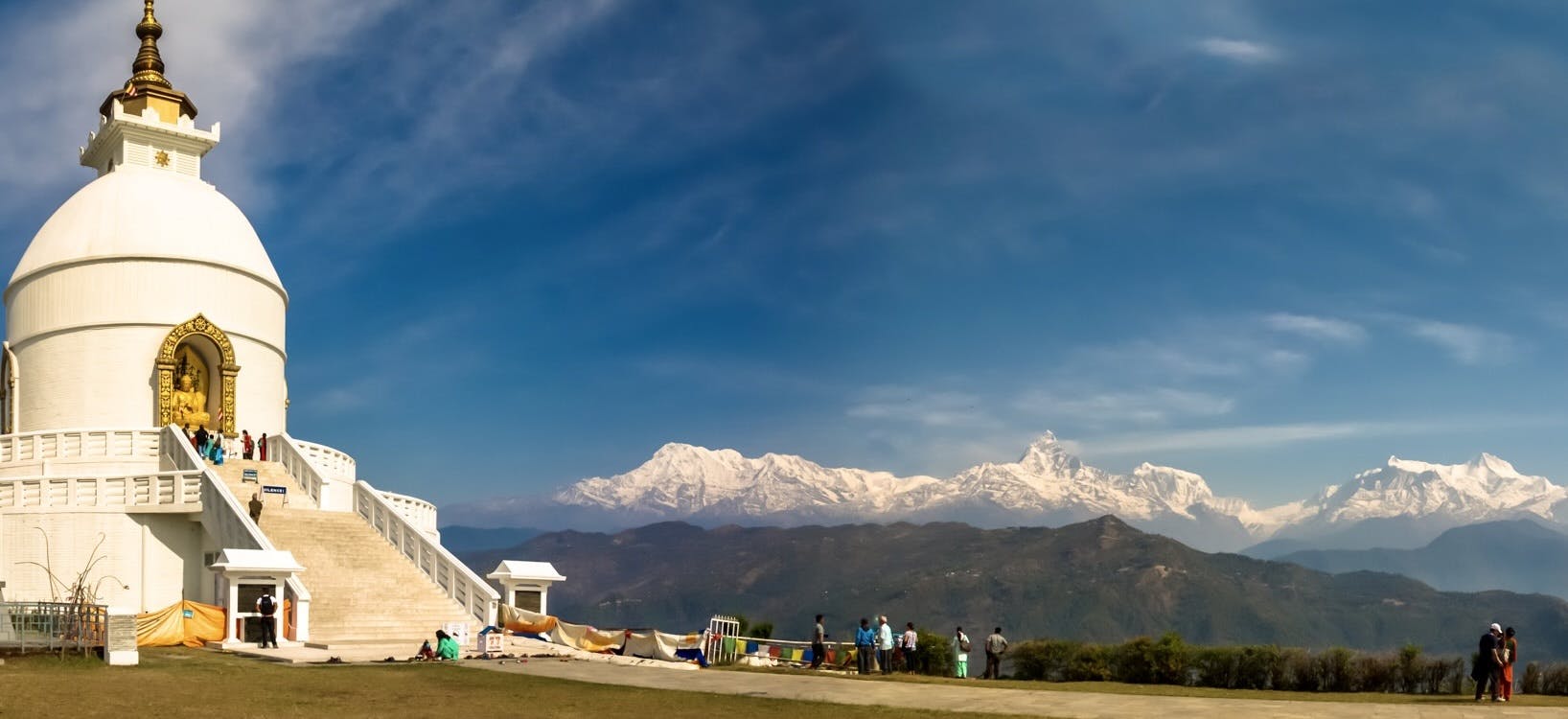
Nestled in the heart of the majestic Himalayas, Nepal is a destination like no other. It's a treasure trove of ancient temples, serene lakes, dense wildlife reserves, and some of the world's highest peaks. But how many days should you spend in this Himalayan haven? Let's delve into the wonders of Nepal and craft the ideal itinerary.
Exploring the Kathmandu Valley (3-5 Days)
Nestled in the heart of Nepal, the Kathmandu Valley is a treasure trove of ancient traditions, vibrant culture, and architectural marvels. With its UNESCO World Heritage Sites, bustling markets, and spiritual sanctuaries, the valley offers a unique blend of history and modernity. In this blog, we will explore the highlights of the Kathmandu Valley and suggest an ideal itinerary for spending 3-5 days in this enchanting region.
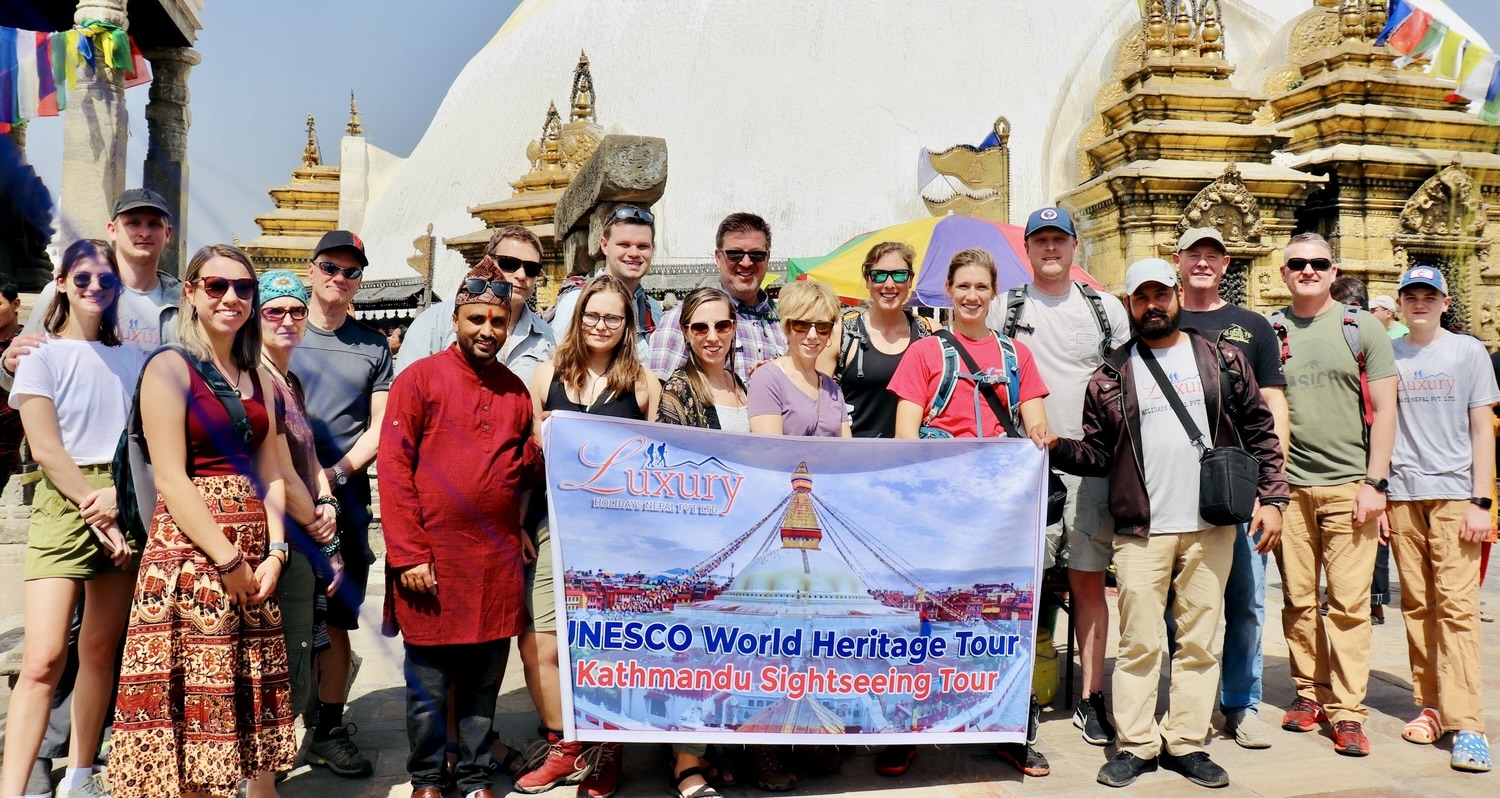
Day 1: Discover the Historical Wonders
Start your journey by immersing yourself in the historical wonders of the Kathmandu Valley. Begin with a visit to Kathmandu Durbar Square, the former royal palace complex, where you can marvel at intricately carved temples, palaces, and courtyards. Don't miss the magnificent Hanuman Dhoka Palace, the Taleju Temple, and the Kumari House, where you may catch a glimpse of the living goddess, Kumari.
Next, head to Swayambhunath Stupa, also known as the Monkey Temple, which sits atop a hill overlooking the valley. Explore the ancient stupa, adorned with colorful prayer flags and surrounded by sacred shrines. Enjoy panoramic views of Kathmandu city and embrace the spiritual atmosphere.
Day 2: Spiritual Exploration and Cultural Immersion
Begin your second day with a visit to Pashupatinath Temple, one of the holiest Hindu temples in the world. Observe the rituals, witness the cremation ghats along the sacred Bagmati River, and gain insights into Hindu funeral rites. The serene ambiance and the intricate architecture of the temple complex offer a captivating experience.
Continue your spiritual journey by visiting Boudhanath Stupa, one of the largest Buddhist stupas in the world. Take a leisurely stroll around the stupa, spin the prayer wheels, and soak in the serene atmosphere. Explore the surrounding monasteries, observe monks in prayer, and perhaps participate in a meditation session.
In the afternoon, visit the ancient city of Bhaktapur, renowned for its well-preserved medieval architecture. Wander through its narrow streets, visit Durbar Square, and admire the impressive 55 Window Palace. Don't forget to try the local delicacy, Juju Dhau (King Yogurt), and observe the intricate pottery-making process in the traditional Pottery Square.
Day 3: Art, Culture, and Handicrafts
Dedicate your third day to exploring the artistic and cultural heritage of the Kathmandu Valley. Start with a visit to Patan Durbar Square, also known as Lalitpur, famous for its exquisite Newari architecture. Explore the Patan Museum, which houses a remarkable collection of art and artifacts from the region.
Next, visit the Kathmandu Contemporary Arts Centre or the Nepal Art Council to immerse yourself in contemporary Nepali art. From traditional paintings to modern installations, these art spaces offer a glimpse into the vibrant art scene of Nepal.
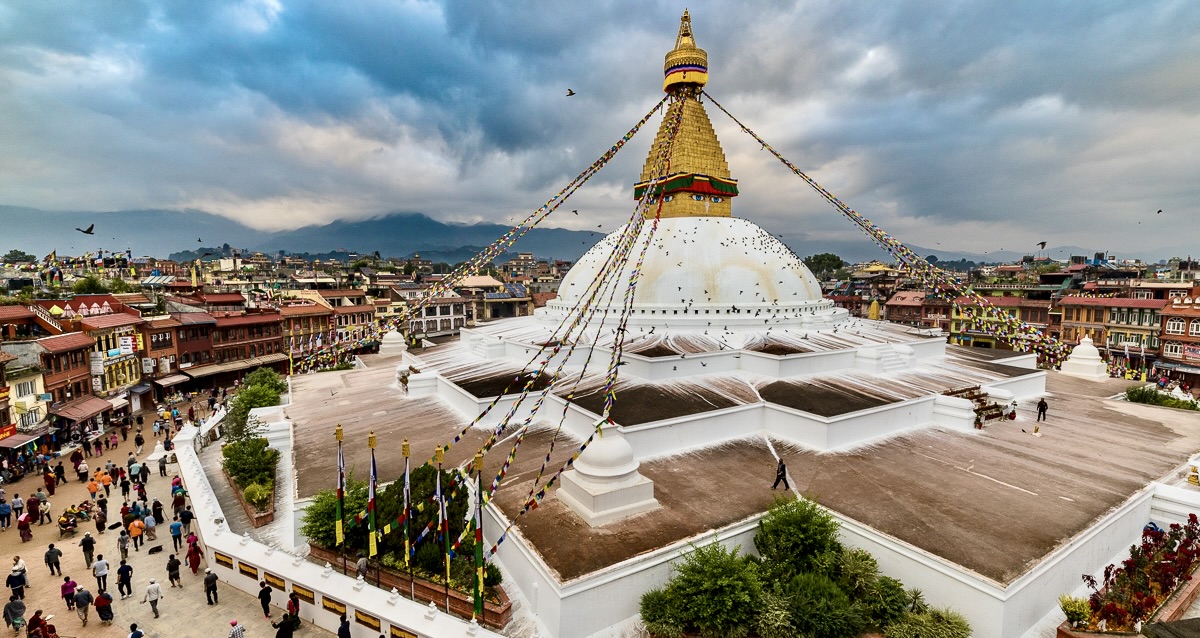
Indulge in a shopping spree at Thamel, Kathmandu's bustling tourist hub. Explore its narrow alleys filled with shops selling traditional handicrafts, colorful textiles, jewelry, and trekking gear. Bargain for souvenirs, savor local delicacies in cozy cafes, and soak in the energetic ambiance of this vibrant neighborhood.
Optional Day 4-5: Excursions and Nearby Attractions
If you have additional days to spare, consider exploring nearby attractions from the Kathmandu Valley. Some popular options include:
- Nagarkot: Experience breathtaking sunrise and sunset views over the Himalayan range from this hill station near Kathmandu.
- Chandragiri Hills: Take a cable car ride to the top of Chandragiri Hills for panoramic views, hiking trails, and a visit to the Bhaleshwor Mahadev Temple.
- Shivapuri Nagarjun National Park: Embark on a nature hike through this beautiful national park, located on the outskirts of Kathmandu, and enjoy the serene surroundings and birdwatching opportunities.
Spending 3-5 days in the Kathmandu Valley allows you to unravel the rich tapestry of history, spirituality, and cultural heritage that defines this remarkable region. From exploring ancient palaces and temples to immersing yourself in the bustling markets and vibrant art scene, each day will be filled with captivating experiences. Embrace the beauty of the Kathmandu Valley and create memories that will stay with you long after you leave.
Embrace the Adventure: Trekking (10-21 Days)
Nepal is a haven for adventure enthusiasts, particularly those seeking the ultimate trekking experience amidst the majestic Himalayas. With its rugged landscapes, pristine trails, and breathtaking views, Nepal offers a wide range of trekking options for all levels of hikers. In this blog, we will delve into the world of trekking in Nepal, highlighting some of the most popular routes and providing insights on planning a trekking adventure lasting 10-21 days.
- Nepal boasts a plethora of trekking routes, each offering a unique experience. Here are three popular options for treks that can be completed within 10-21 days:
Everest Base Camp Trek (12-14 Days)
- Embark on a legendary journey to the base of the world's highest peak, Mount Everest. This trek takes you through remote Sherpa villages, lush valleys, and rugged mountain passes. Marvel at stunning views of iconic peaks, including Everest, Lhotse, and Nuptse. The trek typically begins with a scenic flight from Kathmandu to Lukla, and the trail leads through Namche Bazaar, Tengboche Monastery, Dingboche, and Gorak Shep, culminating at Everest Base Camp.
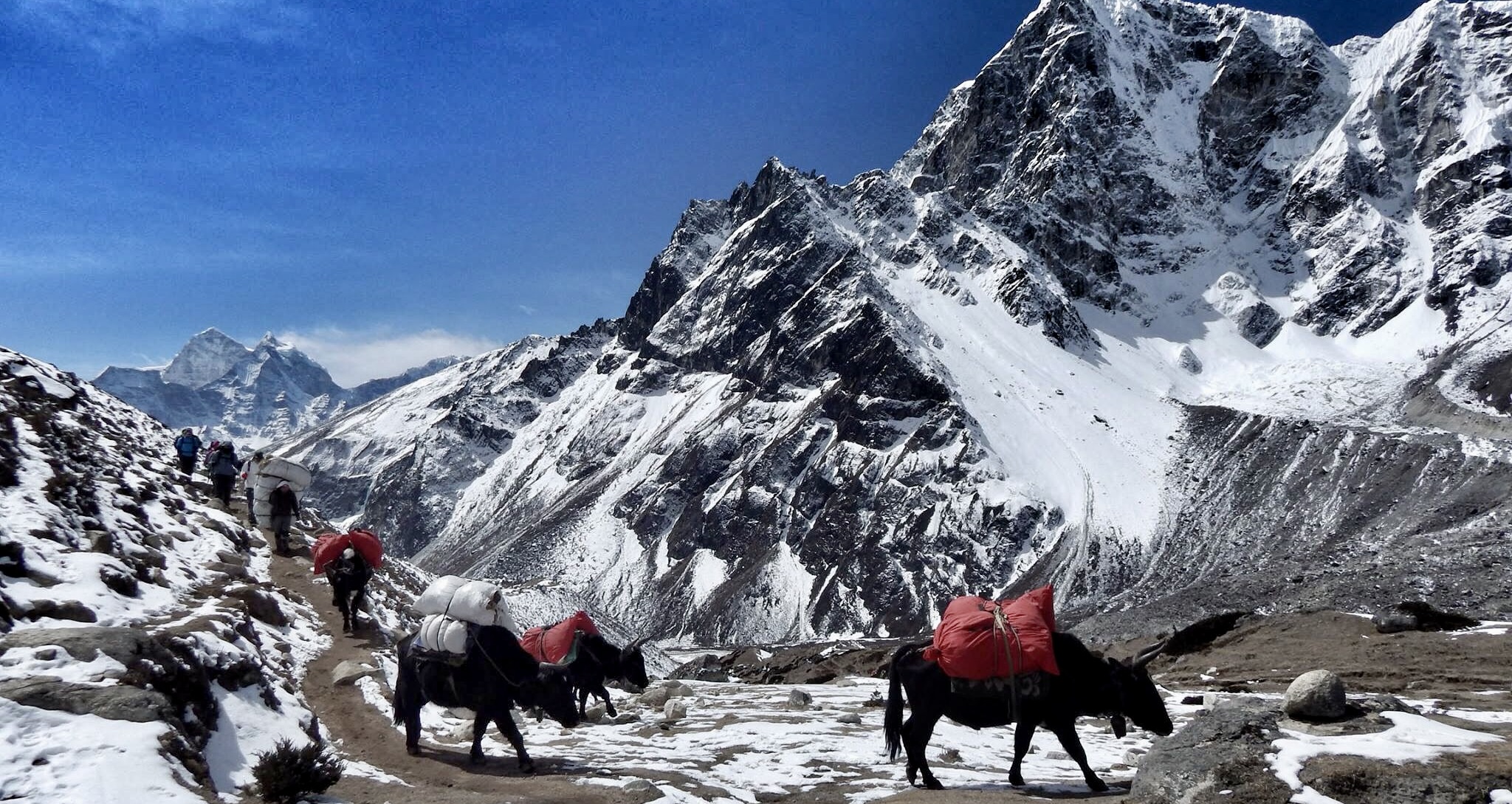
Annapurna Circuit Trek (15-21 Days)
- Experience the diverse landscapes and rich cultural heritage of the Annapurna region on this classic trek. Traverse through lush green valleys, terraced farmlands, and enchanting rhododendron forests. Witness panoramic mountain vistas, including the Annapurna and Dhaulagiri ranges. The trek usually starts from Besi Sahar and encompasses iconic destinations such as Manang, Thorong La Pass, Muktinath, and Jomsom.
Langtang Valley Trek (10-12 Days)
- For those seeking a shorter yet equally rewarding trek, the Langtang Valley Trek is an excellent choice. This trek takes you through the Langtang National Park, where you can witness breathtaking mountain vistas, encounter friendly Tamang and Sherpa communities, and explore the scenic Langtang Valley. The trek starts from Syabrubesi and passes through villages like Lama Hotel, Langtang Village, and Kyanjin Gompa.

Preparation and Considerations
- Physical Fitness: Trekking in the Himalayas requires a certain level of physical fitness. Engage in regular exercise and stamina-building activities before your trip. Consult with a medical professional to ensure you are physically fit for the trek.
- Permits and Documentation: Obtain the necessary permits for your trek, such as the TIMS (Trekkers' Information Management System) card and the Annapurna Conservation Area Permit (ACAP) or Sagarmatha National Park Permit, depending on your chosen route.
- Equipment and Gear: Invest in quality trekking gear, including sturdy hiking boots, warm clothing layers, a comfortable backpack, a sleeping bag, and trekking poles. Consider renting or hiring equipment in Kathmandu or Pokhara if needed.
- Guides and Porters: Hiring a local guide or porter can enhance your trekking experience. They provide valuable insights, assist with navigation, and ease the physical burden, allowing you to fully enjoy the journey.
- Altitude Acclimatization: Acclimatization is crucial to avoid altitude sickness. Plan your itinerary with adequate rest days and gradual ascent to higher altitudes. Stay hydrated, follow proper acclimatization guidelines, and be mindful of any symptoms of altitude sickness.
Discover the Wild Side: Chitwan National Park (2-3 Days)
If you're seeking an adventure in the wilderness and a chance to encounter rare wildlife, Chitwan National Park in Nepal is the perfect destination. Located in the Terai lowlands of southern Nepal, this national park is a UNESCO World Heritage Site and offers a unique opportunity to explore diverse ecosystems and spot endangered species. In this blog, we will delve into the wonders of Chitwan National Park and provide insights on how to make the most of your 2-3 day visit.
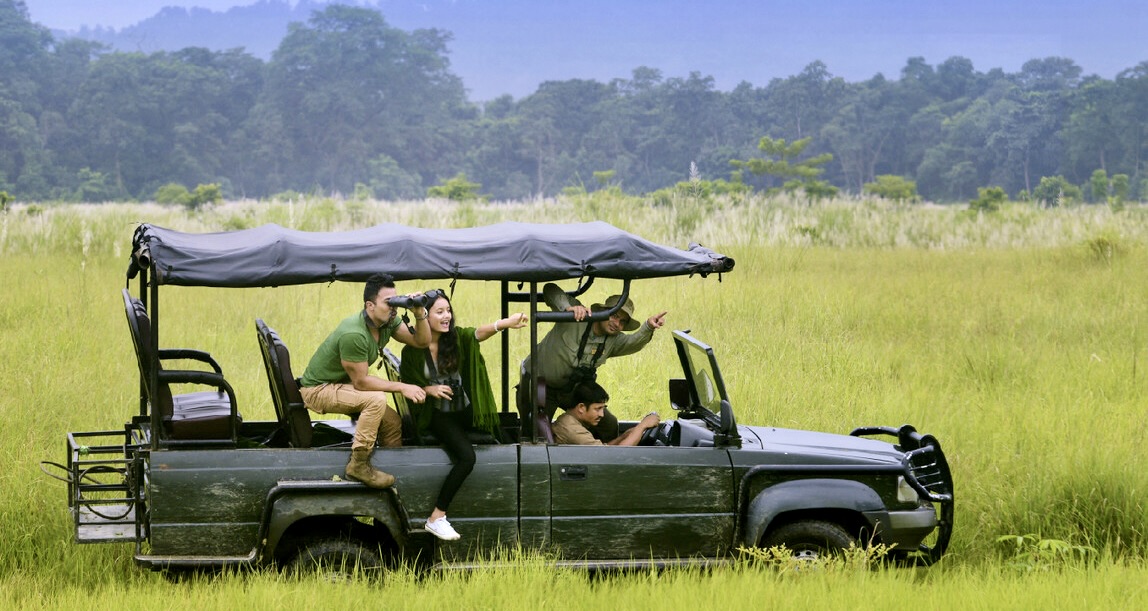
Day 1: Arrival and Jungle Safari
Upon arrival in Chitwan, settle into your accommodation and get ready for an exciting jungle safari. Start your adventure by embarking on a jeep safari or an elephant-back safari, accompanied by experienced guides. Traverse through dense forests, grasslands, and marshes as you keep an eye out for a variety of wildlife, including the elusive Bengal tiger, one-horned rhinoceros, wild elephants, deer, and an abundance of bird species. The park is also home to sloth bears, gharials (fish-eating crocodiles), and the rare Gangetic dolphins.
Day 2: Canoe Ride and Elephant Encounter
Begin your second day with a peaceful canoe ride along the Rapti or Narayani River, allowing you to observe the aquatic life, including birds, crocodiles, and possibly even river dolphins. Immerse yourself in the tranquility of the riverine ecosystem and enjoy the scenic beauty of the surroundings.
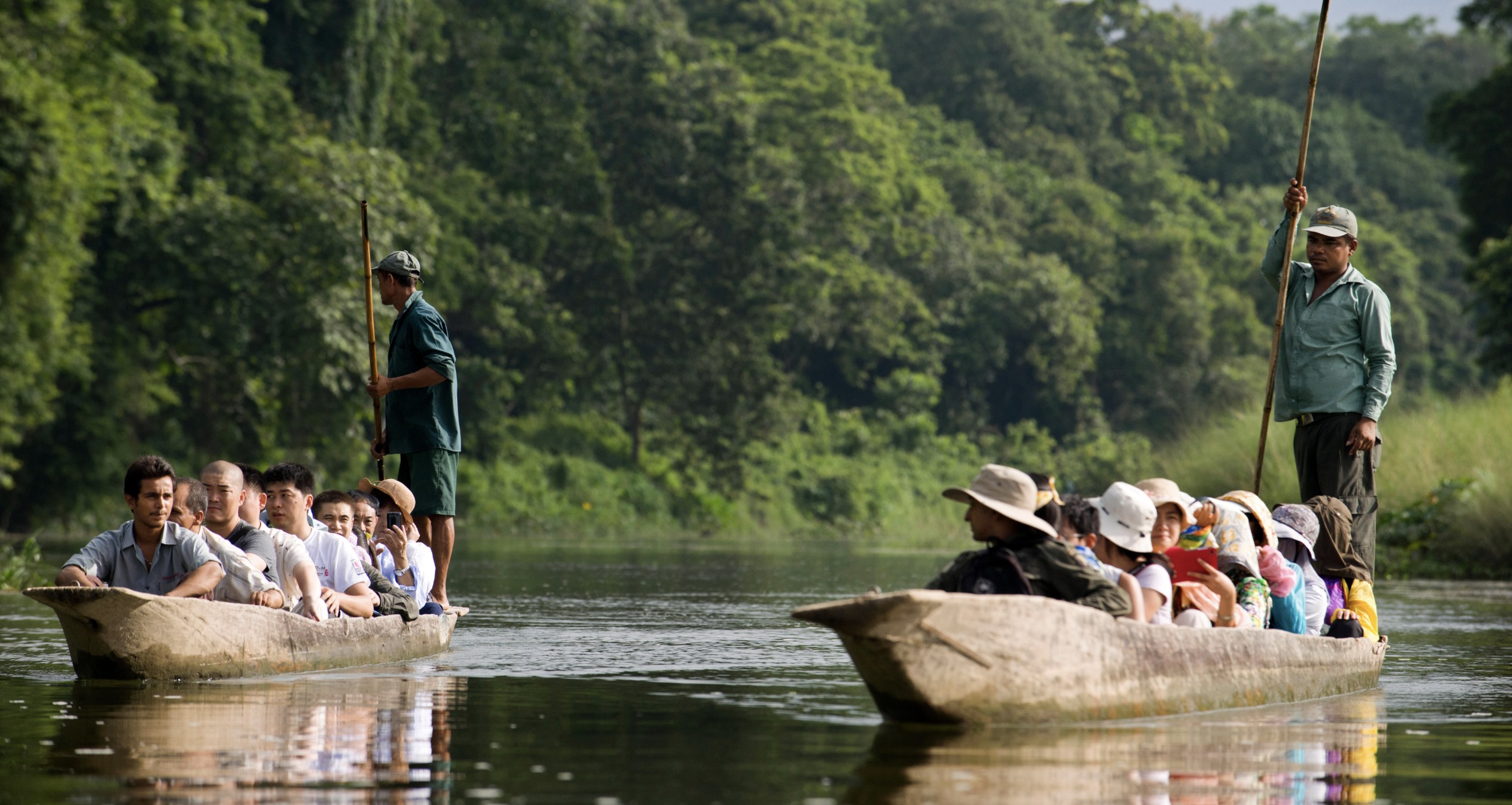
In the afternoon, engage in a memorable elephant encounter. Visit an elephant breeding center or an elephant camp and learn about these magnificent creatures. You can participate in activities like feeding, bathing, and even taking a short elephant-back ride. It's an opportunity to gain insight into the conservation efforts and the bond between humans and elephants in this region.
Day 3: Tharu Village Visit and Cultural Experience
Dedicate your final day to experiencing the rich cultural heritage of the Tharu community. The Tharus are an indigenous ethnic group residing in the Terai region, known for their unique traditions, vibrant dances, and craftsmanship. Take a guided tour of a Tharu village and interact with the locals, gaining insights into their way of life, traditional farming practices, and unique mud-and-thatch houses. Witness captivating Tharu cultural performances, including their energetic dances and melodic music.
Optional Activities
If you have an additional day, consider including the following activities in your itinerary:
- Nature Walks: Join experienced naturalists for guided nature walks within the park's buffer zone. Explore the lush forests, spot birds and smaller wildlife, and learn about the local flora and fauna.
- Birdwatching: Chitwan National Park is a paradise for bird lovers. Embark on a birdwatching excursion with a knowledgeable guide and spot a variety of colorful and rare bird species.
- Jeep Safari Extension: Extend your jungle safari by exploring deeper areas of the park in a jeep. Venture into remote corners and increase your chances of spotting elusive wildlife.
A visit to Chitwan National Park offers an unforgettable wildlife experience and a glimpse into the cultural heritage of the Tharu community. Whether you're exploring the wilderness on a thrilling safari, observing majestic elephants up close, or immersing yourself in the traditions of the Tharu people, Chitwan National Park promises a truly remarkable adventure. So, pack your binoculars, embrace the wild side, and create lasting memories in this pristine natural haven.
Trace the Steps of Buddha: Lumbini (1-2 Days)
Lumbini, located in the Terai plains of Nepal, holds immense religious and historical significance as the birthplace of Lord Buddha, the founder of Buddhism. This sacred pilgrimage site attracts Buddhist devotees and curious travelers from around the world who seek to immerse themselves in the aura of tranquility and spirituality. In this blog, we will guide you through the highlights of Lumbini and suggest an ideal itinerary for a 1-2 day visit to this sacred destination.
[block](104)
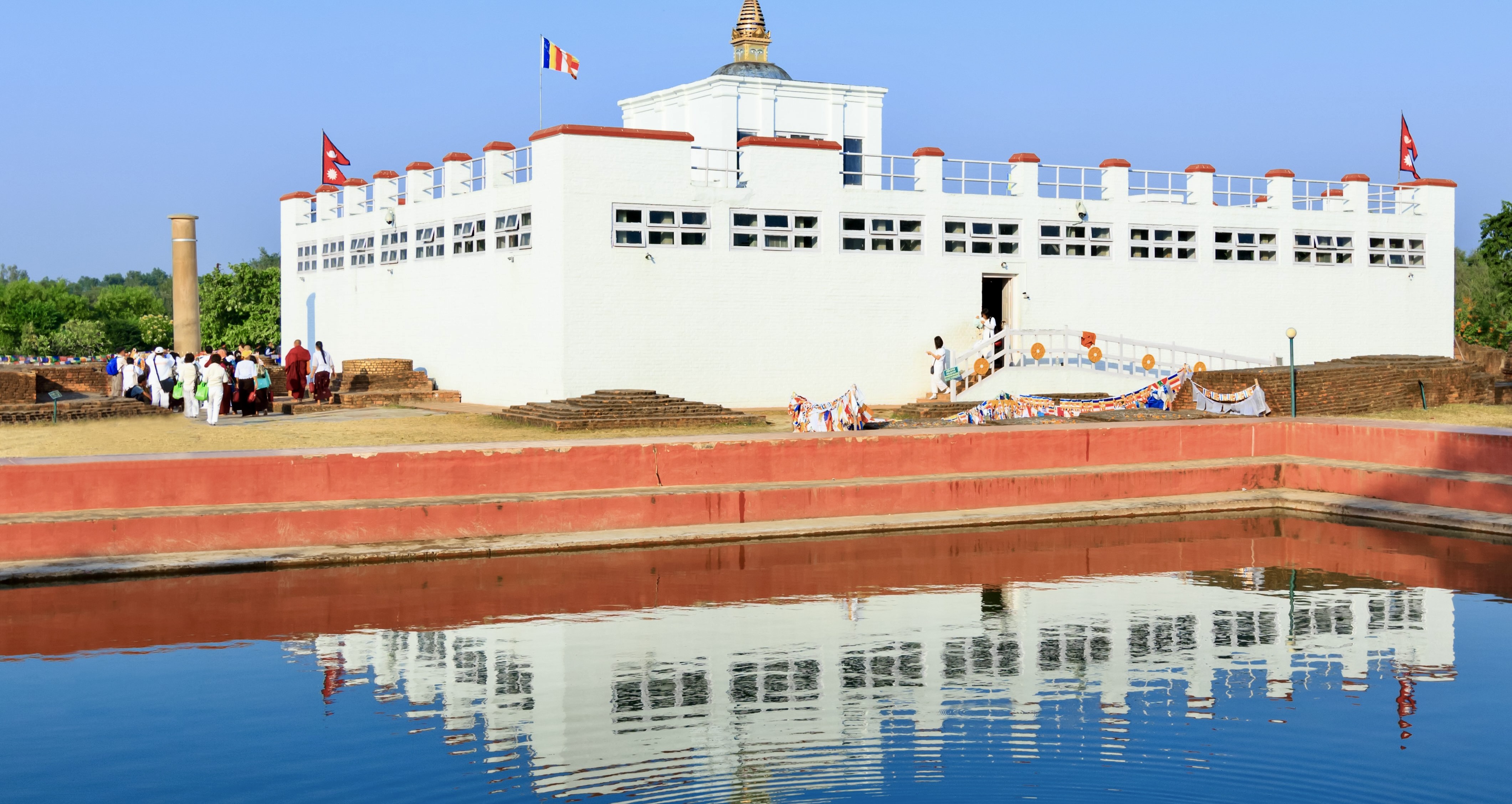
Day 1: Arrival and Exploration of Lumbini Gardens
Upon arrival in Lumbini, check into your accommodation and begin your spiritual journey by visiting the Lumbini Development Zone. This expansive complex, spread over 6 square kilometers, encompasses the major sites associated with Buddha's birth and enlightenment. Start your exploration with a visit to the Sacred Garden, the heart of Lumbini.
- Maya Devi Temple : Begin your pilgrimage at the Maya Devi Temple, the main shrine in the Sacred Garden. This temple marks the exact spot where Queen Maya Devi gave birth to Prince Siddhartha Gautam, who later became the Buddha. Enter the temple and witness the holy marker stone and the sacred pond where Queen Maya Devi is said to have bathed before giving birth.
- Ashoka Pillar: Next, marvel at the Ashoka Pillar, erected by Emperor Ashoka of India in the 3rd century BCE. This pillar bears an inscription stating the significance of Lumbini as the birthplace of Buddha.
- Bodhi Tree: Pay homage to the Bodhi Tree, a descendant of the original tree in Bodhgaya under which Buddha attained enlightenment. Meditate under its shade and reflect upon Buddha's teachings.
- Lumbini Museum: Visit the Lumbini Museum to gain insights into the history, art, and archaeological discoveries of the region. The museum houses a remarkable collection of ancient artifacts and exhibits related to Buddhism.
Day 2: Monastery Visits and Peaceful Reflection
On your second day, dedicate your time to exploring the monastic zones and various international monasteries within the Lumbini Development Zone. Each monastery represents different Buddhist traditions from around the world and offers a unique architectural and cultural experience.
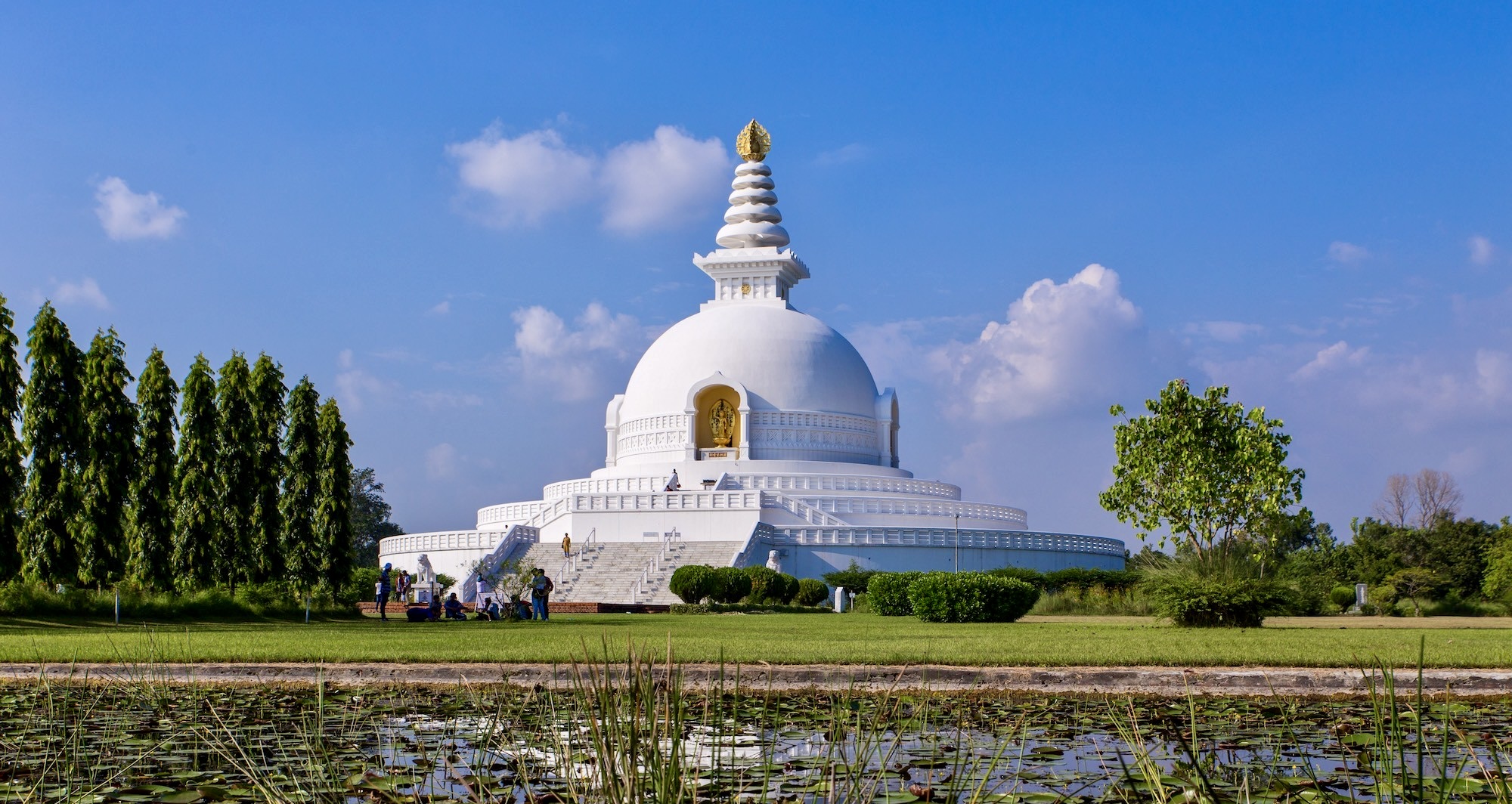
Visit International Monasteries: Explore monasteries constructed by different countries, such as Thailand, Japan, Myanmar, China, and more. Admire the stunning architectural designs, intricate artwork, and serene surroundings. Interact with resident monks and nuns, engage in meditation or chanting sessions, and learn about diverse Buddhist practices and cultures.
Peaceful Reflection: Take time for personal reflection and meditation in the peaceful ambiance of Lumbini. Find a tranquil spot within the gardens or by the banks of the sacred canal and immerse yourself in the serenity of the surroundings. Embrace the spiritual energy and contemplate the teachings of Buddha.
If you have additional time, consider including the following activities in your itinerary:
- Visit the Eternal Peace Flame: Pay homage to the Eternal Peace Flame, a symbol of peace and harmony in Lumbini. This perpetual flame was lit by the late King Birendra of Nepal and represents the universal message of Buddha.
- Explore Tilaurakot: Take a half-day excursion to Tilaurakot, located about 27 kilometers west of Lumbini. This ancient fortified city is believed to be the capital of the Shakya kingdom, where Prince Siddhartha spent his early years.
A visit to Lumbini offers a profound spiritual experience as you trace the footsteps of Buddha and immerse yourself in the birthplace of Buddhism. The serene atmosphere, sacred sites, and diverse monastic zones provide a unique opportunity for introspection, meditation, and cultural exploration. Whether you spend one day or extend your visit to two days, Lumbini promises a transformative journey that connects you with the essence of Buddha's teachings and leaves a lasting impression of peace and enlightenment.
Relax in Nature's Lap: Pokhara (3-5 Days)
Nestled amidst the tranquil foothills of the Himalayas, Pokhara is a picturesque city in Nepal that captivates visitors with its natural beauty, serene lakes, and breathtaking mountain views. Whether you seek adventure, relaxation, or a spiritual retreat, Pokhara offers a perfect blend of nature and culture. In this blog, we will guide you through the highlights of Pokhara and suggest an ideal itinerary for a 3-5 day visit to this enchanting destination.
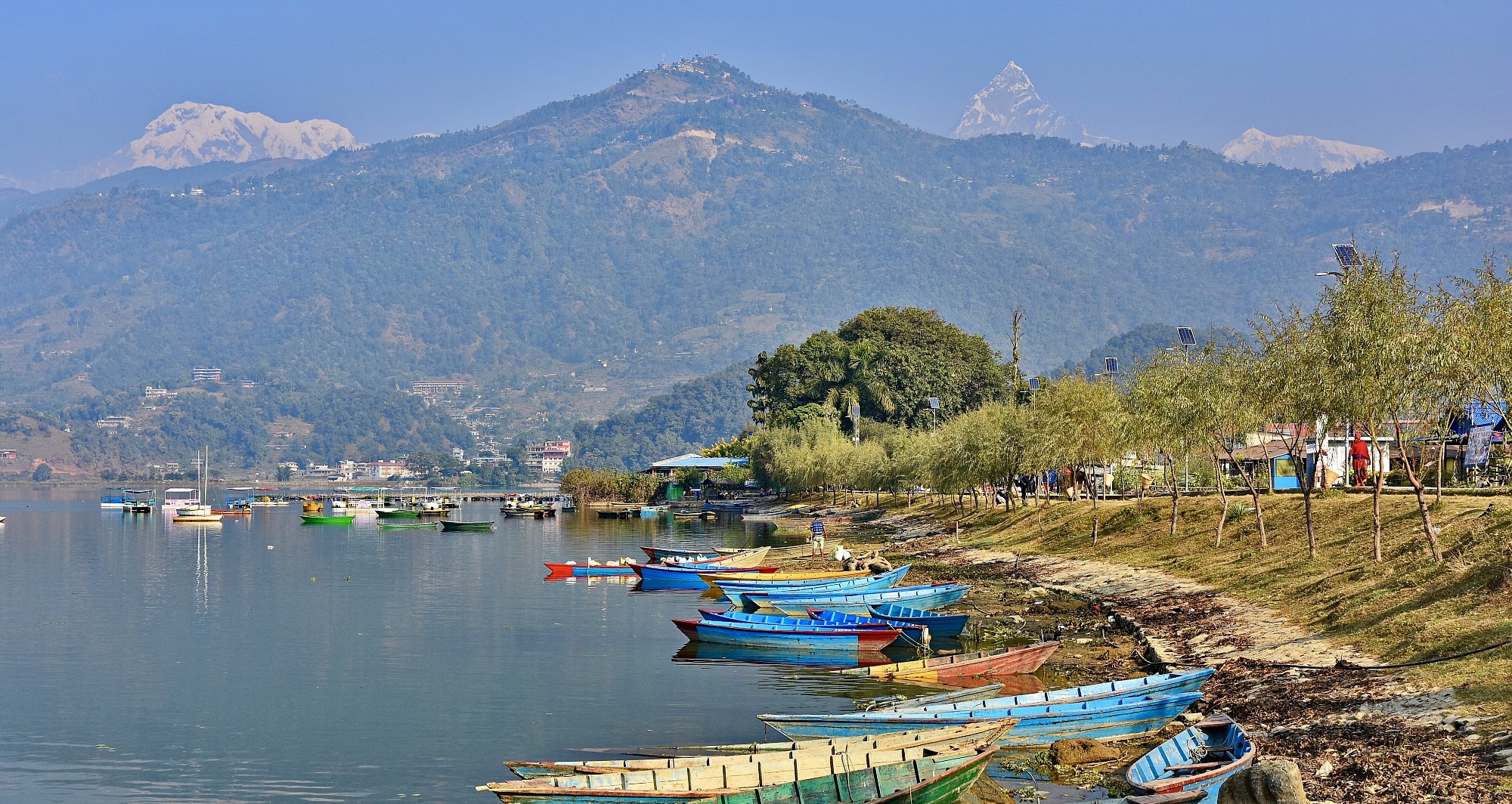
Day 1: Explore Pokhara City and Lakeside
Upon arrival in Pokhara, settle into your accommodation and embark on a journey of exploration. Start by exploring Pokhara City, and visiting its vibrant markets, temples, and cultural sites. Highlights include:
- Old Bazaar: Wander through the narrow lanes of the Old Bazaar, where you can experience the authentic local lifestyle, shop for souvenirs, and sample traditional Nepali cuisine.
- Bindhyabasini Temple: Pay a visit to Bindhyabasini Temple, a sacred Hindu temple dedicated to the goddess Durga. Seek blessings and soak in the spiritual ambiance.
- Seti River Gorge: Marvel at the beauty of the Seti River Gorge, where the milky-white river flows through a deep gorge, creating an awe-inspiring sight.
In the evening, head to Lakeside, a vibrant and popular tourist area along the banks of Phewa Lake. Enjoy lakeside strolls, browse the shops, dine at lakeside restaurants, and witness the stunning sunset over the lake.
Day 2: Sunrise and Nature's Beauty
Rise early to experience the mesmerizing sunrise over the Himalayan peaks from Sarangkot Hill. Take a short drive or hike up the hill and witness the breathtaking panorama of the Annapurna and Dhaulagiri mountain ranges, bathed in golden hues.
Afterward, visit the International Mountain Museum, which showcases the cultural and mountaineering history of the Himalayas. Explore its exhibits, artifacts, and displays dedicated to the mountains and the mountaineers who have conquered them.
In the afternoon, embark on a peaceful boating excursion on Phewa Lake. Rent a boat and glide across the pristine waters, soaking in the tranquility and admiring the reflection of the surrounding mountains on the lake's surface. You can also visit the Tal Barahi Temple located on a small island in the middle of the lake.
Day 3: Adventure and Nature's Wonders
For adrenaline seekers, Pokhara offers a plethora of adventure activities. Choose from paragliding, zip-lining, or even a thrilling ultralight flight to soar above Pokhara's landscapes and enjoy breathtaking aerial views of the city and the mountains.

In the afternoon, explore the serene and mystical Davis Falls (also known as Patale Chhango). Witness the waterfall plunging into an underground cavern and feel the misty spray on your face.
Visit the nearby Gupteshwor Mahadev Cave, an ancient Hindu cave temple. Marvel at the stalactites, stalagmites, and the impressive Shiva lingam inside the cave.
Optional Day 4-5: Excursions and Relaxation
If you have additional days to spare, consider adding the following activities to your itinerary:
- Sarangkot Hiking: Embark on a scenic hike to Sarangkot Hill, enjoying panoramic views along the way. Spend the night at Sarangkot and wake up to another stunning sunrise.
- Peace Pagoda: Take a boat ride across Phewa Lake and hike up to the Peace Pagoda. Enjoy the serene surroundings and panoramic views of Pokhara City and the mountains.
- R&R at Lakeside: Indulge in relaxation and rejuvenation at the lakeside. Pamper yourself with a massage, practice yoga, or simply unwind by the lake, absorbing the peaceful ambiance.
Pokhara, with its natural beauty, serene lakes, and adventure opportunities, offers a perfect escape for nature lovers and adventure seekers alike. Whether you spend 3-5 days, the city's blend of cultural heritage, stunning landscapes, and recreational activities will leave you enchanted and rejuvenated. Embrace the tranquility, indulge in adventure, and create lasting memories amidst nature's lap in Pokhara.
A Serene Getaway: Bandipur or Nagarkot (1-2 Days)
If you're looking for a serene and peaceful getaway from the bustling cities of Nepal, both Bandipur and Nagarkot offer idyllic retreats with breathtaking views and tranquil surroundings. Bandipur, a hilltop town in central Nepal, and Nagarkot, a scenic hill station near Kathmandu, provide a perfect escape to rejuvenate amidst nature's beauty. In this blog, we will explore the highlights of Bandipur and Nagarkot, and suggest an ideal itinerary for a 1-2 day visit to these serene destinations.
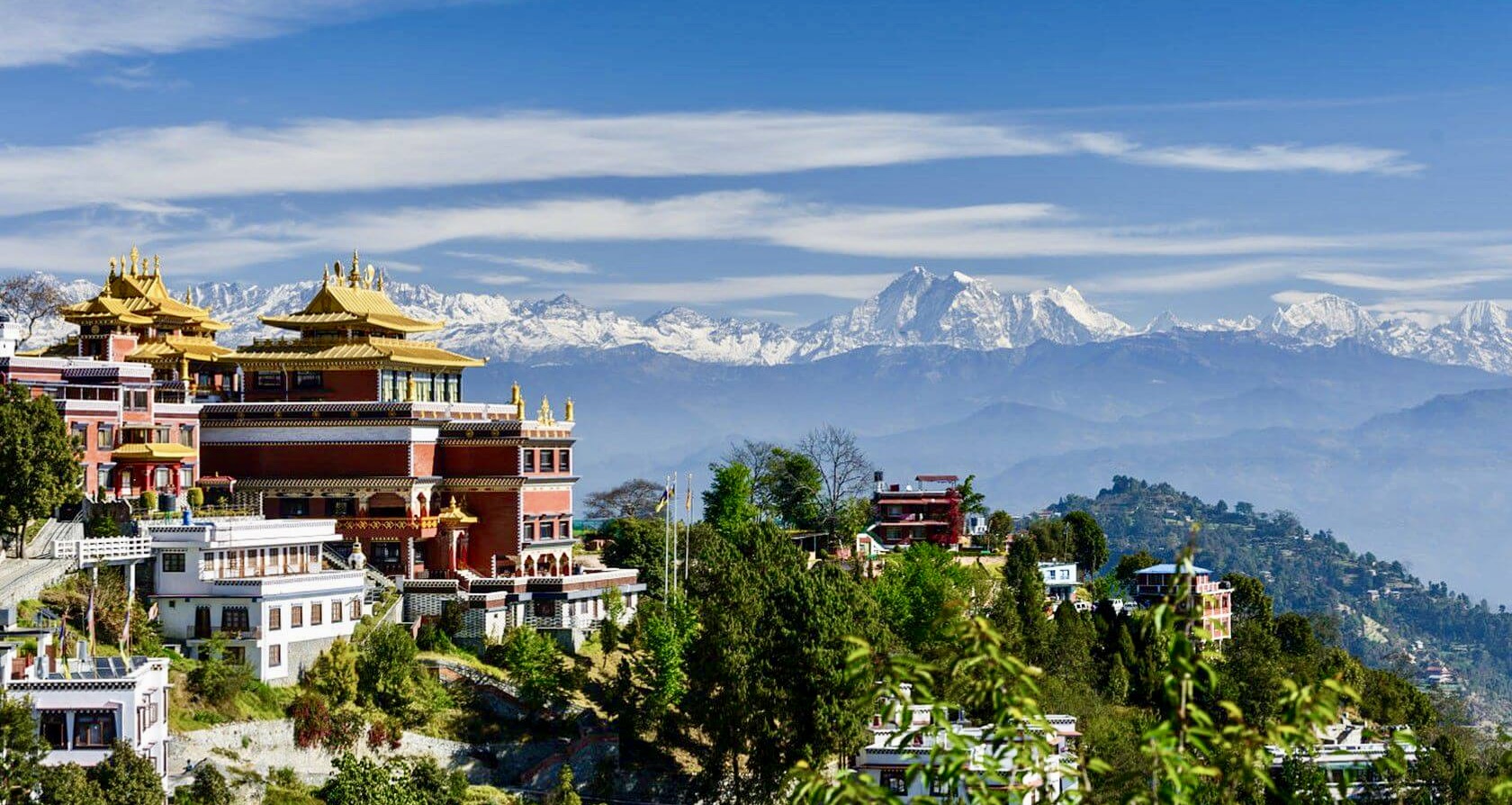
Bandipur: A Step Back in Time
Day 1: arrival and exploring bandipur.
Upon arrival in Bandipur, you'll instantly be transported back in time with its well-preserved Newari architecture and traditional charm. Spend your day exploring the town and immersing yourself in its unique ambiance.
- Discover Bandipur Bazaar: Begin your exploration in the heart of Bandipur, its historic bazaar. Stroll through the narrow, cobblestone streets lined with beautifully preserved Newari buildings, traditional shops, and ancient temples. Take in the sights, sounds, and flavors of this charming town.
- Bindabasini Temple: Visit Bindabasini Temple, a significant religious site in Bandipur. The temple is dedicated to the Hindu goddess Durga and offers panoramic views of the surrounding hills and valleys.
- Tundikhel Viewpoint: Hike up to Tundikhel, a viewpoint that offers breathtaking panoramic views of the Himalayan ranges, including Manaslu, Ganesh Himal, and Langtang. Enjoy the serene beauty of the mountains and soak in the tranquility.
Day 2: Siddha Cave and Hiking Trails
On your second day in Bandipur, venture beyond the town and explore the surrounding natural wonders.
- Siddha Cave: Embark on a short trip to Siddha Cave, one of the largest caves in Nepal. Explore the mystical underground chambers, admire the stalactites and stalagmites, and learn about the geological formations.
- Ramkot Village Hike: Take a hike to the nearby Ramkot Village, passing through terraced fields, quaint settlements, and lush forests. Enjoy the scenic beauty and immerse yourself in the rural charm of the region.
Nagarkot: Majestic Mountain Views
Day 1: arrival and sunset at nagarkot.
Upon arrival in Nagarkot, you'll be greeted by awe-inspiring mountain vistas and a serene atmosphere. Spend your day relaxing and immersing yourself in the natural beauty of the area.
- Enjoy Sunset Views: Nagarkot is famous for its breathtaking sunrise and sunset views over the Himalayas. Find a cozy spot, perhaps at your hotel or at one of the viewpoints, and witness the golden hues illuminating the snow-capped peaks.
- Explore the Surroundings: Take leisurely walks around Nagarkot and enjoy the fresh mountain air. Marvel at the panoramic views of the Himalayan range, including Everest, Annapurna, Manaslu, and Ganesh Himal.
Day 2: Sunrise and Hiking Trails
Wake up early to witness the magical sunrise casting a golden glow on the mountains.
- Sunrise Experience: Find a vantage point to observe the sunrise over the Himalayas. Watch as the first rays of light illuminate the majestic peaks, creating a mesmerizing spectacle.
- Hiking Options: Nagarkot offers various hiking trails for nature enthusiasts. Embark on a hike through the surrounding hills and forests, enjoying the tranquility and the stunning natural beauty along the way.
Add More Flavor to Your Journey
No travel experience is complete without indulging in the local cuisine and immersing oneself in the cultural delights of a destination. To enhance your journey in Nepal, it's essential to savor the unique flavors of Nepali cuisine, explore traditional markets, and engage in cultural activities. In this blog, we will guide you on how to add more flavor to your journey by experiencing local cuisine and cultural delights throughout Nepal.
Nepali Cuisine
Nepali cuisine is a delightful blend of flavors influenced by regional ingredients and traditional cooking techniques. Here are some must-try dishes:
- Dal Bhat: The quintessential Nepali dish, consisting of lentil soup (dal), rice (bhat), and a variety of side dishes like vegetables, curries, pickles, and papad.
- Momo: These steamed or fried dumplings filled with meat or vegetables are a Nepali favorite. Don't miss out on trying momos with spicy chutney.
- Newari Delicacies: Explore the Newari cuisine, known for its unique flavors. Enjoy dishes like Choila (spiced grilled meat), Bara (lentil pancake), and Samay Baji (a platter of beaten rice with various condiments).
- Juju Dhau: Treat yourself to Juju Dhau, a creamy and delicious yogurt unique to Bhaktapur. It's often enjoyed as a dessert or a sweet snack.
Traditional Markets
Venture into the vibrant traditional markets of Nepal to immerse yourself in the local culture and taste the authentic flavors. Here are a few markets to visit:
- Ason Bazaar (Kathmand u): Explore the bustling lanes of Ason Bazaar, filled with spice shops, colorful produce, traditional sweets, and local snacks. Take in the sights, smells, and flavors of the market.
- Boudha Bazaar (Kathmandu) : Visit Boudha Bazaar, surrounding the magnificent Boudhanath Stupa. Explore the stalls selling Tibetan handicrafts, prayer flags, incense, and traditional Tibetan food.
- Lakeside Market (Pokhara): Browse through the shops and stalls of Lakeside Market, offering a variety of souvenirs, clothing, and locally made handicrafts. Don't miss the opportunity to sample local snacks and sweets.
Cultural Activities
Immerse yourself in the rich cultural heritage of Nepal through engaging activities:
- Cultural Shows: Attend traditional cultural shows featuring vibrant dances like the Nepali folk dance, Newari dances, and cultural performances showcasing different ethnic groups.
- Henna Art: Get your hands adorned with beautiful henna art, a traditional form of body decoration. Experience this intricate art form and appreciate its significance in Nepali culture.
- Thangka Painting: Learn the art of Thangka painting, a traditional Buddhist art form. Join a workshop and create your own Thangka masterpiece under the guidance of skilled artisans.
- Homestay Experience: Opt for a homestay in a local village to immerse yourself in the daily lives of Nepali families. Participate in cooking classes, learn traditional recipes, and enjoy authentic home-cooked meals.
By adding the flavors of Nepali cuisine and engaging in cultural activities, you will elevate your journey to Nepal. Indulge in the diverse flavors of local dishes, explore bustling markets, and partake in cultural experiences to create lasting memories and truly embrace the essence of Nepal's culinary and cultural heritage.
So, how long to stay in Nepal? A minimum of two weeks will let you experience the major highlights. If you're keen on trekking and more in-depth exploration, plan for 3-4 weeks. Remember, these are rough guidelines - everyone's pace and interests vary. It's always a good idea to include buffer time for potential delays or spontaneous detours!
In Nepal, it's not just about the destination; it's also about the journey. Embrace the unexpected, relish the serenity, and let the diverse landscapes and rich culture create memories that will last a lifetime. Here's to your unforgettable Nepalese adventure!
Frequently Asked Questions on How Many Days to Spend in Nepal
Q: how many days should i spend in nepal.
A: The duration of your stay in Nepal depends on several factors, including your interests, available time, and the activities you wish to undertake. For a comprehensive experience, a minimum of 10-14 days is recommended to explore popular destinations like Kathmandu, and Pokhara, and go on a trek. However, even a shorter stay of 5-7 days can provide a glimpse of Nepal's cultural and natural wonders. Ultimately, it's best to plan according to your preferences and the specific regions and activities you wish to prioritize.
Q: Can I experience Nepal in just a few days?
A: While Nepal is a diverse and vast country, it is still possible to have a meaningful experience in just a few days. If you have limited time, focusing on specific areas such as Kathmandu and its UNESCO World Heritage Sites, or going on a shorter trek like Ghorepani Poon Hill Trek, can provide you with a taste of Nepal's culture and natural beauty. It's important to prioritize your interests and plan accordingly to make the most of your time.
Q: How many days should I allocate for trekking in Nepal?
A: The duration of a trek in Nepal depends on the specific route and difficulty level you choose. Popular treks like the Everest Base Camp Trek or Annapurna Circuit Trek typically require around 12-14 days. However, there are shorter treks available, such as the Ghorepani Poon Hill Trek or Langtang Valley Trek, which can be completed in 4-7 days. If you have the time and physical fitness, allocating more days for trekking allows for acclimatization and a more immersive experience.
Q: Is it necessary to acclimatize when trekking in Nepal?
A: Yes, acclimatization is crucial when trekking in Nepal, especially in higher altitude regions. It allows your body to adjust to the lower oxygen levels and helps prevent altitude sickness. Most trek itineraries include acclimatization days to ensure your safety and well-being. It's important to listen to your body, drink plenty of fluids, and follow the guidance of your trekking guide to acclimatize properly.
Q: What is the best time of year to visit Nepal?
A: The best time to visit Nepal is during the spring (March to May) and autumn (September to November) seasons. These months offer stable weather, clear skies, and moderate temperatures, making them ideal for trekking and sightseeing. However, Nepal can be visited year-round, with each season offering unique experiences. Winter (December to February) provides opportunities for low-altitude treks and cultural exploration, while the monsoon season (June to August) brings lush greenery and is suitable for rainforest treks and cultural tours in the lower regions.
Q: Do I need a visa to enter Nepal?
A: Yes, most visitors to Nepal require a visa. You can obtain a visa on arrival at Tribhuvan International Airport in Kathmandu or at certain land border crossings. Some nationalities are also eligible for an e-visa, which can be obtained in advance online. It's important to check the visa requirements specific to your nationality and ensure that your passport is valid for at least six months beyond your intended stay in Nepal.
Q: Is it safe to travel to Nepal?
A: As of my knowledge cutoff in September 2021, Nepal is generally safe for tourists. Like any other place, travelers should be mindful of their surroundings and take precautions, especially against petty crimes such as pickpocketing in crowded areas.
Q: What should I pack for my trip to Nepal?
A: What to pack depends largely on your activities and the time of your visit. For trekking, bring good hiking boots, warm clothing, rain gear, a first aid kit, sunscreen, and water purifiers. For city exploration, comfortable shoes, modest clothing respecting local cultures, and a good map or guidebook are advisable. Also, don't forget essentials like travel documents, personal hygiene items, and any necessary medication.
Q: How difficult are the treks in Nepal?
A: The difficulty of treks in Nepal varies greatly depending on the trail. Treks like the Everest Base Camp or Annapurna Circuit are considered challenging and require good physical fitness. However, there are easier treks, like Ghorepani Poon Hill, suitable for beginners or those with limited time. Always ensure you're well-prepared and acclimatized to prevent altitude sickness.
Q: Can I use credit cards in Nepal?
A: Credit cards are accepted in many hotels, restaurants, and shops in major cities like Kathmandu and Pokhara. However, smaller establishments and remote areas might only accept cash. It's advisable to carry some local currency (Nepalese Rupees) with you.
Q: Do I need to hire a guide for trekking?
A: While it's possible to trek independently in some regions, hiring a guide is highly recommended, especially for less experienced trekkers. Guides can ensure safety, help with communication, provide valuable information about the area, and support the local economy.
5 days Nepal tour of Kathmandu and Pokhara
7 Days Nepal tour with Pokhara, Nagarkot, and Safari
8 Days Nepal tour with Pokhara, Rafting, and Safari
9 Days Nepal tour with Pokhara, Lumbini, and Safari
If you need any further information, please contact us by email: at [email protected] , Phone: at +977- 985 100 5129 ( WhatsApp )
- Is 7 days enough for Nepal
- Are 5 days enough for Nepal
- Is 1 week in Nepal enough
- Is 4 days in Nepal enough
- Is 2 days enough for Nepal
- How can I spend 3 days in Nepal
- Hidden Waterfalls around Kathmandu
- Best peaks for climbing in Nepal
Drop us a message

Mr. Shishir Banjara
Shishir Banjara is the founder of Luxury Holidays Nepal Pvt Ltd, a renowned luxury travel company, and also a highly esteemed professional blogger with a deep passion for exploring and promoting the beauty of Nepal. Having embarked on countless journeys throughout the country, Shishir has gained a wealth of firsthand knowledge and experiences that have shaped his understanding of Nepal's diverse landscapes, cultural heritage, and hidden gems. His extensive travels have taken him to remote villages, vibrant cities, majestic mountains, and tranquil valleys, allowing him to develop a profound insight into the intricacies and charms of Nepal. Through his blog, he shares captivating stories, insider tips, and breathtaking photographs, inspiring fellow adventurers and curious travelers to embark on their own remarkable journeys and discover the wonders that Nepal has to offer.
Blog by Categories
- Travel Informations 166
- Travel Planning Guide
How much does a trip to Nepal Cost?

How much money should you budget for your trip to Nepal?
- How much does a one-week trip to Nepal cost?
- How much does a two-week trip to Nepal cost?
- How much does a one-month trip to Nepal cost?
- Hostel Prices
- Hotel Prices
The Cost of a Trip to Nepal
For a trip to Nepal, you should plan for daily costs anywhere between $14 to $109. If there's two of you traveling, your daily expenses could range from $28 to $219. These price ranges are based on the average daily spending of $38 (NP₨4,997) per person which comes from the travel expenses of other visitors. These costs include food, accommodation, sightseeing activities, and getting around locally. Keep in mind, though, these figures can vary somewhat based on your individual travel style, level of luxury, and chosen activities. Destinations across the country, such as Kathmandu and Pokhara, might might vary somewhat from the overall average price, but they usually stick close to this range. Read on for a breakdown of travel typical expenses as well as a comparison of tour prices versus Independent travel.
If you're planning an Independent trip to Nepal, budget travelers should plan to spend around $14 (NP₨1,848) per day for their trip. This average includes hostels and budget hotels, affordable meal options, local transportation, and activities. If you're on a mid-range budget, plan for around $38 (NP₨4,997) a day which covers the cost of typical hotels, normal restaurants, and a variety of popular attractions. Luxury travelers should allow for $109 (NP₨14,472) a day, which would cover higher-end hotels, nicer restaurants, and more private tour options. All of these price ranges are based on our extensive travel cost data for Nepal from other travelers, along with hotel and tour data from travel companies.
How much does a one week trip to Nepal cost?
On average, visitors to Nepal spend between $98 and $766 for their week-long adventure, with the average being $265. This covers sightseeing, local transportation, food, and accommodations. With a duration of one week, you'll have the opportunity to explore one, two, or even three locations within Nepal, depending on the level of depth you desire for your visit. Some of the most popular places to consider exploring are Kathmandu and Pokhara . It's important to note that these figures are averages and can vary based on personal preferences and choices. Ultimately, the goal is to create a memorable and enjoyable experience tailored to your specific interests.
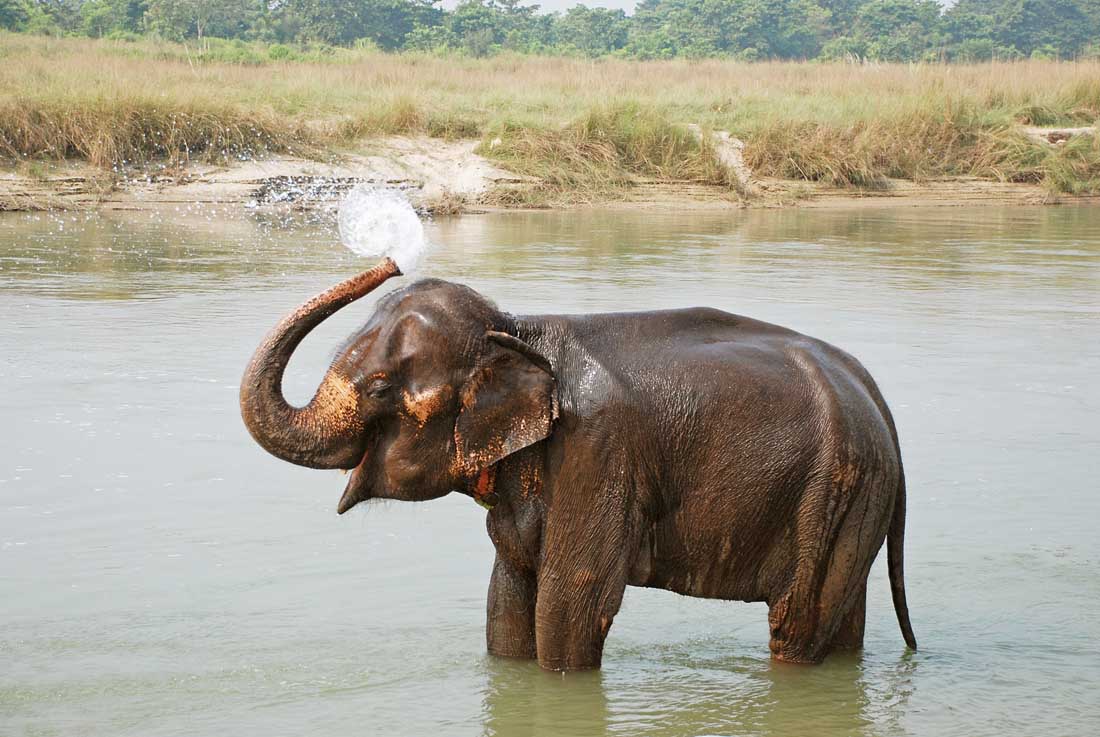
How much does a two week trip to Nepal cost?
With two weeks, you should budget between $196 and $1,533 for your trip to Nepal. The average price for a two week trip is $529. Two weeks will allow you enough time to visit between three and five places. If you're on a budget, you might want to consider some of the more affordable places such as Pokhara.
How much does a one month trip to Nepal cost?
When embarking on a month-long trip to Nepal, expenses can range from $419 to $3,284, with an average cost falling around $1,134. For those fortunate enough to have a full month, considering a vacation rental with a kitchen for at least a portion of your stay can help save money with meals. Backpackers often opt for hostels due to their affordability and the added benefit of a social vibe.
Hostel Prices in Nepal
With more than 80 hostels in Nepal, the average price is $5 per night for a dorm bed. Hostels are a terrific option for younger independent travelers looking to save money while staying social during their trip. With many types of hostels, it can be overwhelming to sort out the best places, though. Our analysis of the hostels in Nepal not only found the average price, but also uncovered some surprises about the overall quality, amenities, and atmosphere of hostels in the region. You can see more details from our analysis about typical hostel prices in Nepal here .
Here are a few sample prices from popular hostels in Nepal.
- $6 for a dorm bed at Elbrus Home in Kathmandu more details
- $6 for a dorm bed at Kiwi Backpackers Hostel Pokhara in Pokhara more details
- $6 for a dorm bed at The Glasshouse Hotel in Chitwan more details
Hotel Prices in Nepal
You'll find a wide range of hotel options across Nepal. Below are prices for some of the destinations, and for more details see our analysis of hotel costs in Nepal .
Shambaling Boutique Hotel
Temple tree resort & spa pokhara.

Should you do an organized tour or travel independently in Nepal?
Organized tours and independent travel are essentially the two main ways to plan a trip to Nepal. Organized tours offer a convenient and hassle-free experience, with travel experts handling all the logistical details and the added benefit of an expert guide imparting valuable insights. This option is favored by those who appreciate the convenience and ease provided by tours that often include transportation and expert guides.
On the other hand, independent travel provides a different set of advantages, allowing for greater freedom and flexibility in customizing itineraries and exploring at one's own pace. This option appeals to individuals who value spontaneity and control, enabling them to immerse themselves in local culture on a deeper level.
Ultimately, the choice between organized tours and independent travel depends on personal preferences and travel style, considering factors such as convenience, guidance, and flexibility.
Comparing Trip Costs in Nepal
When we compare the prices of organized tours to the average costs of independent travelers, we can see that sometimes the prices are fairly even.
Tours vs. independent Travel: Pros & Cons
Organized tours.
- An expert guide familiar with the culture
- Convenient transportation
- Fellow travelers to socialize with
- Well researched activities
- Efficient and thought out itinerary
- The security of have a trip leader if something goes wrong
- Limited options
- Usually not customizable
- The fast pace often means you can’t visit one place in depth
- Usually more expensive than independent travel
- There may be limited time to interact with the local culture and community
Independent Travel
- Completely customizable
- Opportunity to visit off-the-beaten-path destinations
- Can fully immerse yourself in the local culture
- Freedom to move at your own pace
- Flexibility to change your itinerary at any time
- More affordable
- Challenging to plan an efficient itinerary
- Transportation may be challenging or inefficient
- Booking and trip planning can be a hassle
- Popular sights may sell out well in advance
- If something goes wrong, you're on your own
Are organized tours more expensive than independent travel in Nepal?
Organized tours typically average around $157 per day and provide the convenience of an all-inclusive package with one comprehensive payment. On the other hand, independent trips usually average around $38 (NP₨4,997) per day and involve individual payments for accommodations, local transportation, meals, and sightseeing. Both organized tours and independent trips have their own unique challenges and benefits, so it's crucial to thoroughly understand the aspects of each to make a fair comparison. For a detailed analysis of tour prices in Nepal, check out our comprehensive guide on tour prices in Nepal here .
Here are a few sample tours in Nepal:
- Classic Annapurna Circuit Trek ($1,350) 18 days, 22 destinations more details
- Upper Mustang Trek ($3,000) 14 days, 15 destinations more details
- Sleeping at Everest Base Camp Trek ($4,590) 17 days, 13 destinations more details
- Nepal Helicopter Tour - 7 Days ($30,000) 7 days, 11 destinations more details
- Everest Base Camp Trek 7 Days ($2,999) 7 days, 9 destinations more details
More for Nepal
If you're planning a trip to Nepal, check out these other informative travel guides.
We've been gathering travel costs from tens of thousands of actual travelers since 2010, and we use the data to calculate average daily travel costs for destinations around the world. We also systematically analyze the prices of hotels, hostels, and tours from travel providers such as Kayak, HostelWorld, TourRadar, Viator, and others. This combination of expenses from actual travelers, combined with pricing data from major travel companies, gives us a uniqe insight into the overall cost of travel for thousands of cities in countries around the world. You can see more here: How it Works .
Subscribe to our Newsletter
Coupons and discounts! Travel tips!
1 Categories averaged on a per-item basis. 2 Categories averaged on a per-day basis. For example, the Food 2 daily average is for all meals for an entire day, while Entertainment 1 is for each individual purchase. Thus, the overall daily average cost is not a summation of the individual categories.
- You are welcome to reference or display our travel costs on your website as long as you provide a link back to this page .
- For a basic link, you can copy and paste the HTML link code, or this page's address. Address Link HTML Nepal Travel Costs " disabled />

Some of the links on this website are sponsored or affiliate links which help to financially support this site. By clicking the link and making a purchase, we may receive a small commission, but this does not affect the price of your purchase.
- Privacy / Terms of Use
- Activities, Day Trips, Things To Do, and Excursions

IMAGES
VIDEO
COMMENTS
Nepal in 3 weeks. Three week Nepal itineraries are designed with one main event in mind and that's getting up into the Himalayas on a trek. With three weeks to plan for, you can start in Kathmandu and spend a couple of days exploring the city before heading to Pokhara. After a few days in Pokhara, you'll be ready to set off on a trekking ...
The best time to visit Nepal is October through February. These months offer dry conditions, warm weather with lower humidity, and excellent opportunities to hike, climb, go on safari, and explore Nepal. Clear skies make a visit to Nepal so much more enjoyable, and with cooler conditions between October and February (a good portion of the dry ...
The high season (October-November) is the time to trek in perfect weather. Warm, dry weather and cloud-free skies make the October-November period the most popular time to visit Nepal, with ideal conditions for trekking and other outdoor thrills in the hills. The downside is you'll also find hordes of other travelers, including thousands ...
1. Kathmandu — Capital, Temples and Shrines. Kathmandu is the capital city of Nepal and the place where most travelers begin their journey. This is a city with chaotic narrow streets that are packed full of gorgeous temples and shrines. Explore the timeless cultural and artistic heritage to learn more about Kathmandu.
An under one week Nepal itinerary may be a crunch for time, but it's definitely possible. Start your week with a guided tour of Kathmandu that will take you to the city's most famous sites. Some things to see in Nepal, Kathmandu are Durbar Square and the holy places like Boudhanath/Bouddha, Pashupatinath temple complex, and the MonkeyTemple / Swayambhunath, which has an incredible 360 ...
Nepal visit 7 days itineraries (1 Week best tour of Nepal) Option 1: Cultural Exploration, Wildlife Safari, and Pokhara. Option 2: Cultural and Natural Beauty with a Short Trek. Option 3: Everest View Trek. Option 4: Annapurna Base Camp Trek. Nepal visit 8 days itineraries. Option 1: Kathmandu and Trekking.
When Is the Best Time to Visit Nepal? The best time to visit Nepal is from October to December as the weather is stunning during this period. The average temperature is 22℃ (72°F) by day and 12℃ (54°F) at night. Trekking, jungle safaris, and outdoor activities are all enjoyable during this period.
Planning Your Trip. Best time to visit: For most outdoor activities in most parts of the country, the best time to visit is from September to November, and from March to May. Winter (December to February) is comfortable at lower altitudes. Traveling during monsoon season (June to August) is not advised, except to areas in the Himalayan ...
From Kakarbhitta, you will get buses to Kathmandu (458 km) and Pokhara (600 km) Sunauli (India side)- Belahiya (Nepal side): The nearest main town is Varanasi. Belahiya is nearest to Lumbini (30 km). So if you are entering by this route, consider stopping at Lumbini first and then carry on your journey to Nepal.
The best time to visit Nepal is pre- and post-monsoon. That being said, there's heaps to do throughout the year and you're bound to have a brilliant trip no matter when you go. Here's our month-by-month guide to travel in Nepal. My Wishlist My Booking 1 800 970 7299
A great budget for 14 days in Nepal is around $1000 for a single person. Accommodation and food is cheap. Transportation could cost a bit more than its neighbouring country, but still good range. If you plan to stay in hostels, you can save even further and bring the budget down to $800 for backpackers.
Nepal through the seasons. The best time to visit Nepal is during the months of October and November. The monsoon is over, which means magnificent, green, lush vegetation as well as clean air - the perfect time to explore the country in all its beauty, especially given the mild temperatures. This is also the time the views of the peaks of the ...
Highlights: A hill hike, Namobuddha hike & culture mixed into one. Duration: 1 day+ hikes with 1 day+ of culture. Most of the short treks listed here are Pokhara based. Pokhara is a 7am - 2pm bus trip from Kathmandu (allow for an extra hour or so). Or a 30 minute flight. Or a 6 hour car trip.
Add diverse cultures, terrain, and ecosystems to the mix and you could easily spend several weeks exploring the picturesque Himalayan nation. However, in as little as three days, you can enjoy some of Nepal's highlights. To complete one of Nepal's famous treks, you typically need about two weeks. Nicole T. California, United States.
Momos (Photo Credit: Nepal Photography) 8. Food And Drink. Nepalese cuisine is absolutely delicious, and it's possible to have a filling and delicious meal for a few dollars. My favorites are momos, Nepal's version of dumplings, made with curry spices, ground meats, veggies, or cheese, and served steamed or fried.
The Best Time To Visit Nepal. The best time to visit Nepal depends on various factors such as weather, festivals, and activities you plan to do. There is such a huge range of things to do in Nepal and some quite distinct weather patterns. Here are the best times to visit Nepal based on different interests: Trekking
Visiting in Spring (March to May): Spring is another excellent time to visit Nepal, especially if you appreciate the vibrant colors of blooming rhododendrons and other wildflowers. The temperatures begin to rise, ranging from 12°C to 25°C (54°F to 77°F), and the days become longer, providing ample time for exploration.
Average Solo Traveler. The average cost for one person to visit Nepal for a week is $788-$2,183 ($113-$312 per day) Food, Travel, and Sightseeing: $22 to $45 per day for one person's daily expenses. Flights: $448 to $1,574 for economy. Lodging: $35 to $49 per night for one 2 or 3-star hotel room. or $31 to $38 per night for a 1-bed vacation ...
For slightly lower prices, visit in the March-April shoulder season, which still sees good weather for trekking and wildlife-watching. You can save even more money by traveling to Nepal in the winter, an excellent time for exploring warmer lowland areas such as the Terai. The cheapest time to visit Nepal is during the monsoon (roughly June ...
2.1K shares. Snowy mountaintops reaching into the sky. Gently bellowing yaks. Fluttering prayer flags. That was my mental image of Nepal before I visited. But now that I've been there, my new mental image of Nepal is quite different: shimmering lakes nestled in mountaintops. Dense, humming jungles. Bathing rhinoceroses.
A: The duration of your stay in Nepal depends on several factors, including your interests, available time, and the activities you wish to undertake. For a comprehensive experience, a minimum of 10-14 days is recommended to explore popular destinations like Kathmandu, and Pokhara, and go on a trek.
How much does it cost to travel to Nepal? You should plan to spend around $38 (NP₨4,997) per day on your vacation in Nepal. This is the average daily price based on the expenses of other visitors.. Past travelers have spent, on average for one day: $8.77 (NP₨1,167) on meals
With two weeks, you should budget between $196 and $1,533 for your trip to Nepal. The average price for a two week trip is $529. Two weeks will allow you enough time to visit between three and five places. If you're on a budget, you might want to consider some of the more affordable places such as Pokhara. When embarking on a month-long trip to ...